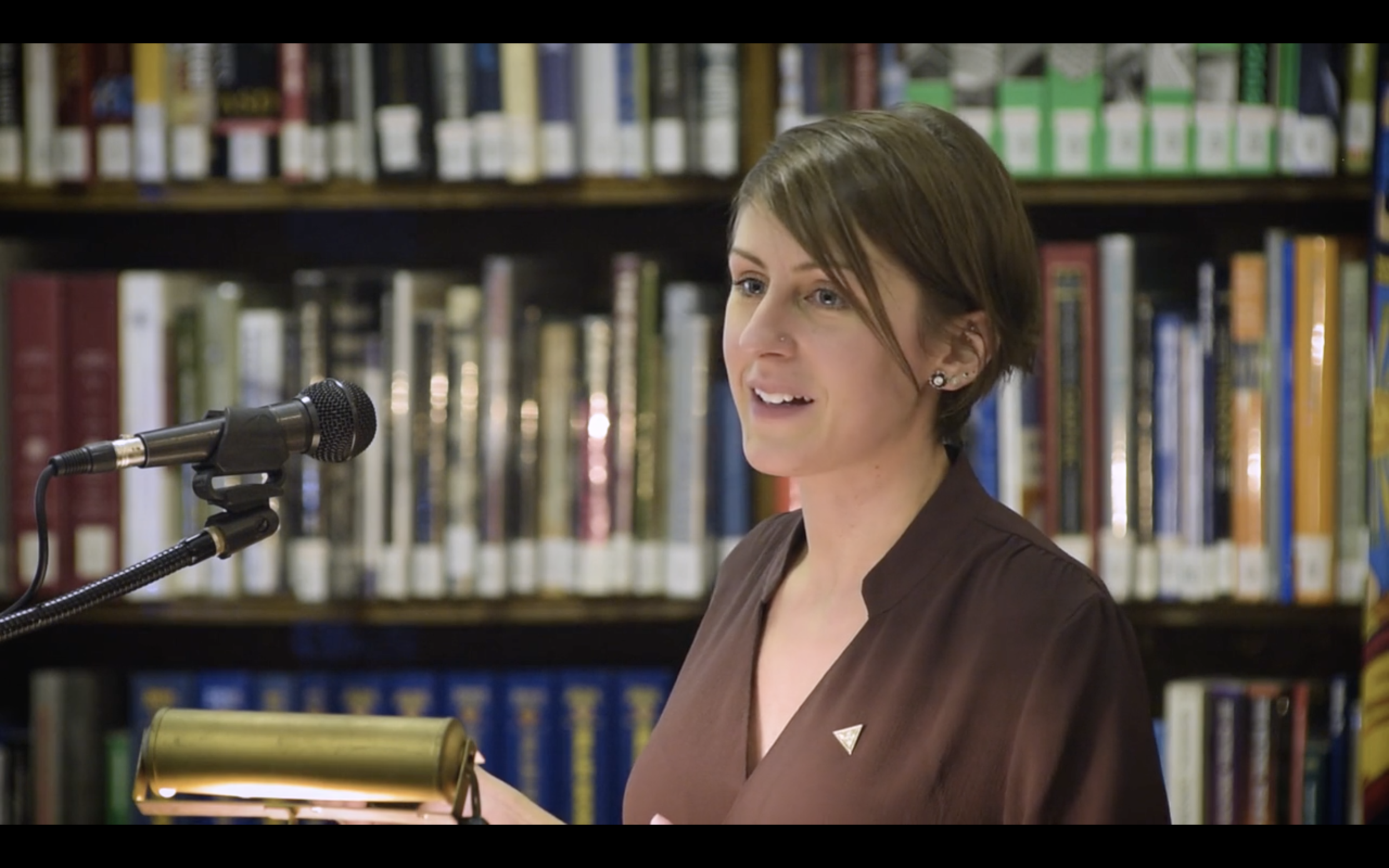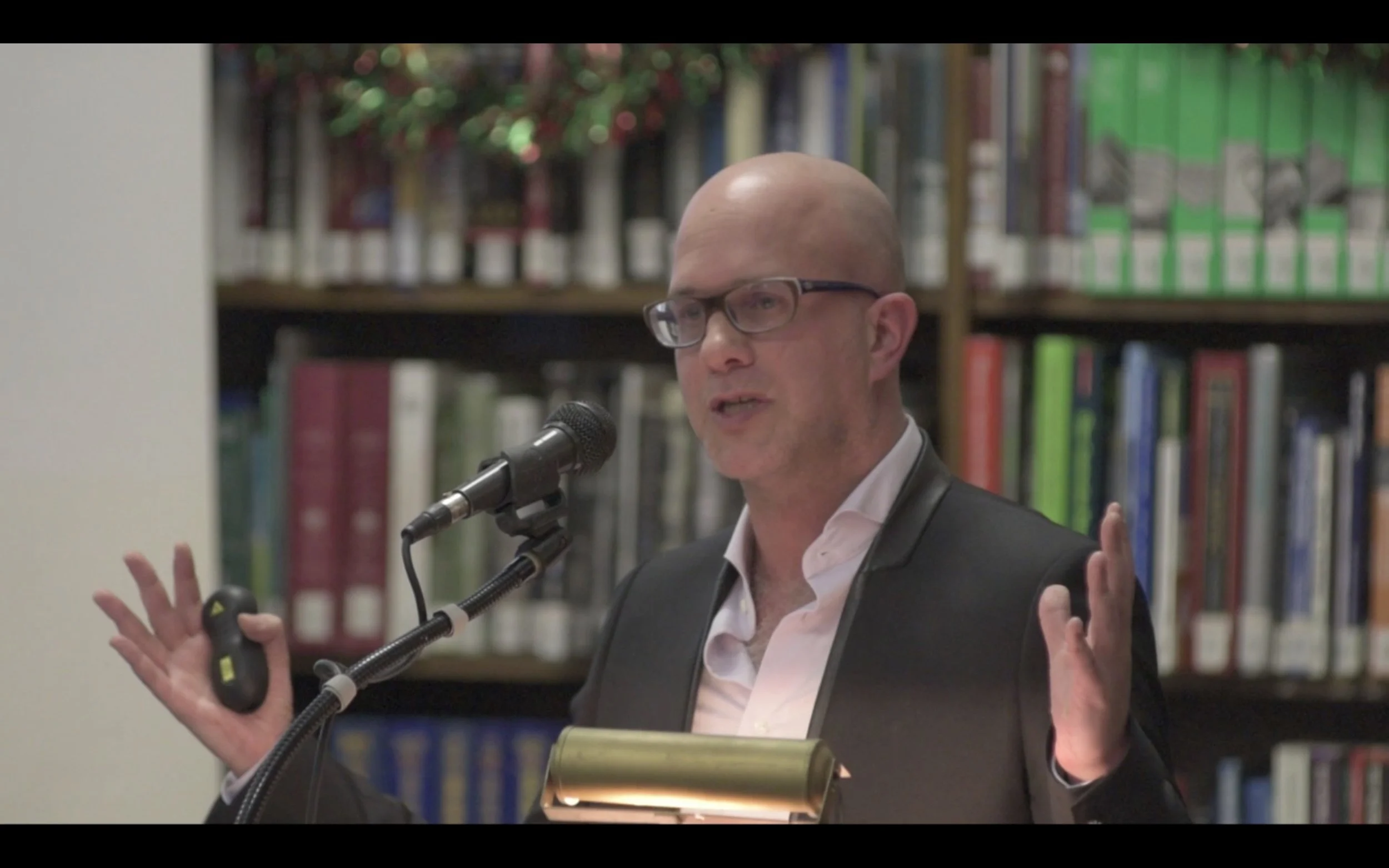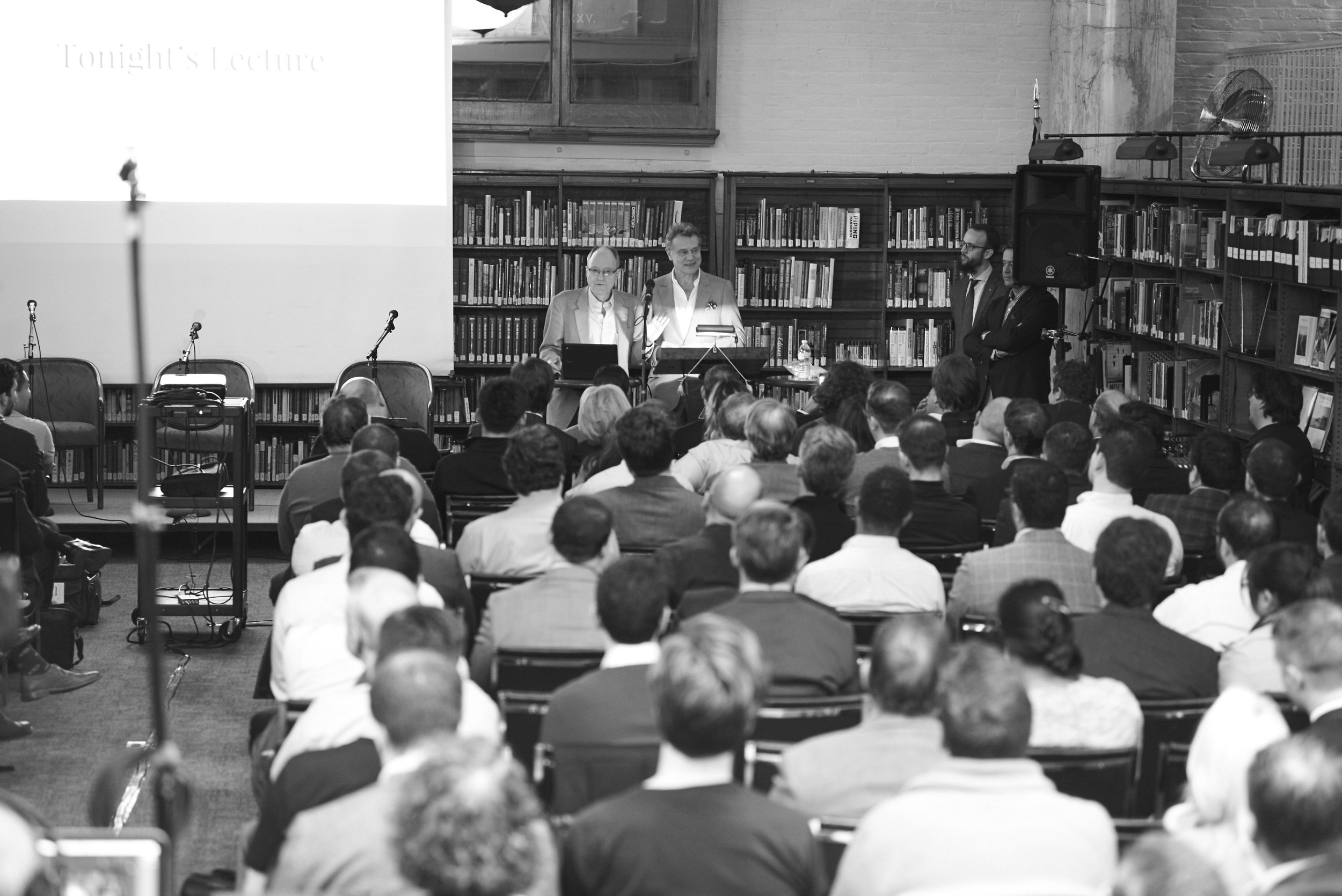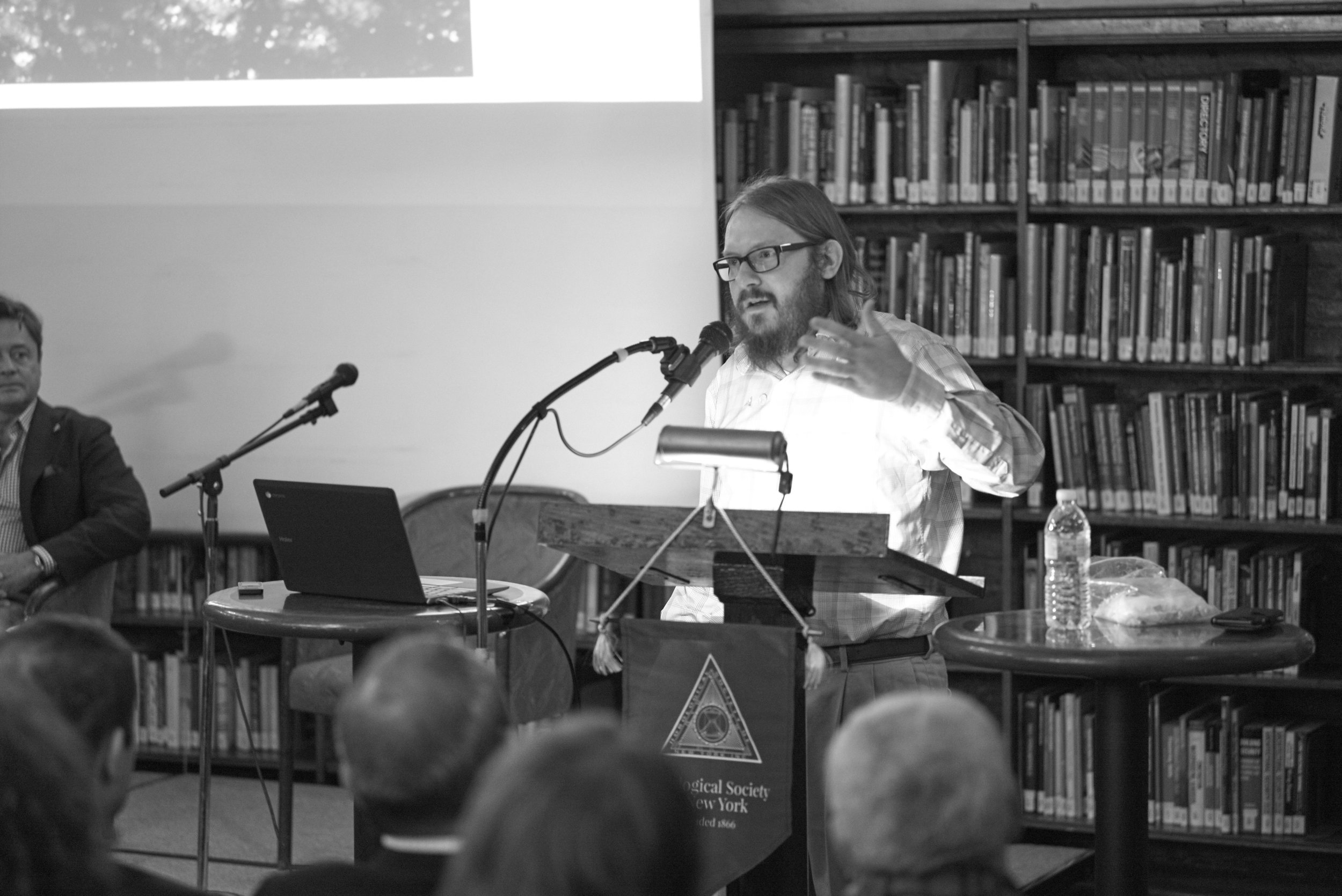The Horological Society of New York invites you to celebrate its 152nd year at the 2018 Gala and Charity Auction on Wednesday April 18, 2018. The annual Gala and Charity Auction is an opportunity to look back at our accomplishments, recognize talented watchmaking students, and bid on incredible watches and ephemera. More details will be announced soon. Early bird tickets are available only until January 31, 2018. Don't delay, reserve your tickets to HSNY's 2018 Gala & Charity Auction today!
2018 Executive Committee
HSNY's Board of Directors met recently to hold elections for 2018. After serving as Vice President for 2017, Michael Fossner resigned and nominated Luke Cox-Bien as his successor. Luke Cox-Bien was then elected Vice President by HSNY’s trustees. Luke Cox-Bien has been a member of HSNY for five years, and has held several executive committee positions. HSNY thanks Michael Fossner for his exemplary service. In addition, Brett Walsdorf, who serves as Director of Special Events, was elected Trustee.
Pictured above, Nicholas Manousos, President (left), and Luke Cox-Bien, Vice President (right). Photo by Atom Moore.
Meeting Recap: How I Learned to Stop Worrying and Love Radium Dials
Kathleen McGivney, COO, RedBar Group and Director of Operations, Horological Society of New York
November 7, 2017
Video recordings of meetings are available to HSNY members.
Many watch collectors own watches with radium dials - even seeking them out specifically. But do these watches present any dangers to the collectors who wear them? In her lecture to the Horological Society of New York on November 7, 2017, HSNY's Director of Operations and Red Bar's COO Kathleen McGivney delved into the history of radium dials and answered those pressing questions.
Radioluminescence, the process by which light is produced by bombarding a reactive material with ionizing radiation, was widely used as the demand for watches that were readable at night grew. Radium, discovered by the Curies (who coined the term “radioactivity”) in the 1890s, was ideal for that use due to its radioluminescent properties. Also, since radium was viewed at the time to have medicinal benefits (even touted to cure arthritis and high blood pressure), its potential deleterious effects were ignored… to deadly effect.
Starting in the 1910s, thousands of young women began working at factories devoted to producing watches with radium dials. They would dip their camelhair brushes into a solution of radium, and then moisten the tip of the brushes between their lips to give them a finer point. The “Radium Girls” churned out dials, knowing that the watches they painted would adorn the wrists of soldiers fighting “over there” in the First World War.
By the 1920s, the Radium Girls began to fall ill and die of wasting diseases that doctors attributed to their ingestion of the element, eventually filing lawsuits which led to the establishment of OSHA. Which brings us to the present day: since the watch industry used radium until well into the 1950s, many watches with radium dials survive. Are these watches dangerous to handle or wear? The short answer is no.
McGivney shared videos of readings she took with a Geiger counter from watches with radium dials. While all emitted some radioactivity, McGivney concluded that the exposure was not enough to harm the people who wear them. However, McGivney recommended that collectors store these watches in lead-lined pouches.
HSNY thanks Kathleen McGivney for her fascinating lecture!
Submitted by Christa Chance, Recording Secretary, HSNY

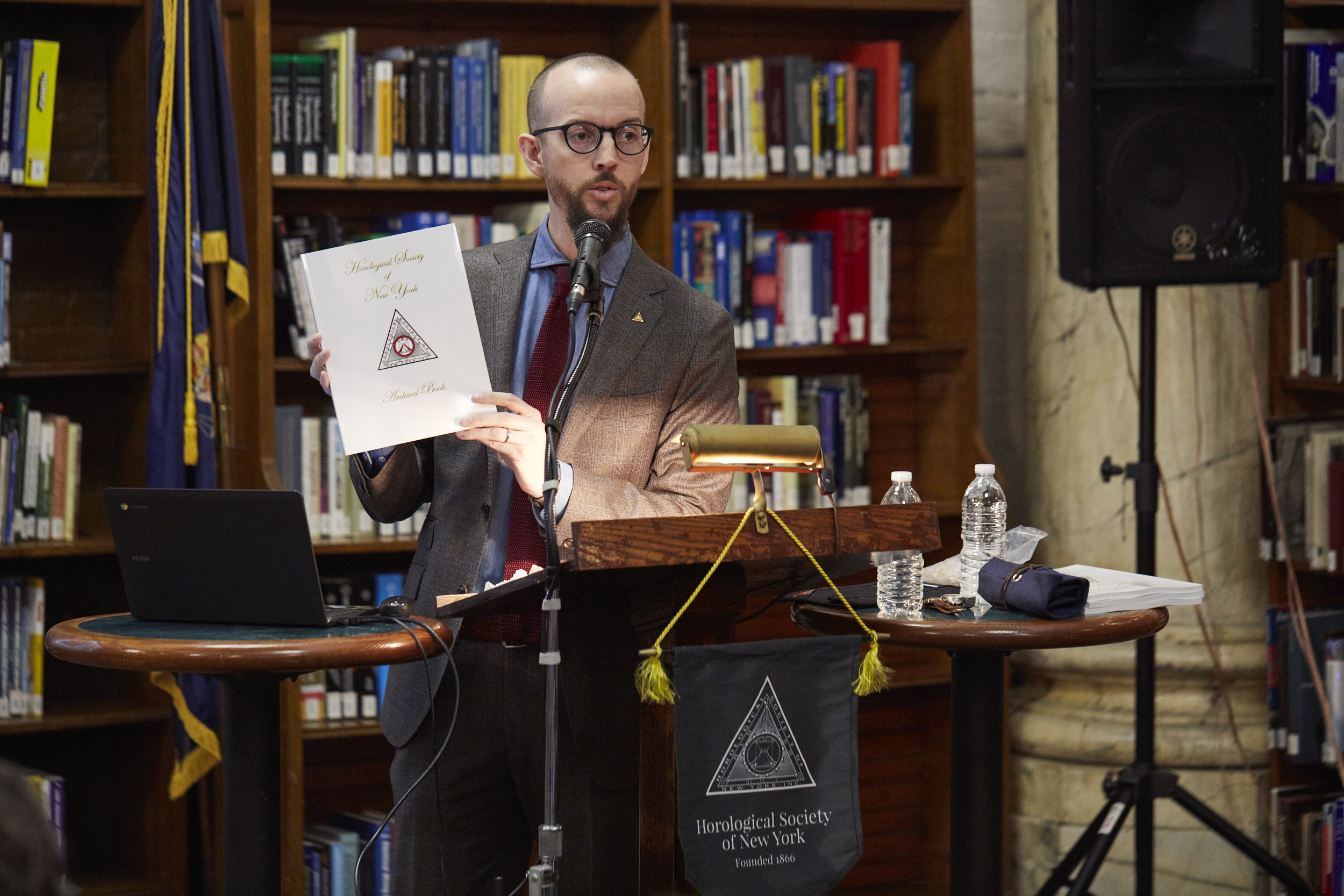
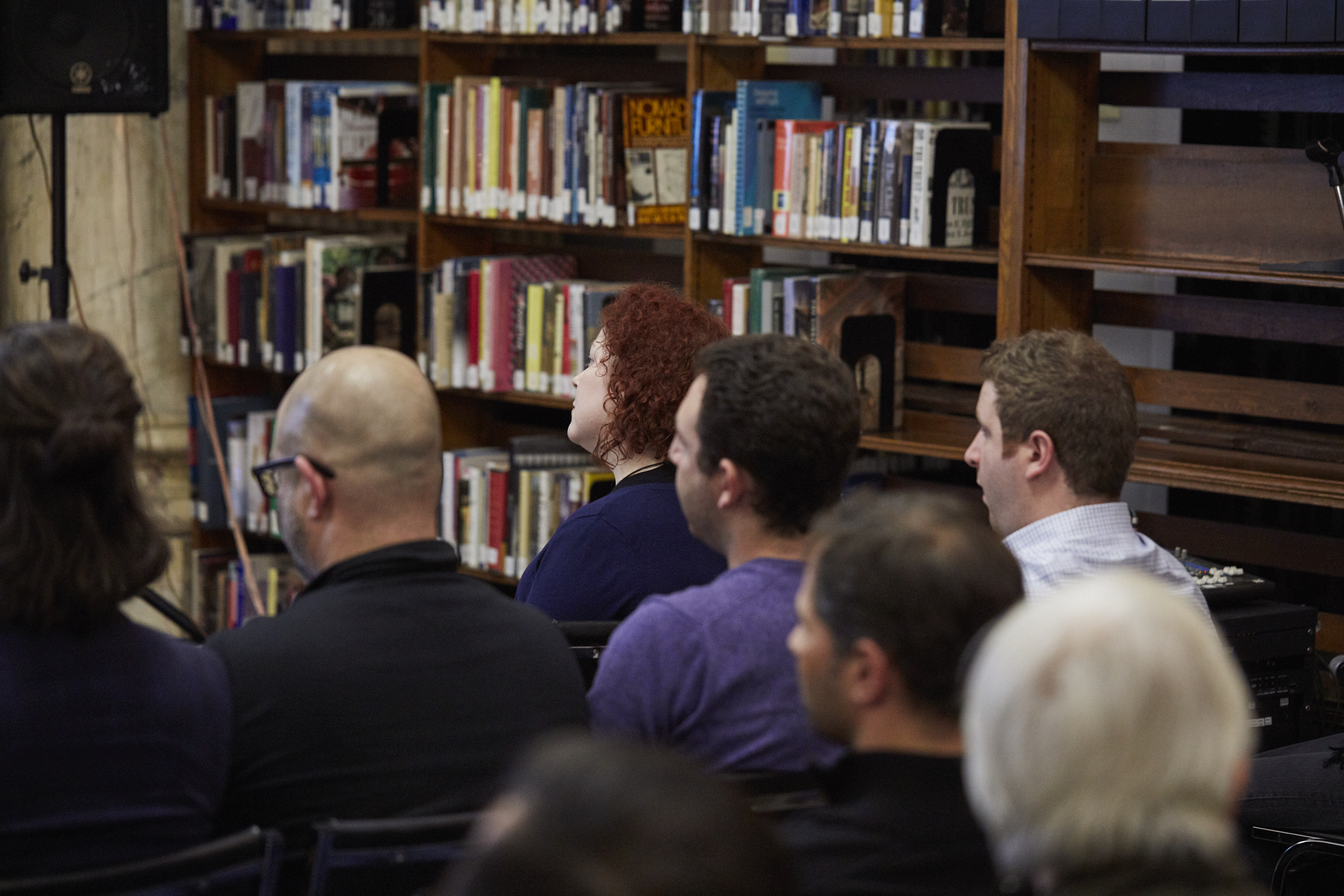
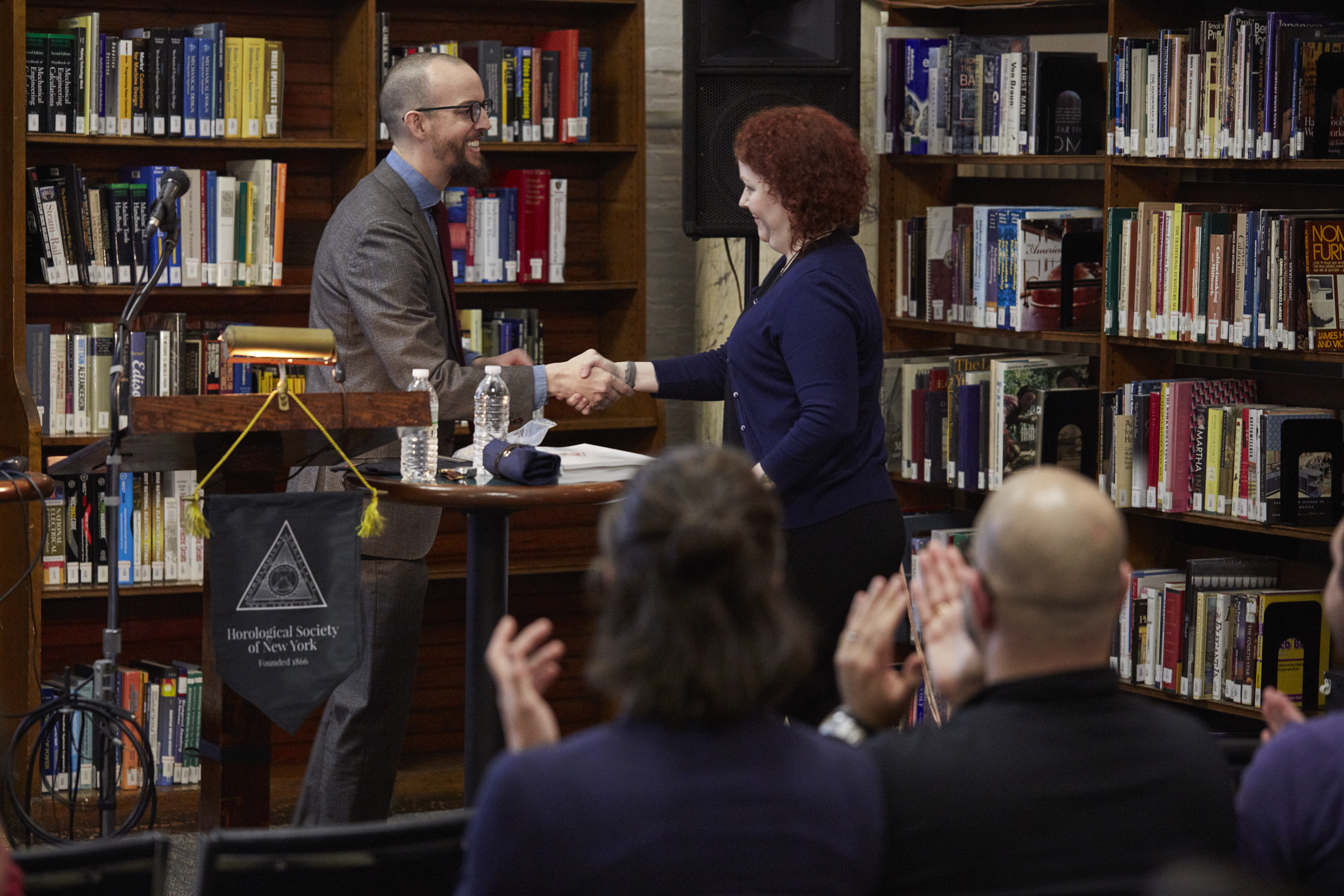
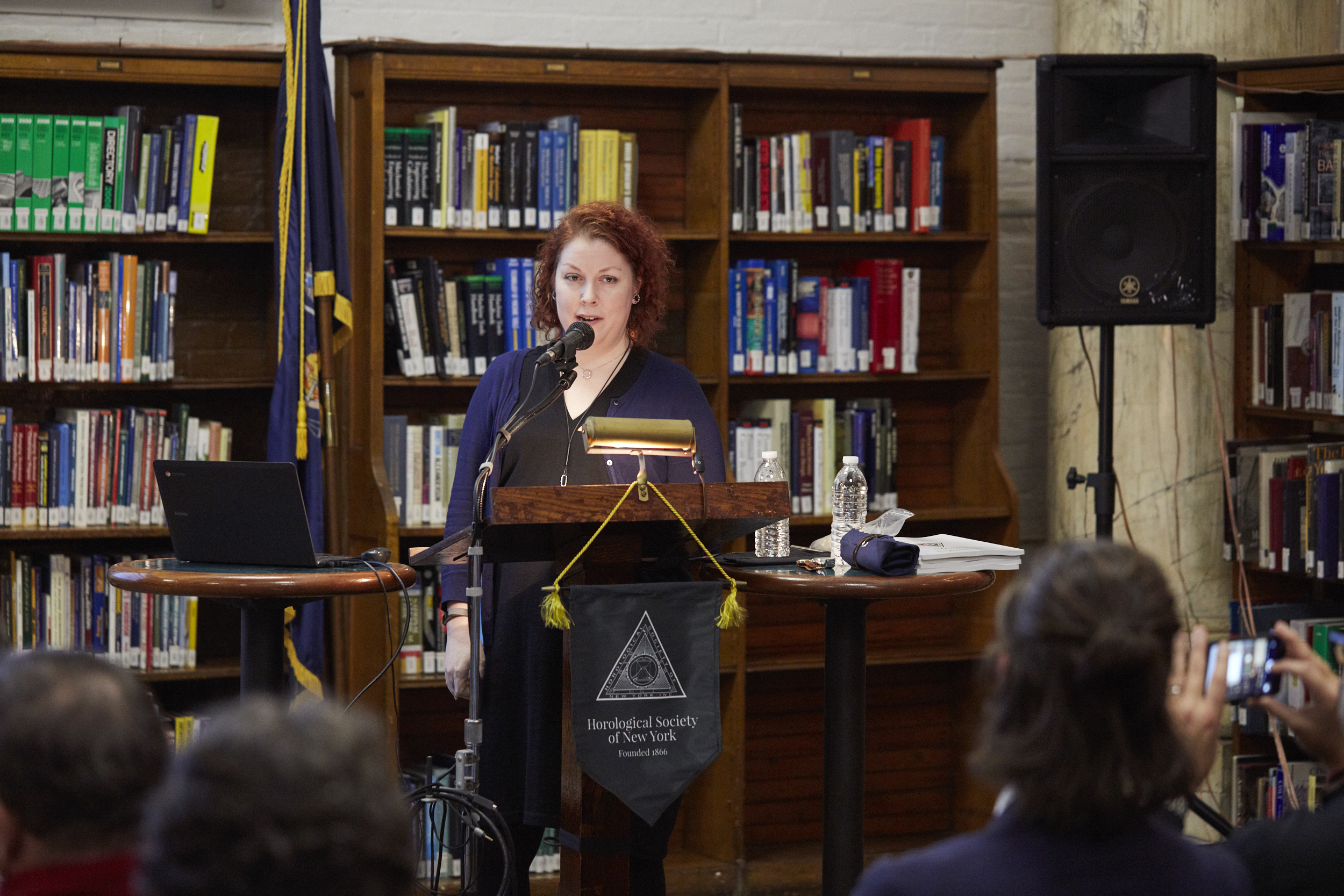
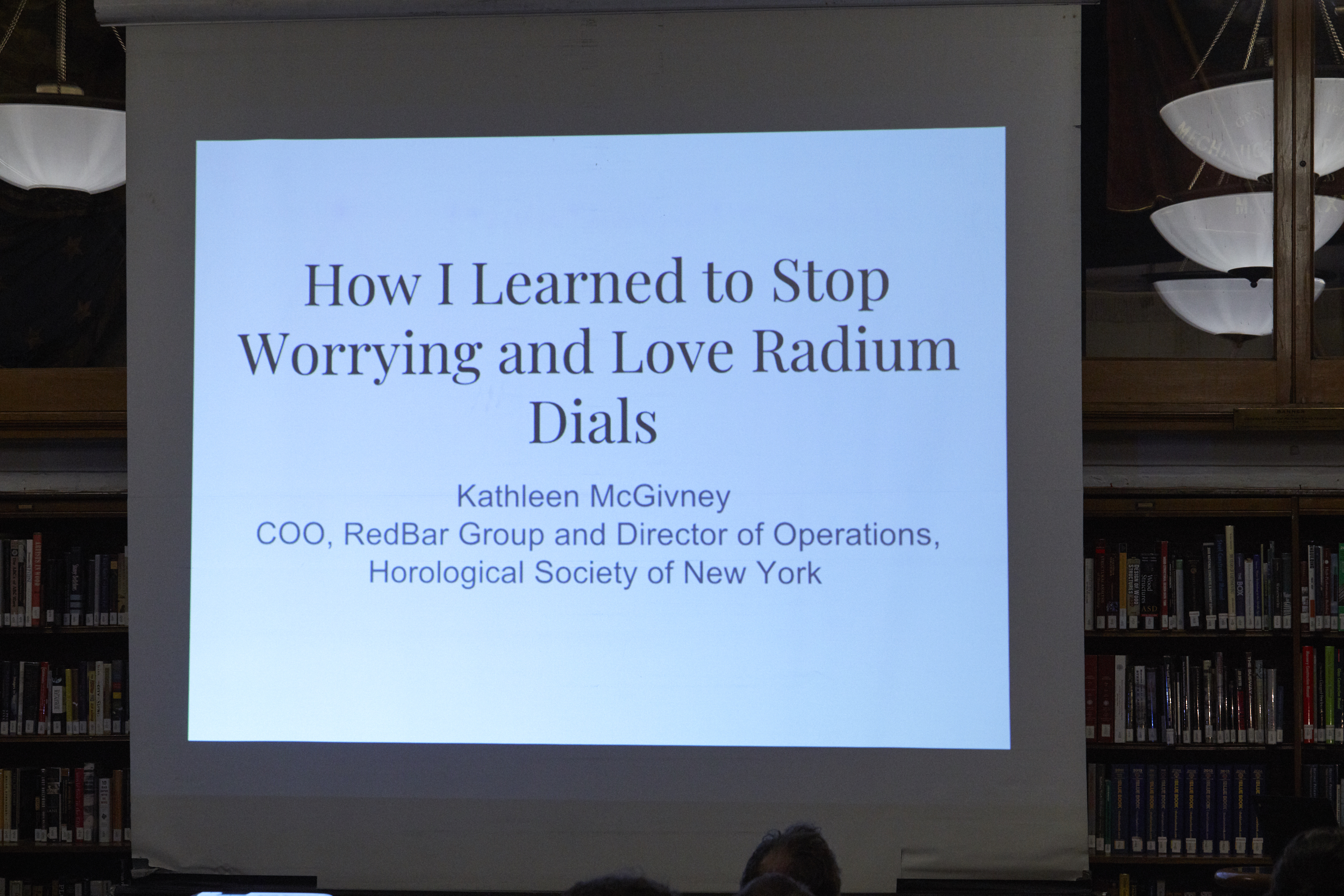
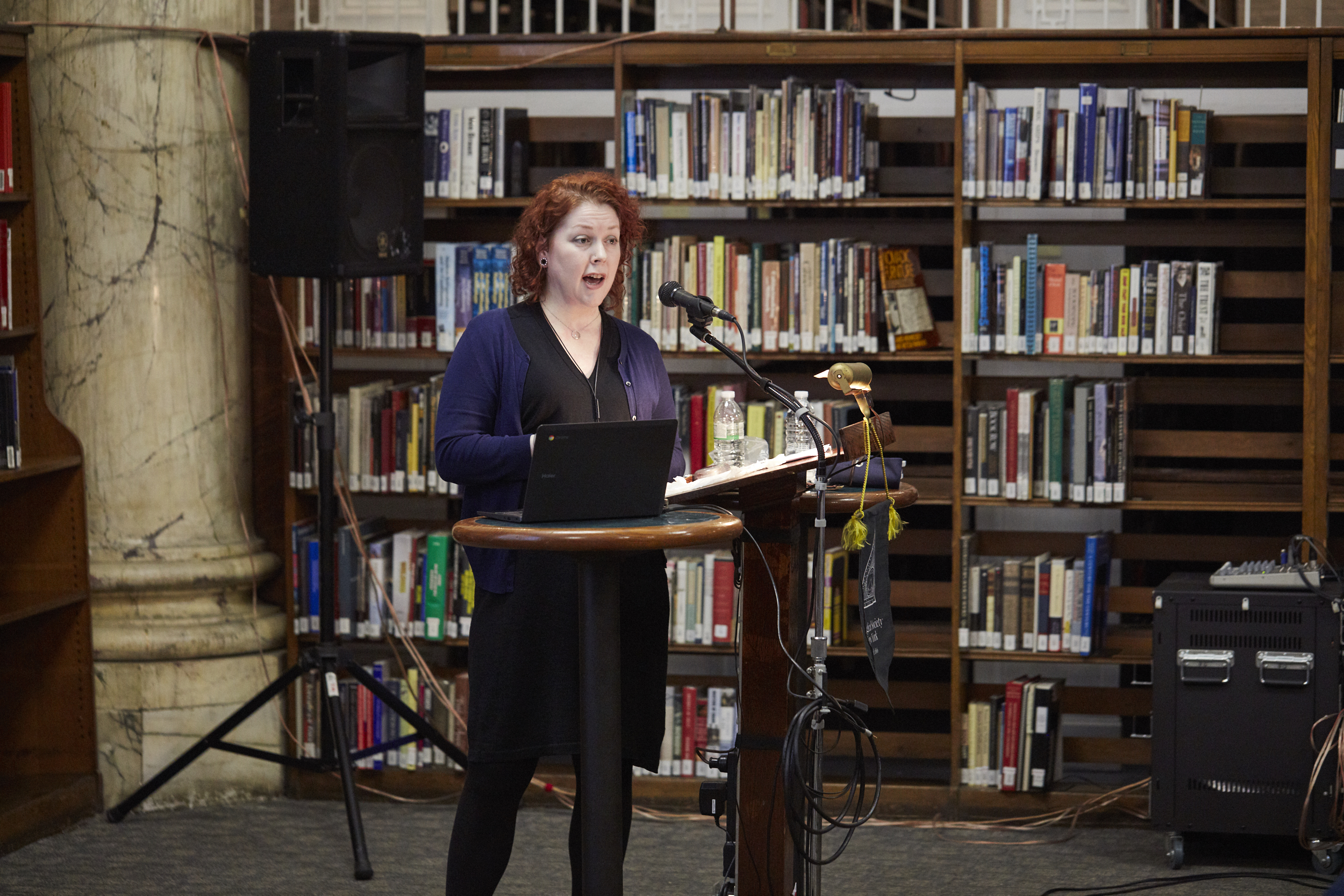

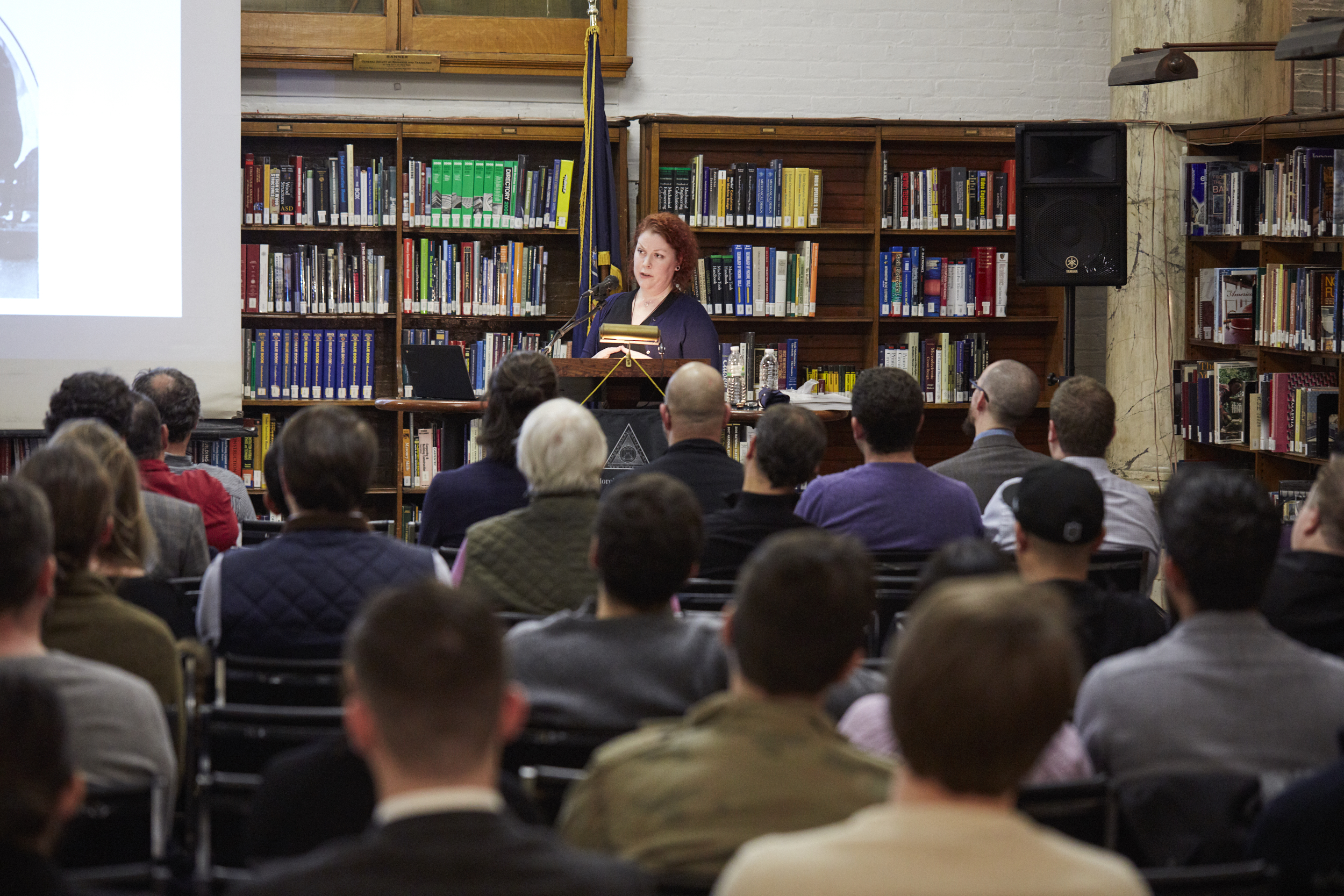

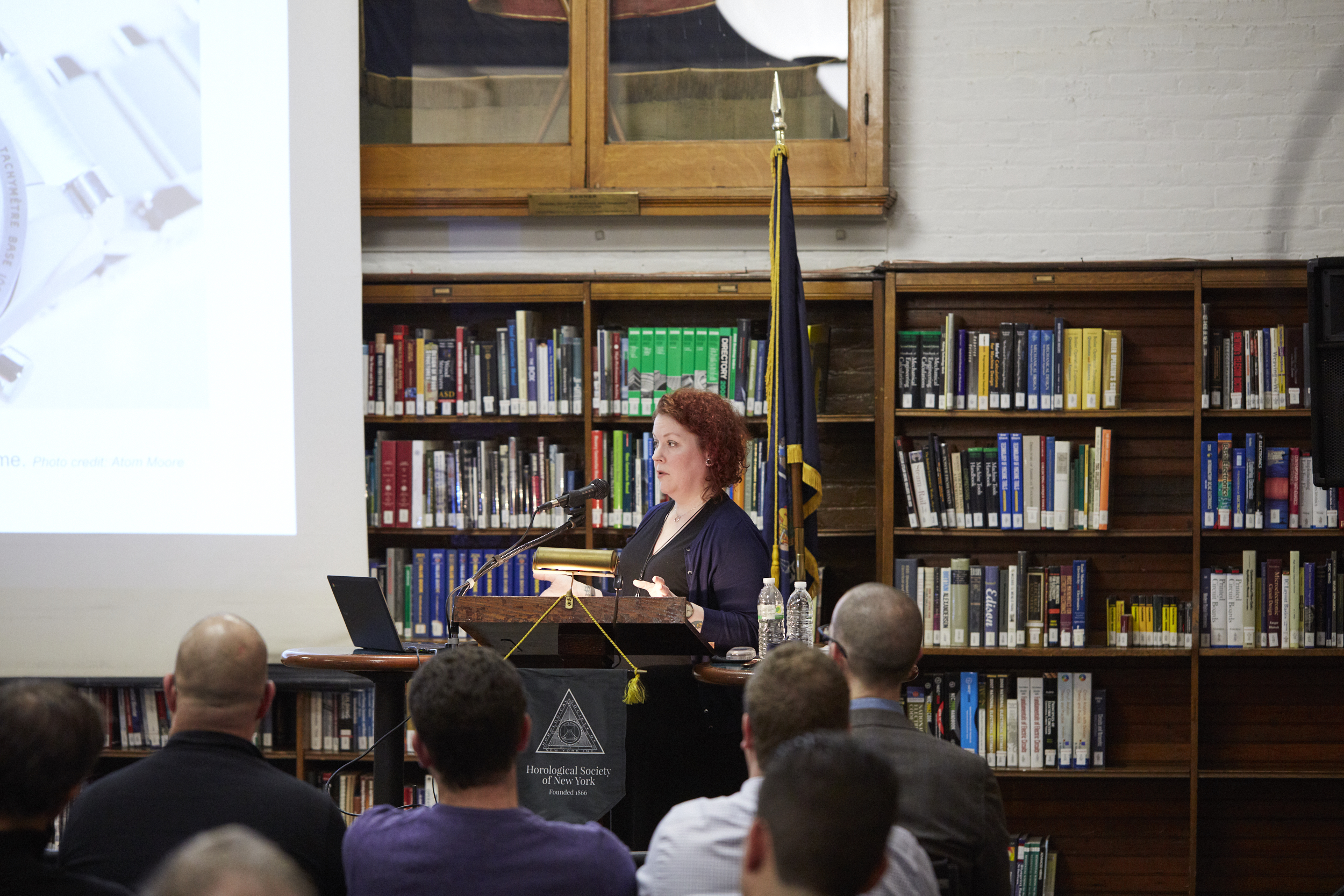
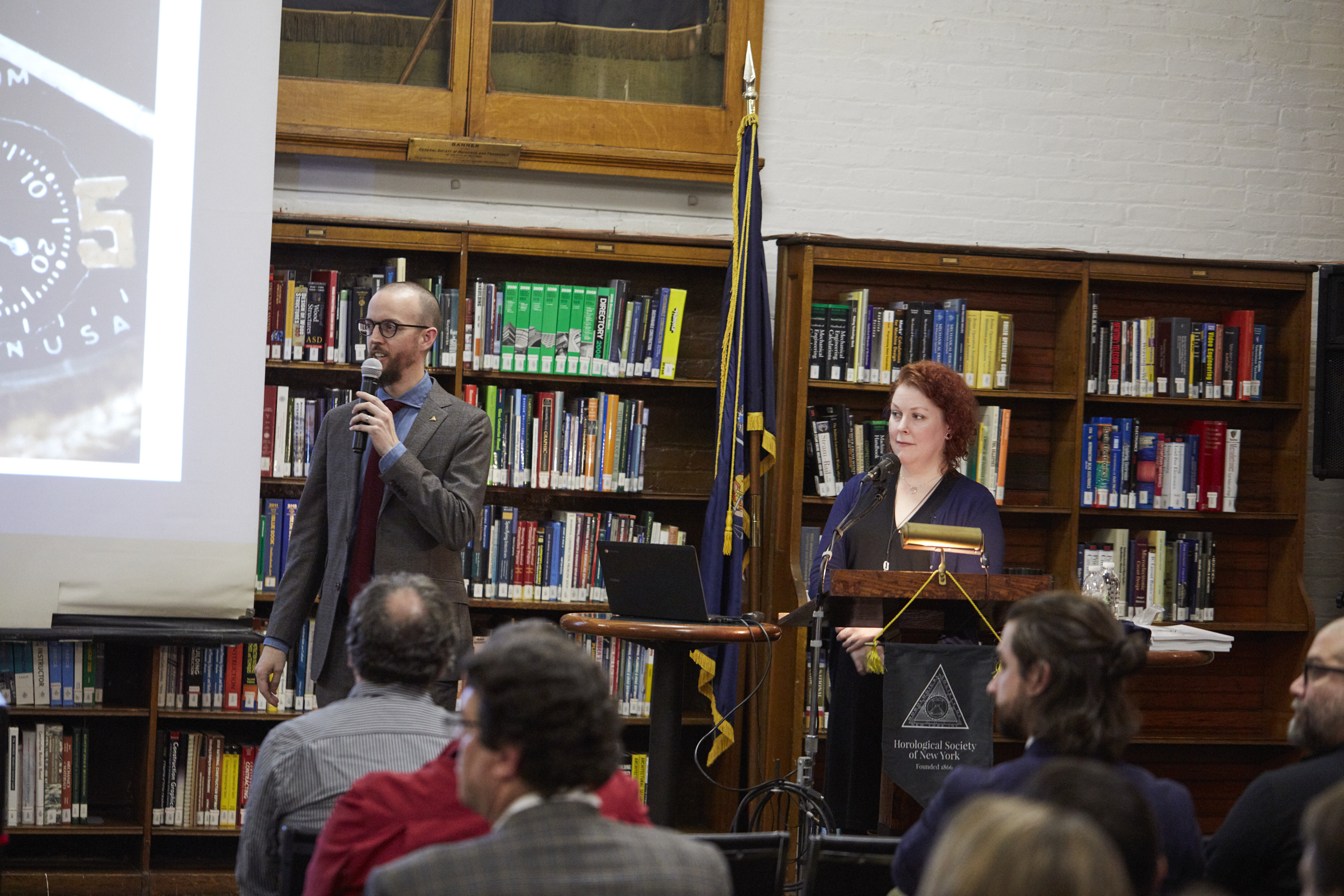
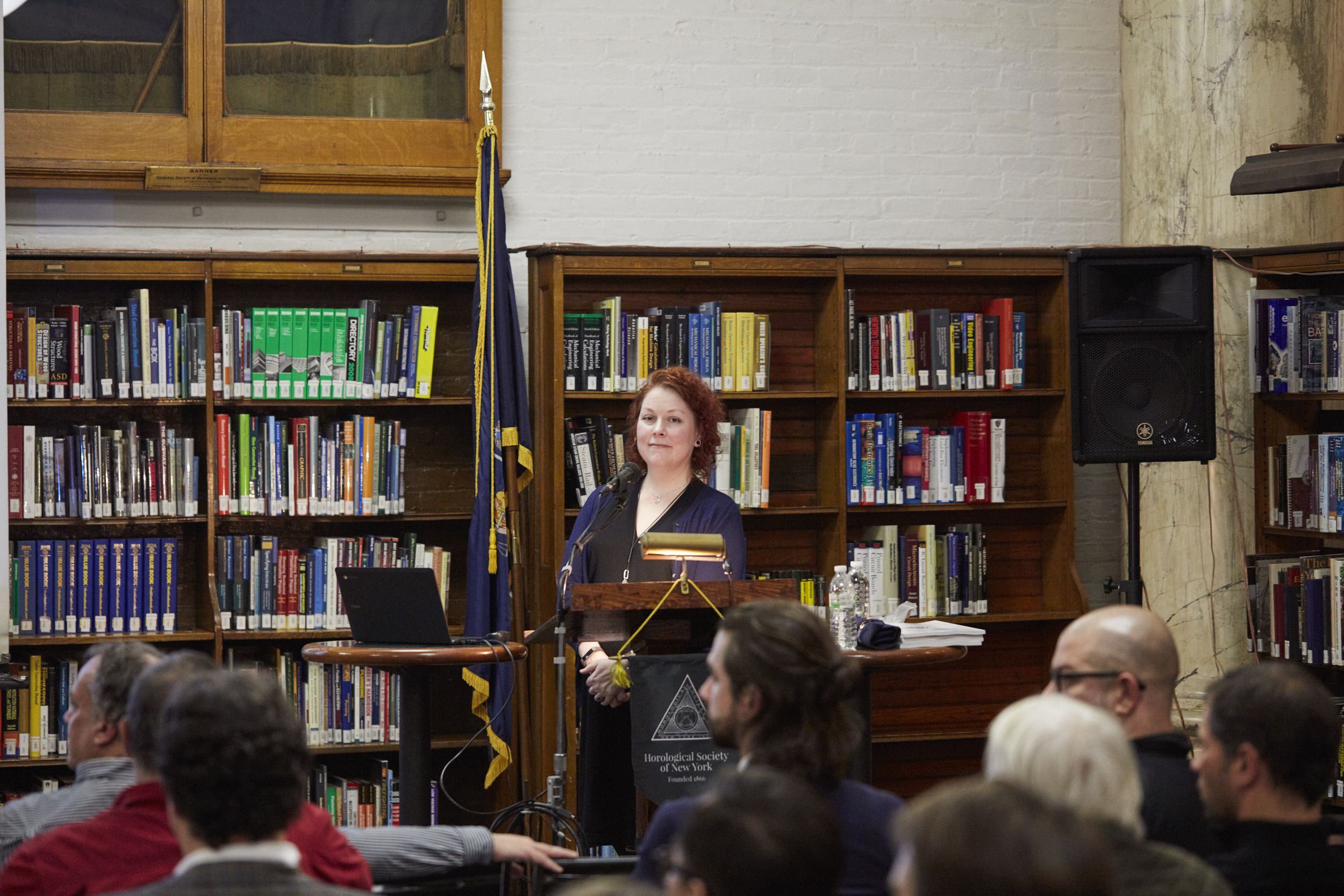

Meeting Recap: Fakes, Forgeries and the Birth of Mass Production in the European Watch Industry, 1750-1820
Dr. Rebecca Struthers FBHI FRSA Ph.D., Birmingham, UK
October 2, 2017
Video recordings of meetings are available to HSNY members.
Anyone who has visited Chinatown in New York has seen the thousands of “imitation” watches on offer. Though it might seem like a product of the age of mass-machining in which we live, such a concept is much older. In her lecture at the Horological Society of New York on October 2, 2017, Dr. Rebecca Struthers, FBHI, FRSA, PhD, Birmingham, UK, discussed her groundbreaking research on 18th-century “Dutch forgeries.”
London was the center of horology in the 18th century. This was the Golden Age of British Watchmaking. Watchmakers like Tompion and Mudge produced roughly 1,000 watches a year. But the emergence of a vibrant and hungry middle class in Britain meant that these master watchmakers—faced with heavy taxation on precious metals after the Napoleonic Wars—could not meet the demands that the middle class posed on them. However, watchmakers in Europe were not faced with the same economic structures. European watchmakers capitalized on the depression in England to flood the market with cheap watches, often using fictitious names—like Harry Potter.
These were called “Dutch forgeries” but, as Struthers pointed out, they were not Dutch made, nor were they forgeries of specific well-known makers like Mudge or Tompion. These watches imitated the Dutch style, often with scalloped edges on the dial, but with an inferior quality of metal and materials. Struthers used her past experience as a metalsmith to study the cases and came to the conclusion that they had been stamped and then soldered with lead, not cast as previously thought.
Since standardized mass manufacturing didn’t emerge until the mid-19th century in America, the fact that these watches were produced and then distributed in such large numbers is astounding. Their existence spoke of a novel and innovative redistribution of labor, allowing for over 40,000 watches to be produced in a year. These watches proved that cheap watches would sell because there was a market to buy them. This changed the face of horology forever, as portable accurate timekeeping was no longer only the province of the rich.
HSNY thanks Dr. Rebecca Struthers for her fascinating lecture!
Submitted by Christa Chance, Recording Secretary, HSNY


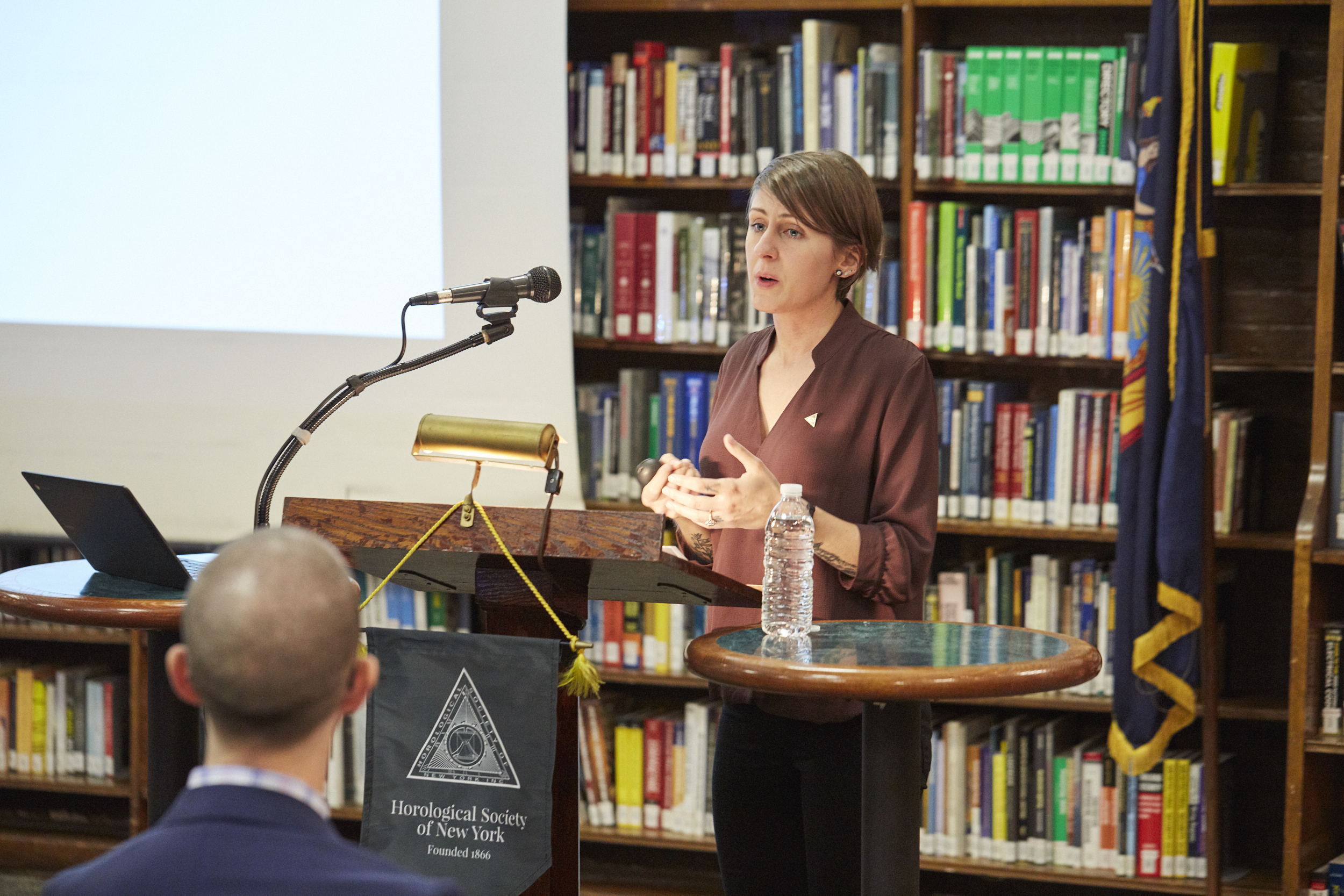
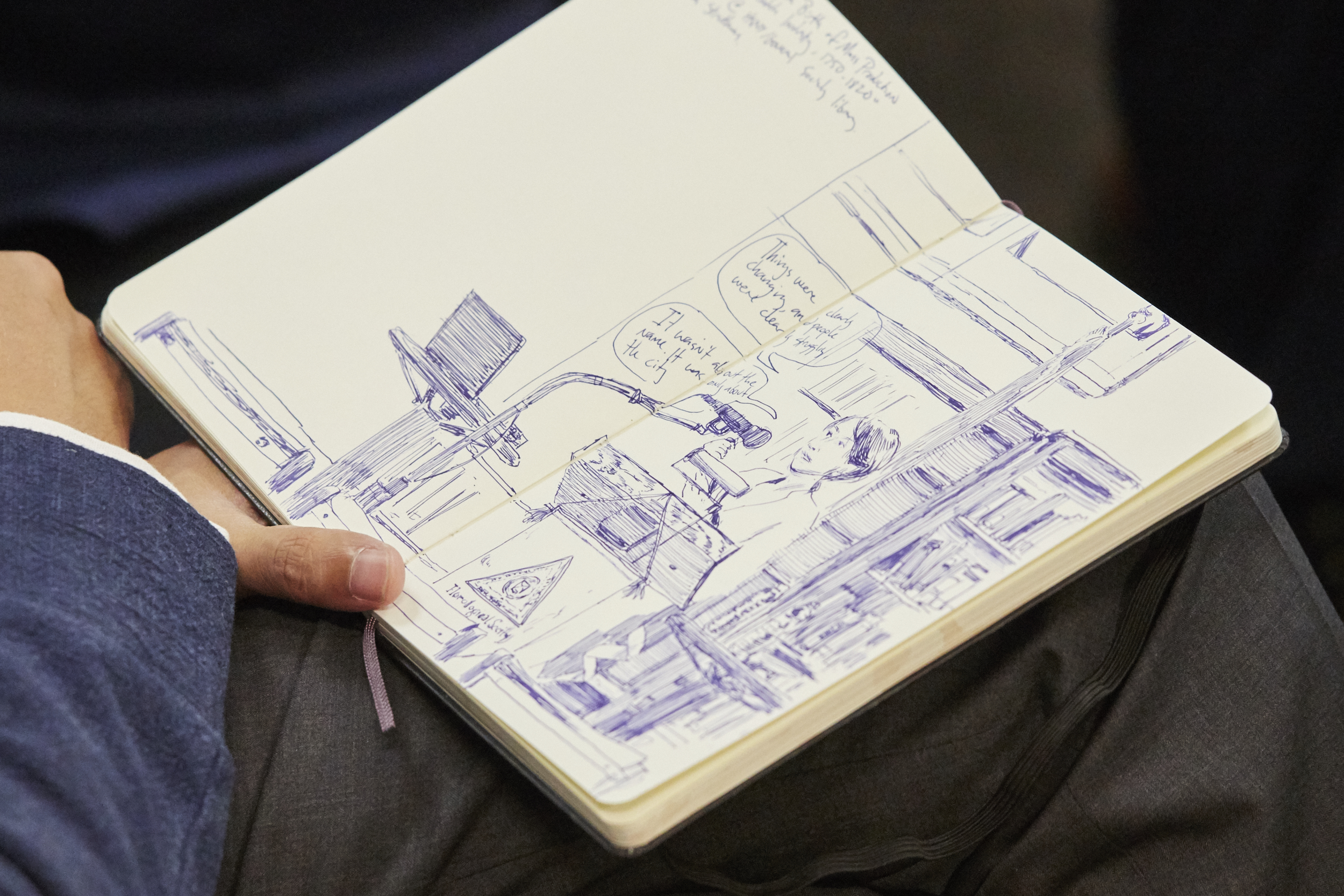


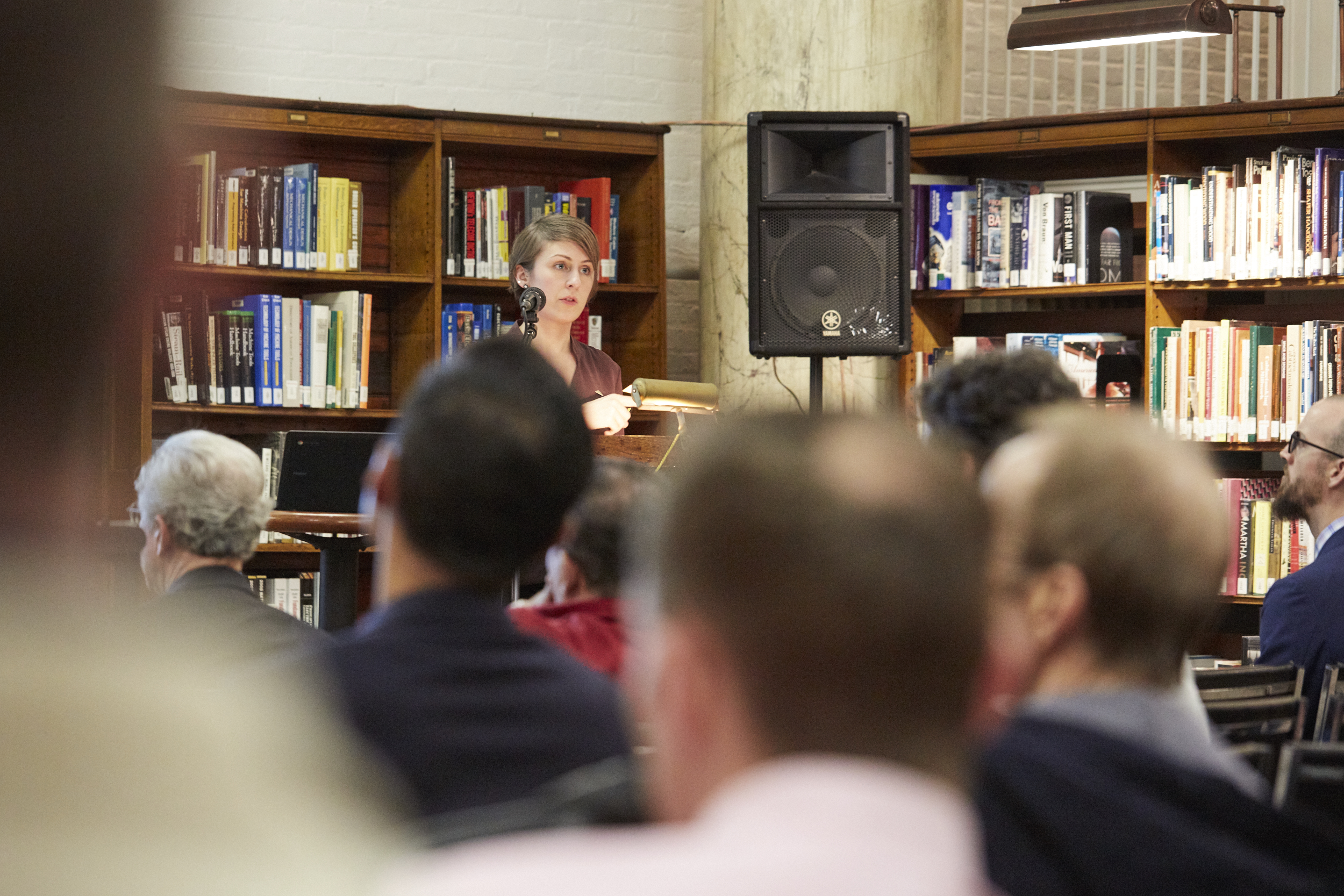
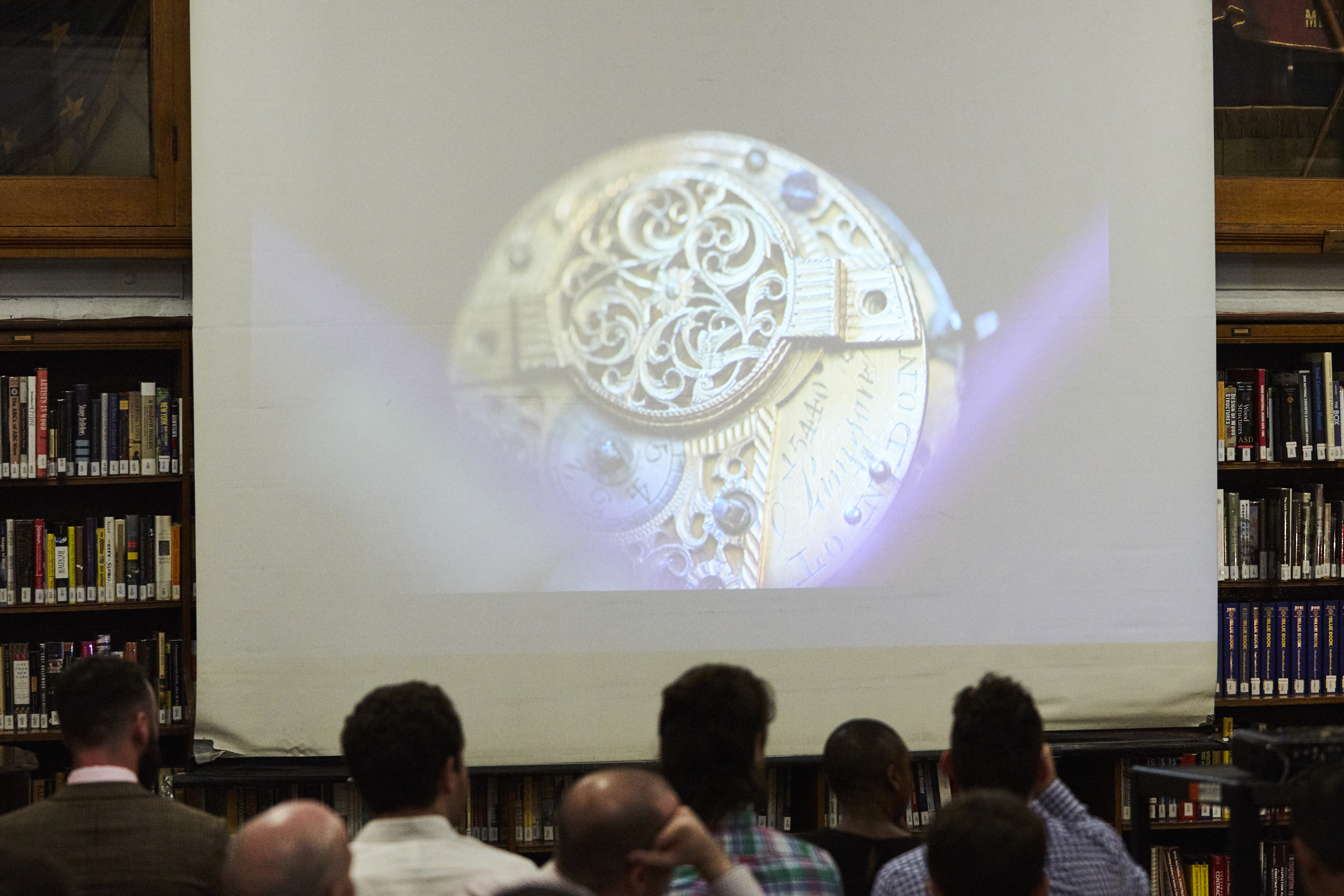
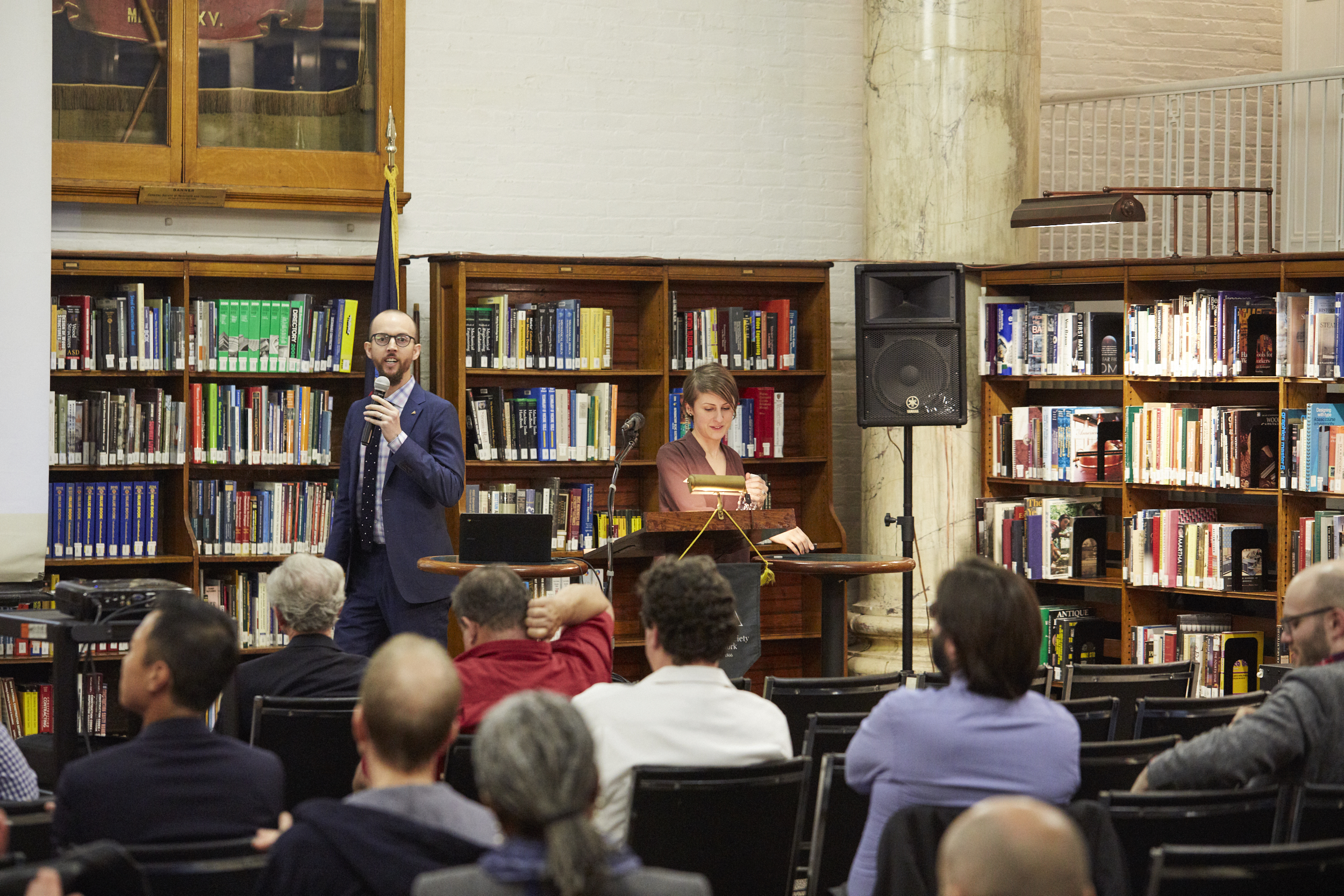
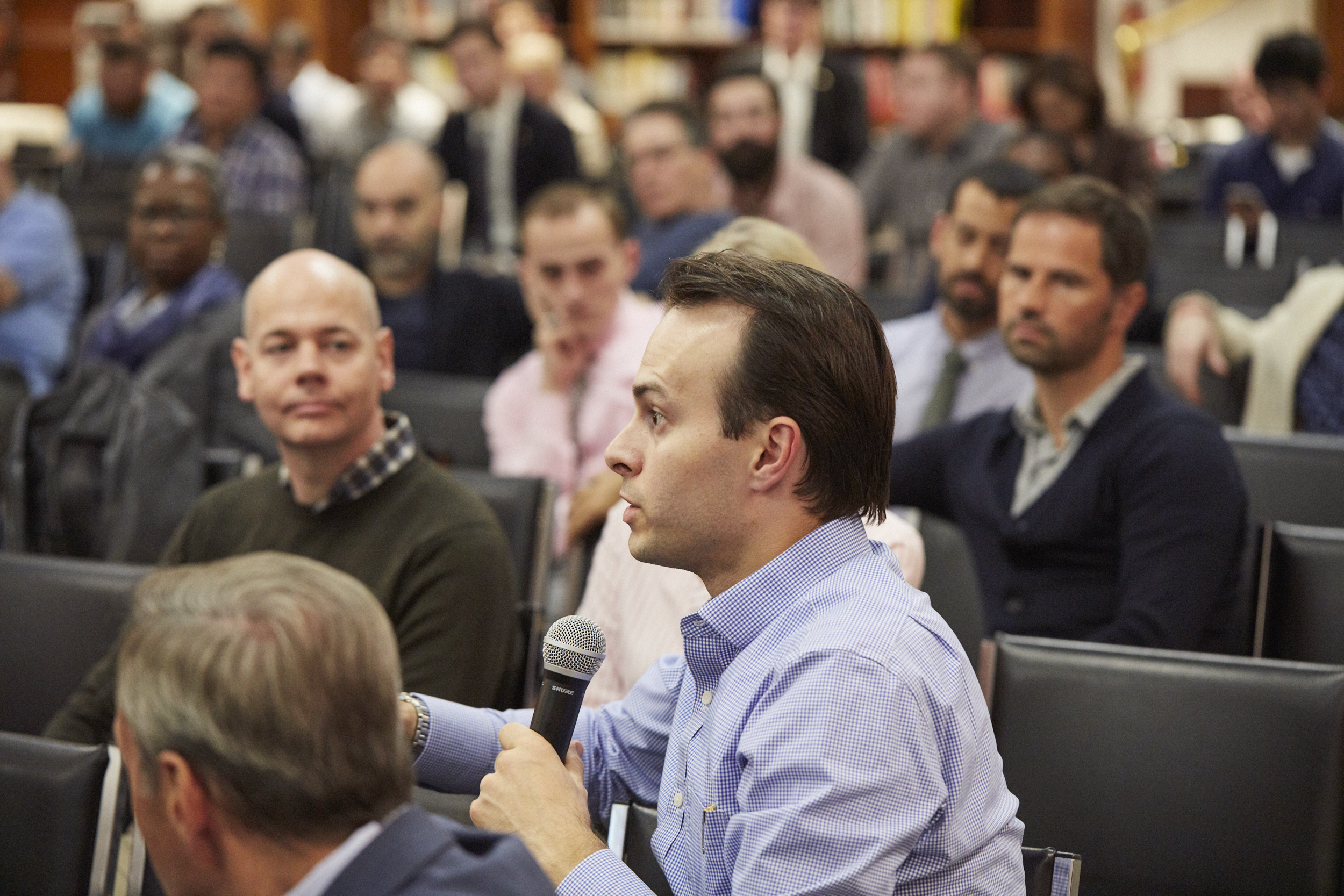
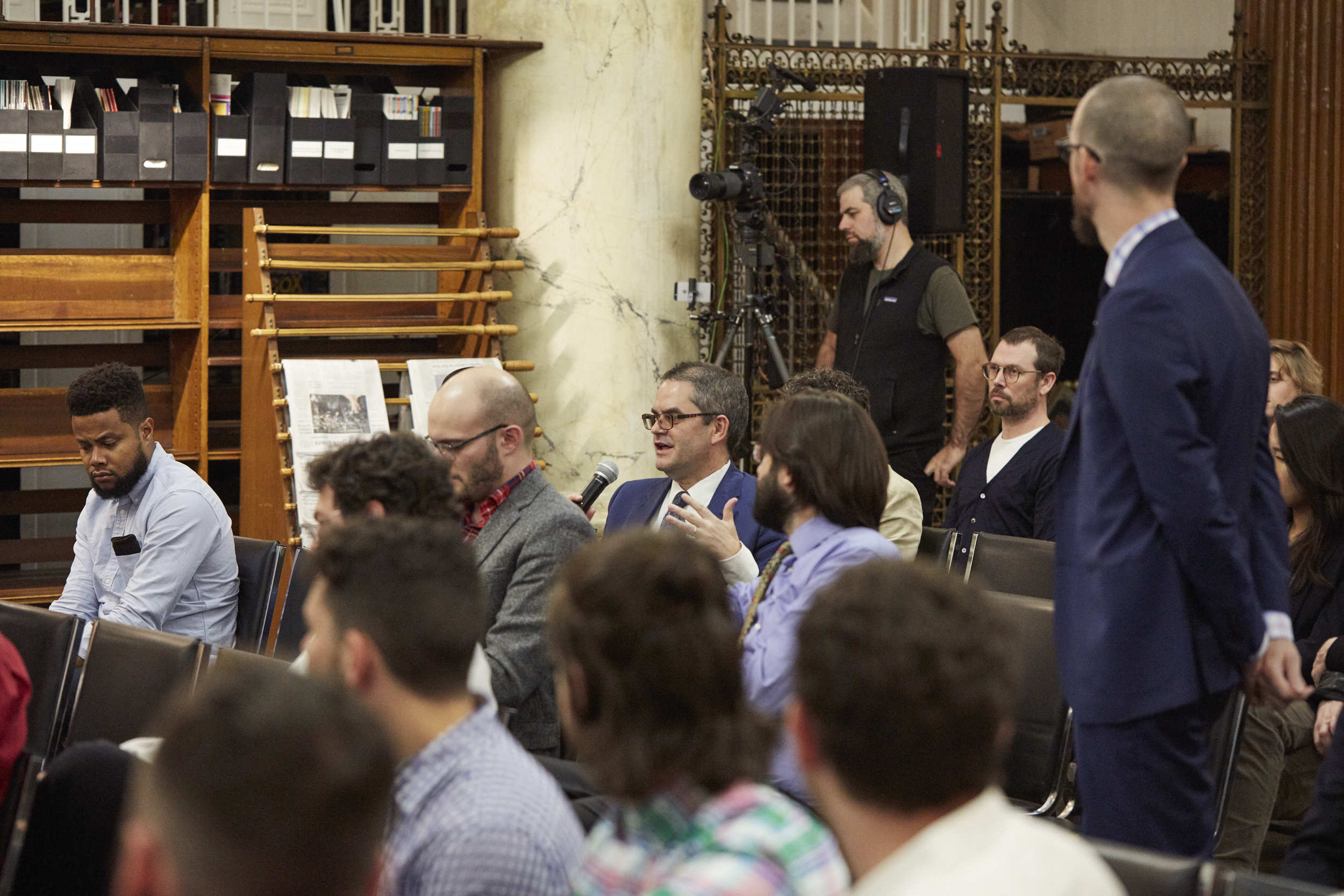
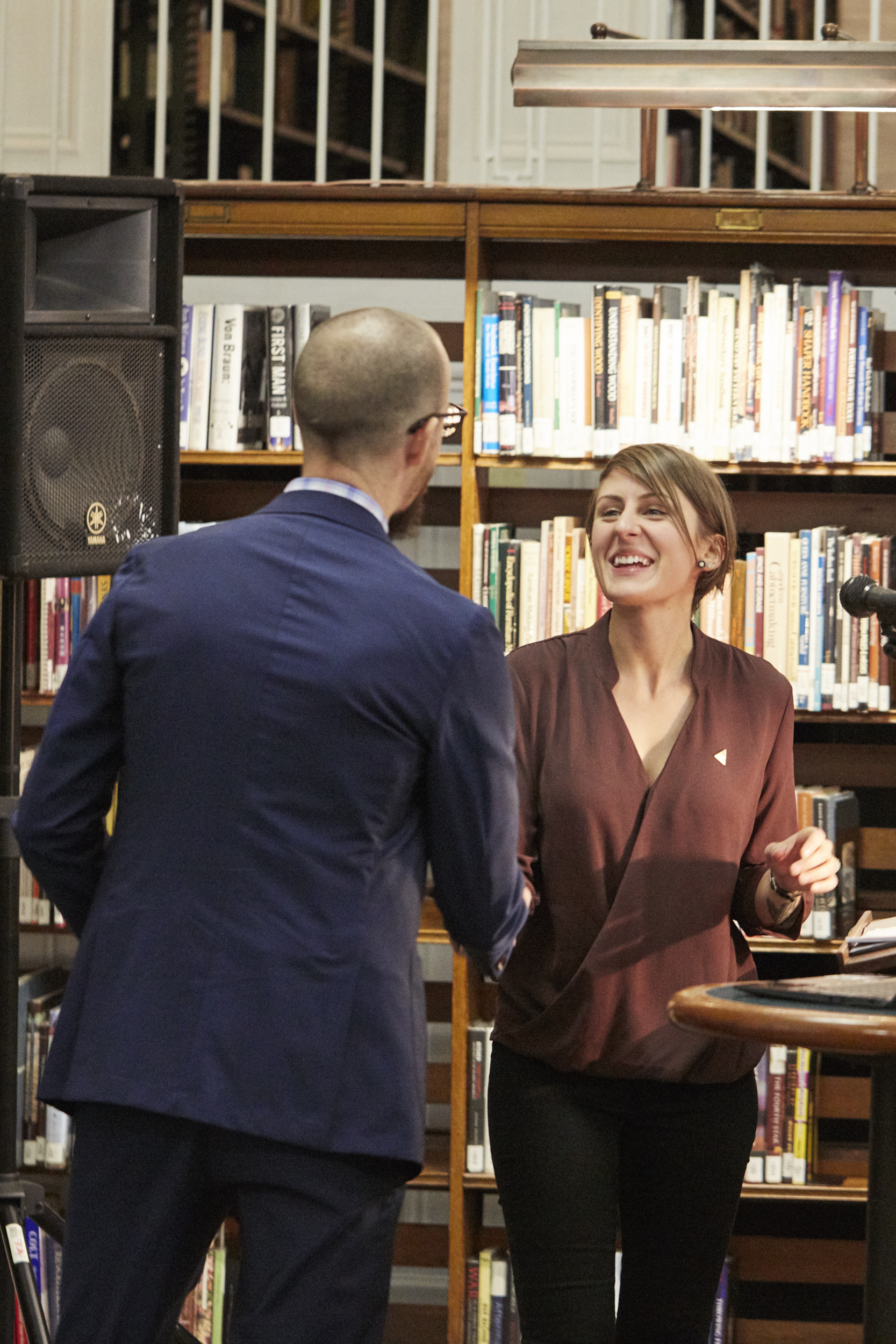
Meeting Recap: Choosing a Clock: Regulation, Cosmopolitanism and Humbuggery
Professor Kevin Birth, Department of Anthropology, Queens College, City University of New York
September 5, 2017
Video recordings of meetings are available to HSNY members.
Imagine if you will, Grand Central Terminal at rush hour on a Friday afternoon. Now, imagine that every train line had clocks that told a different time. What chaos would result! At the September 2017 meeting of the Horological Society of New York, Professor Kevin Birth discussed the history manipulating time for political gain, known as time pluralism.
Birth gave examples from medieval times up to present day. Highlights include English, Austrian, and American history, including the 1859 New York Democratic Party Convention. Over the centuries, hours have changed dramatically from country to country and from season to season, beginning with sundials and even paper hour tables that served to explain what church clock bells meant from many different cultures. Clocks controlled business, the work day, and were also used to predict tides for merchant who moved their wares on rivers and canals.
HSNY thanks Professor Kevin Birth for the fascinating lecture!
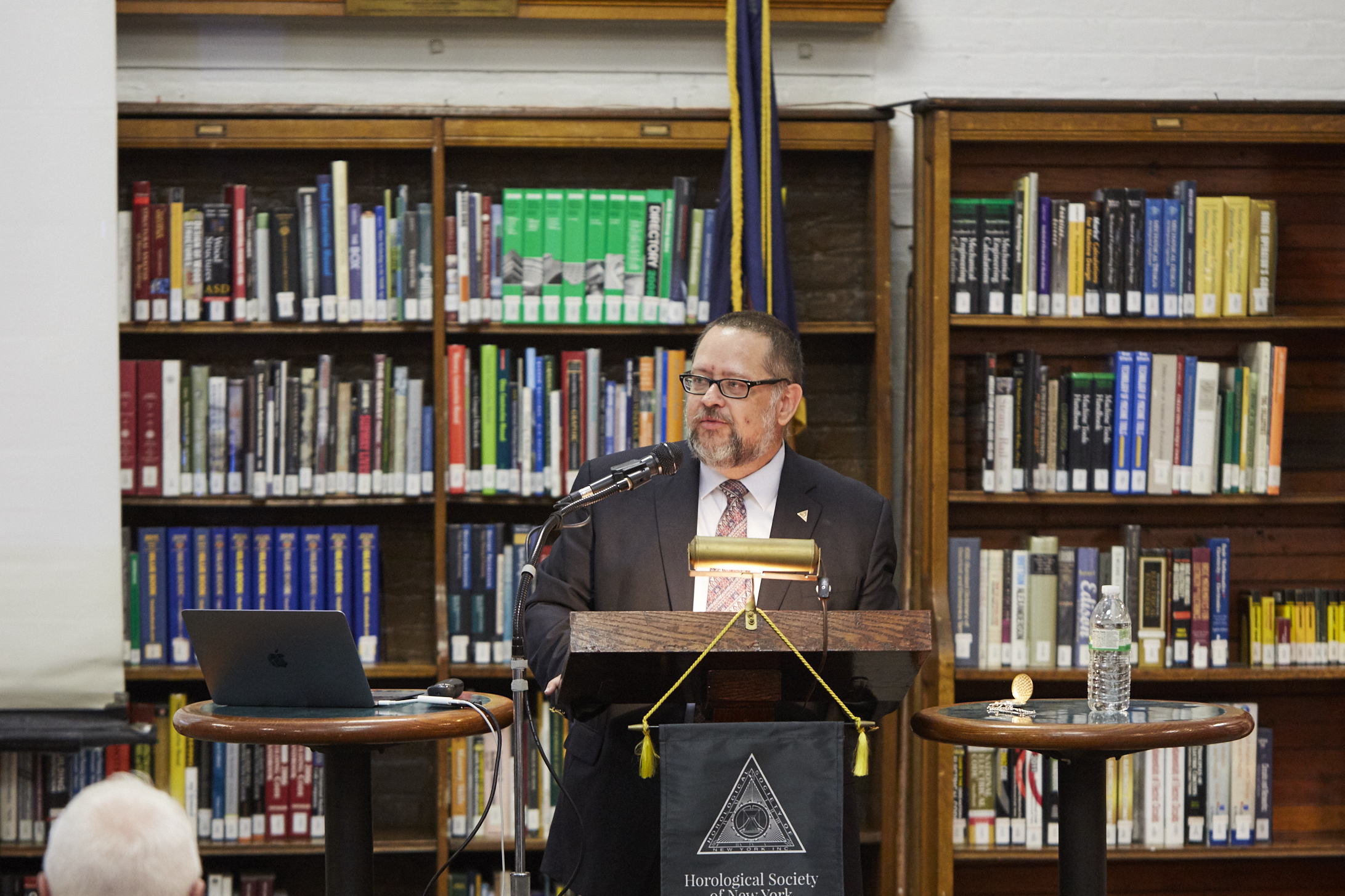
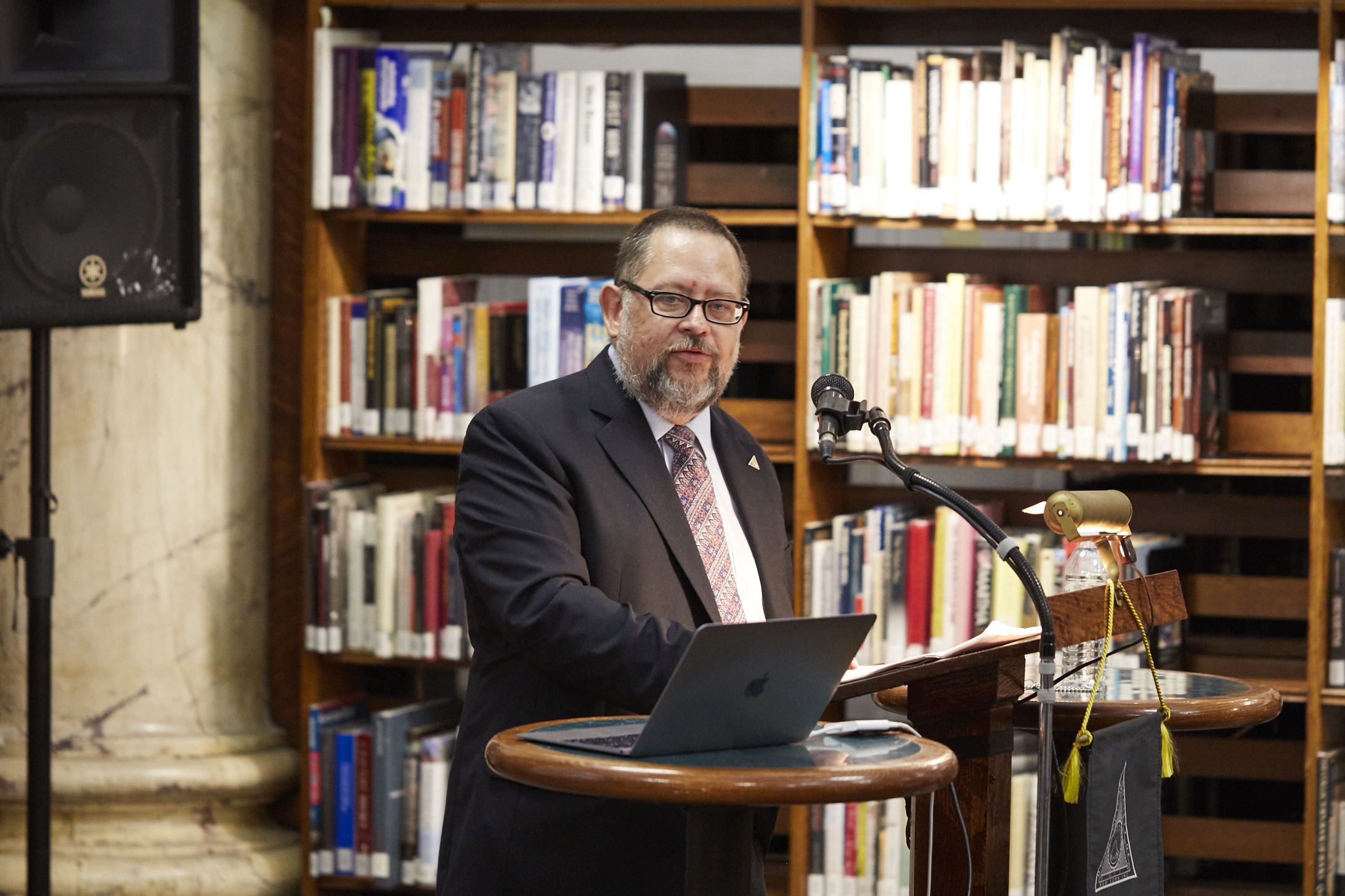
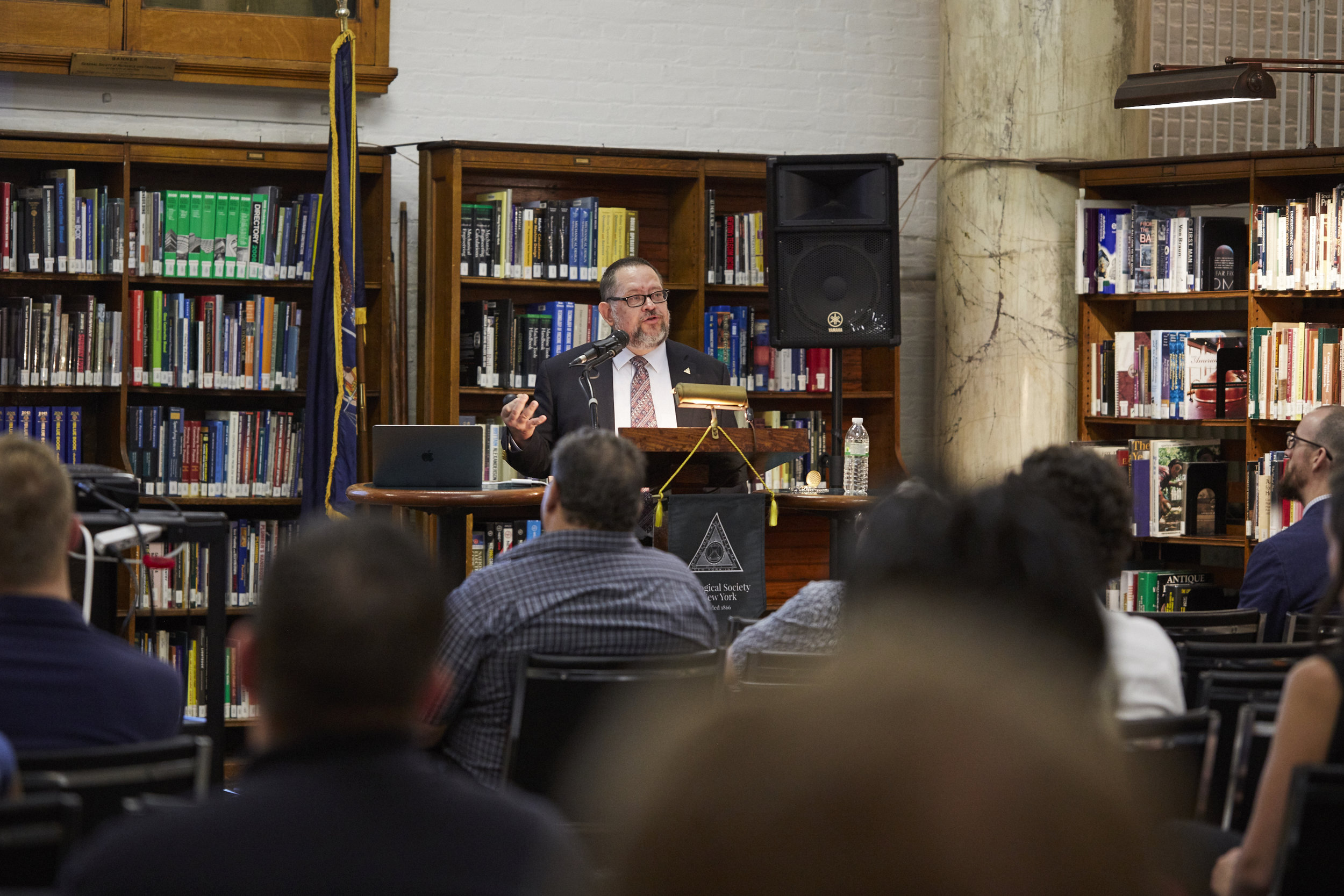




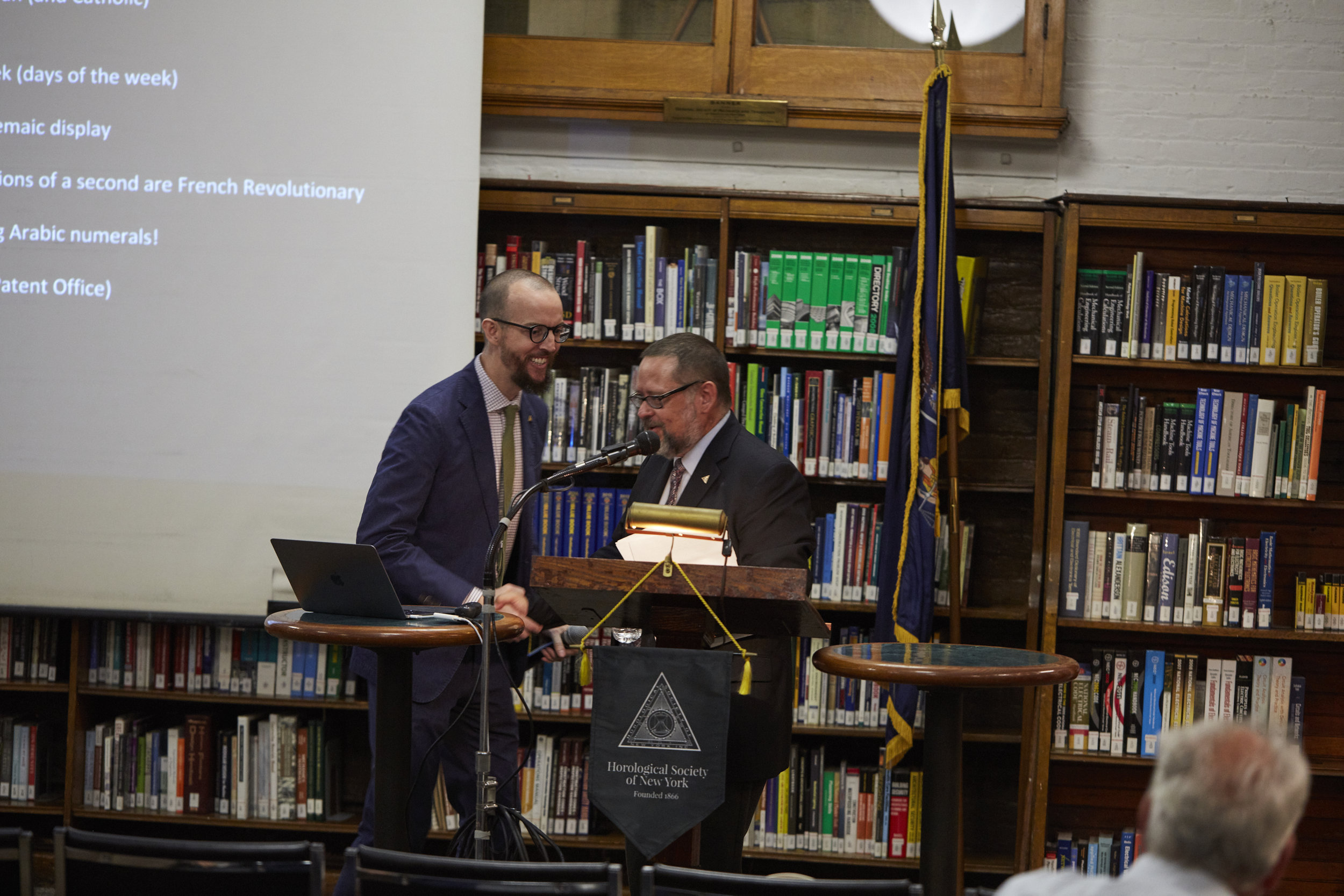
Ed Hydeman Named Executive Director for HSNY
HSNY has experienced phenomenal growth over recent years, and the need for a new position to manage behind-the-scenes aspects of the Society has become evident. With this in mind, HSNY's Trustees elected Ed Hydeman as the Society's first Executive Director at the June board meeting. Hydeman's extensive experience in the watch industry, along with serving as HSNY's President for eight years make him perfectly suited to the job. Congratulations, Ed!
Above, Ed Hydeman and Nicholas Manousos at HSNY's 150th Anniversary Gala, March 2016
Meeting Recap: The History of the Tourbillon
Stephen Forsey, Co-founder of Greubel Forsey and CompliTime SA
June 5, 2017
Video recordings of meetings are available to HSNY members.
In his lecture at the June 5th meeting of the Horological Society of New York, Greubel Forsey Co-founder Stephen Forsey detailed the history and functionality of tourbillon watches. Invented in the late 18th century by Abraham-Louis Breguet, the tourbillon has evolved with many enhancements to rate accuracy and reliability. Mr. Forsey pointed out several inventions and improvements made by Greubel Forsey, including their 30 degree inclined tourbillon. Also explained was the scientific methodology that goes into testing tourbillons.
Complimenting the lecture, a selection of Greubel Forsey timepieces were on display, allowing Society members a chance to examine expertly crafted tourbillon mechanisms up close. We thank Mr. Forsey for visiting the Horological Society of New York and delivering such an intriguing lecture.
Submitted by Walter Pangretitsch, Recording Secretary, HSNY
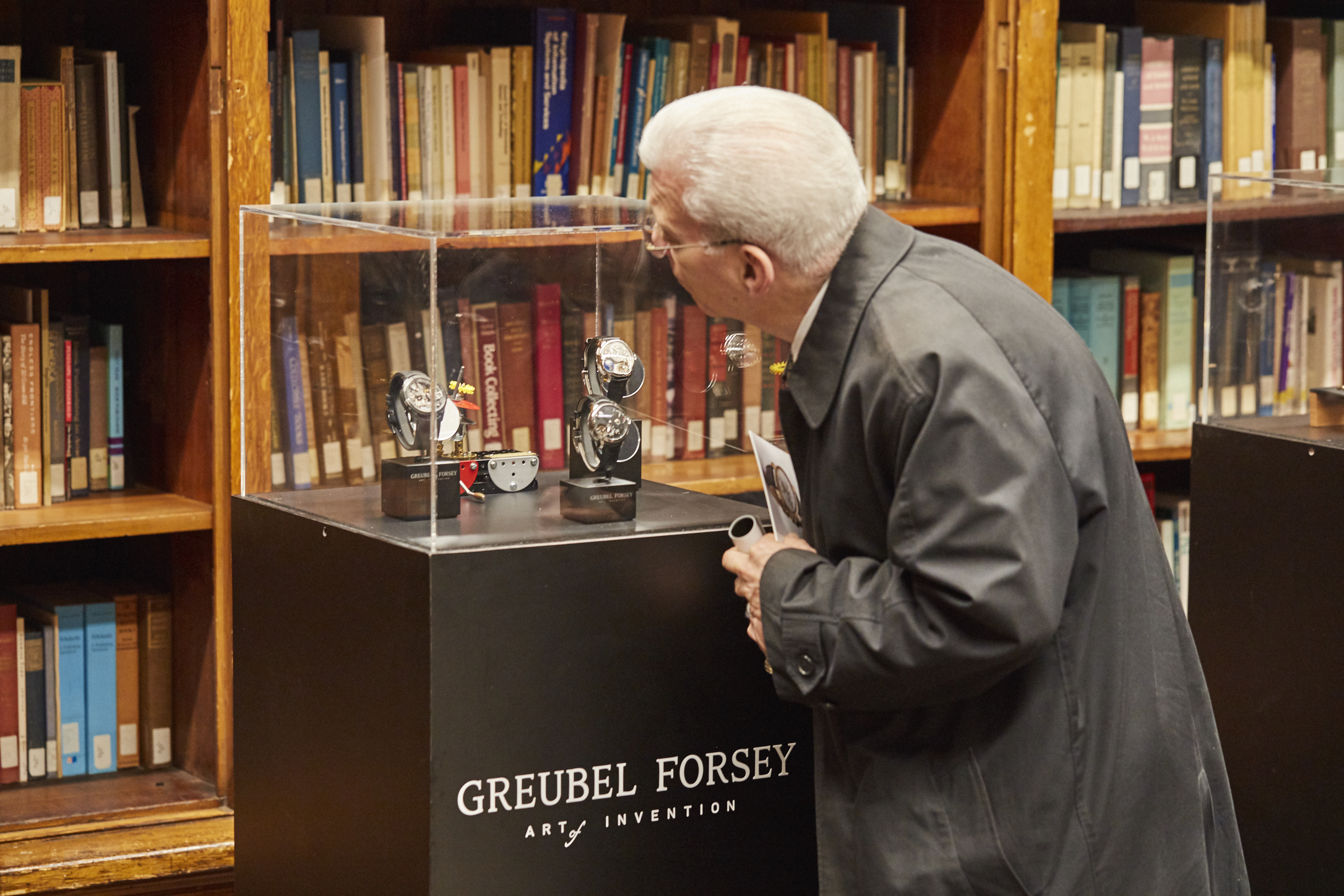
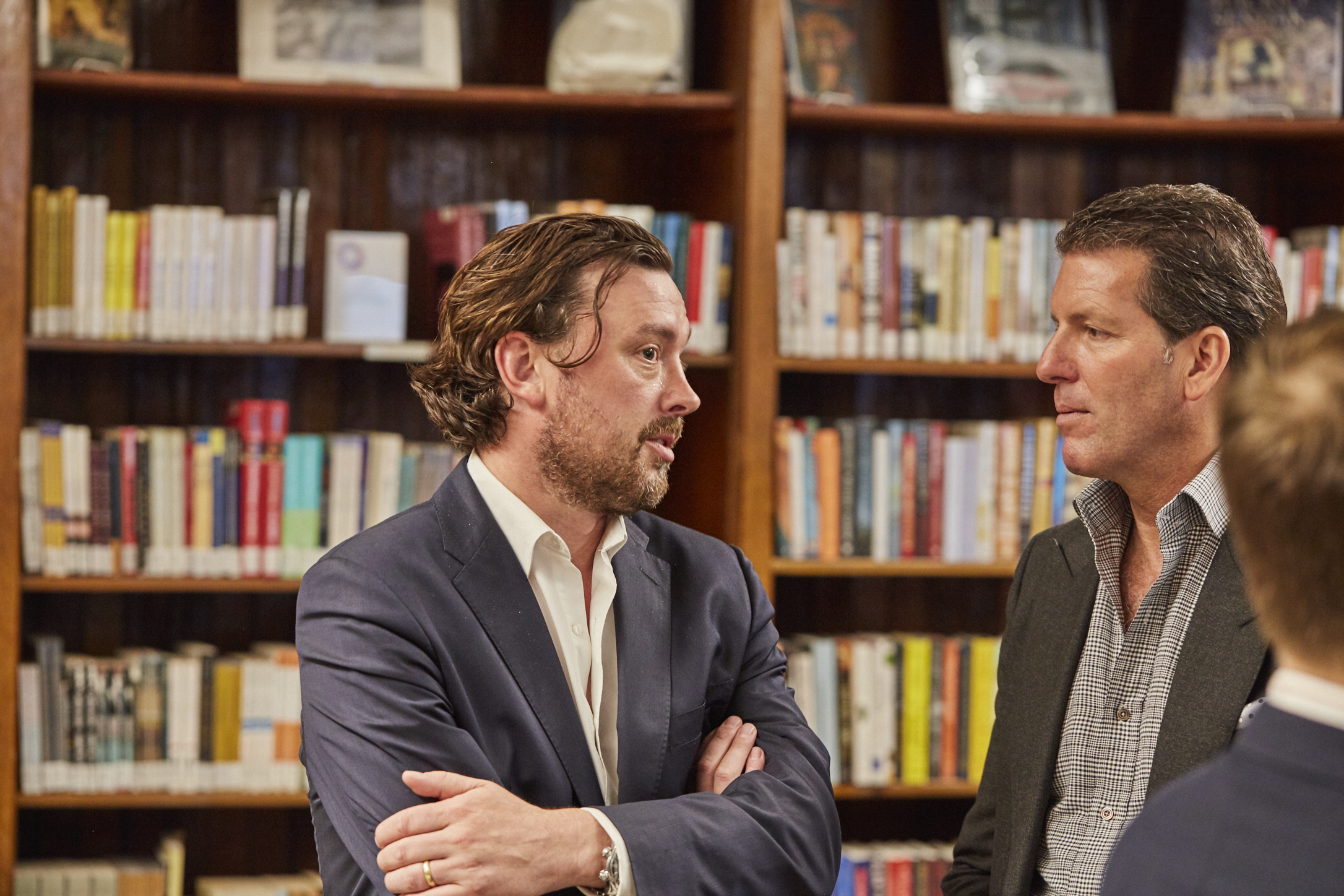

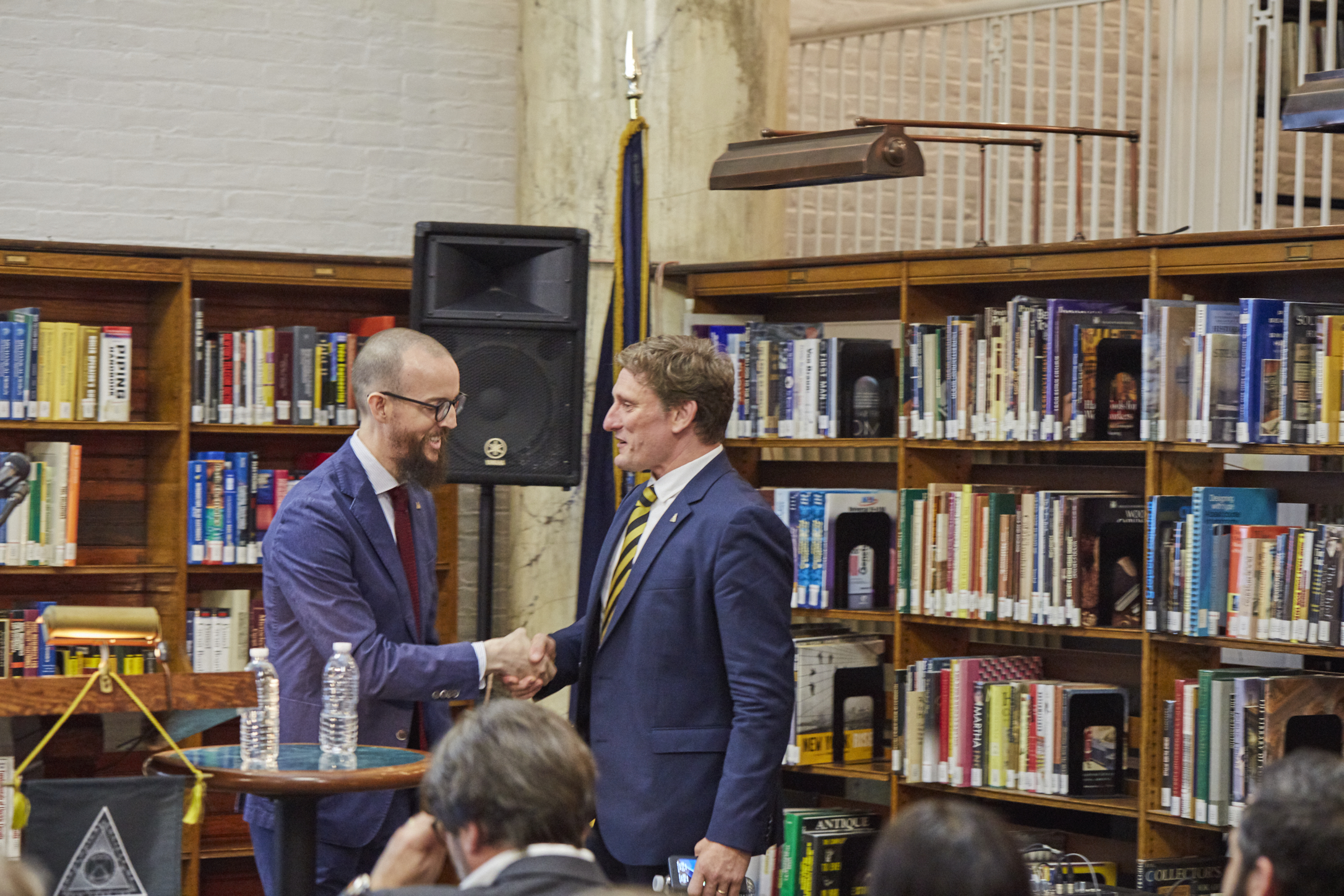
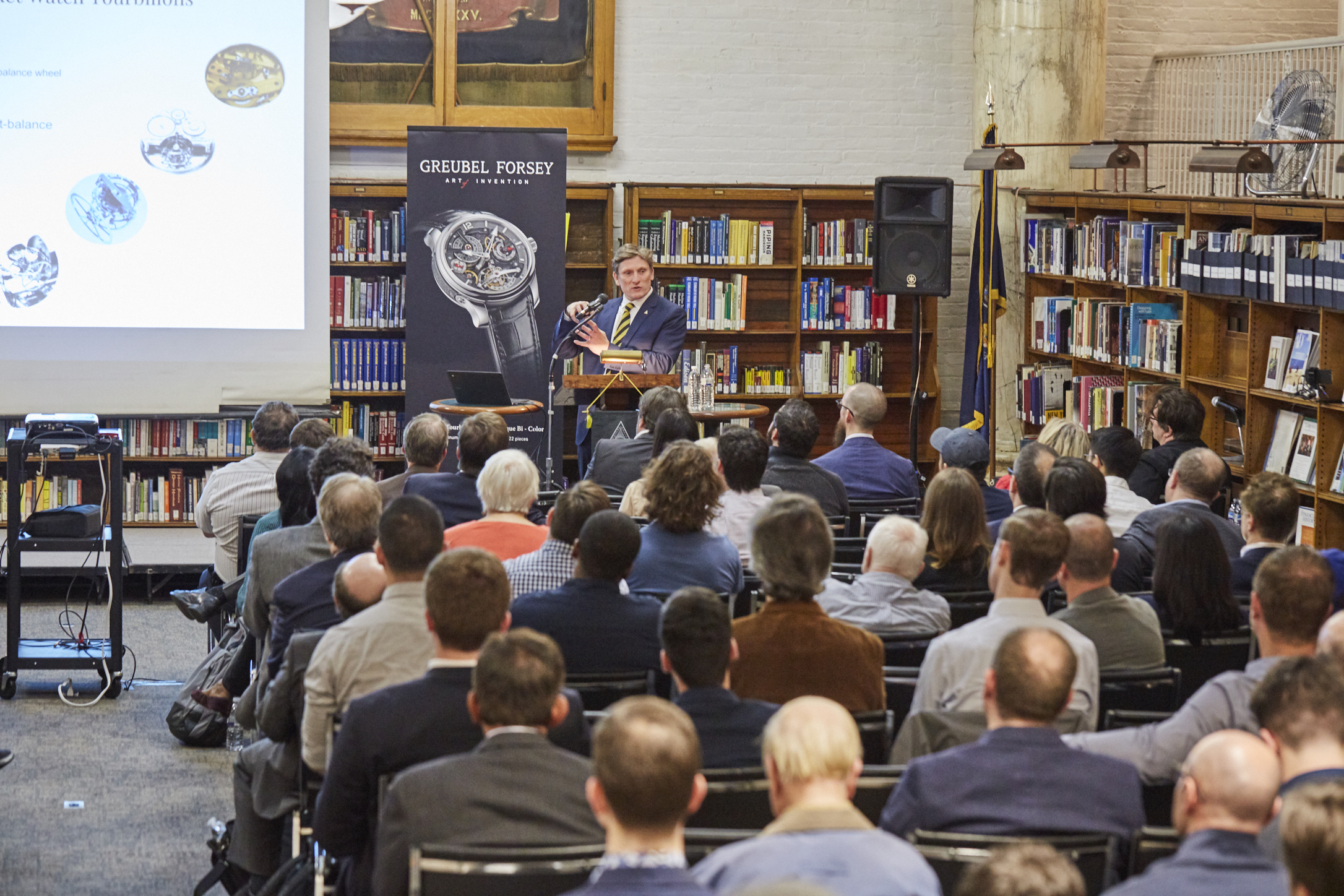
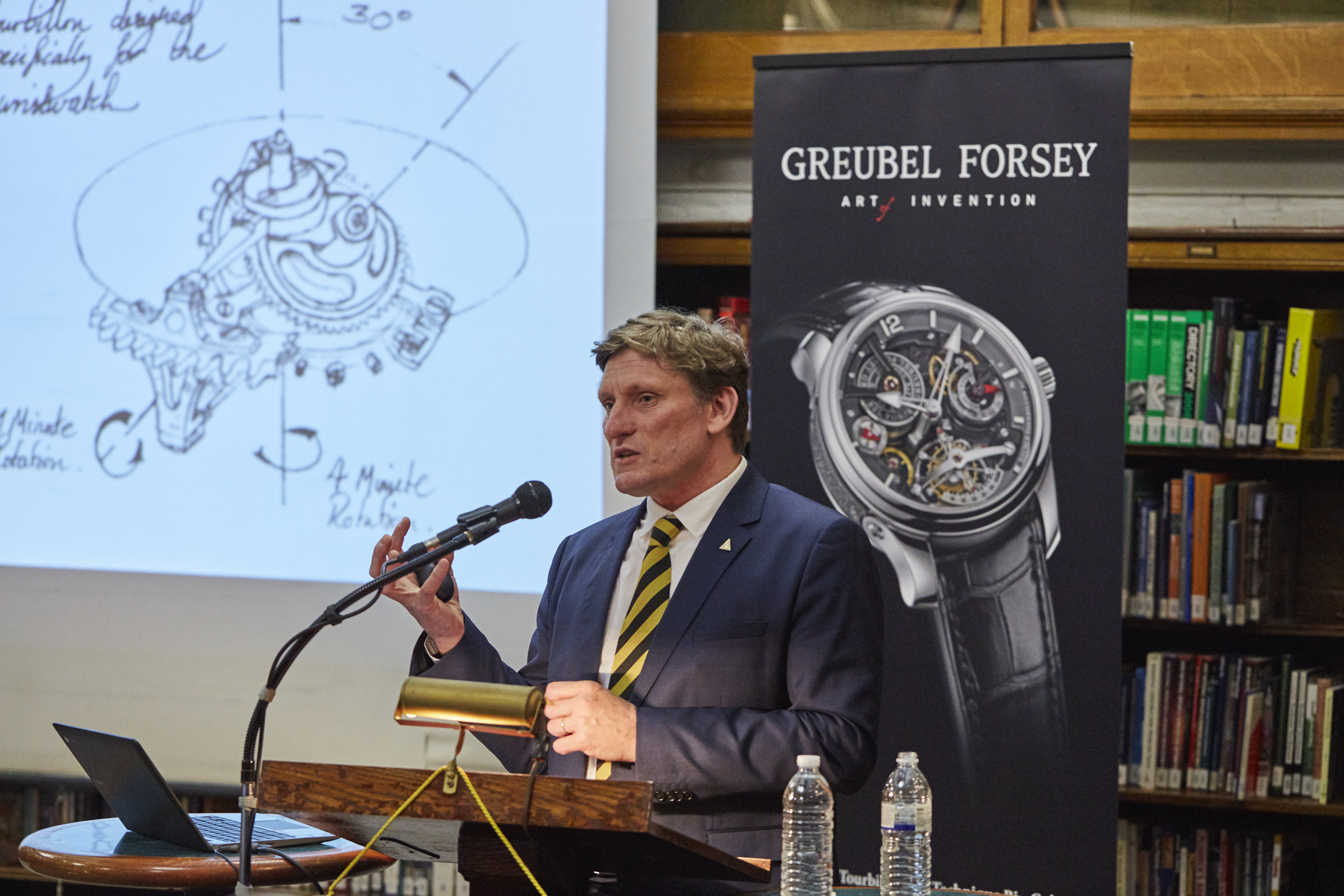
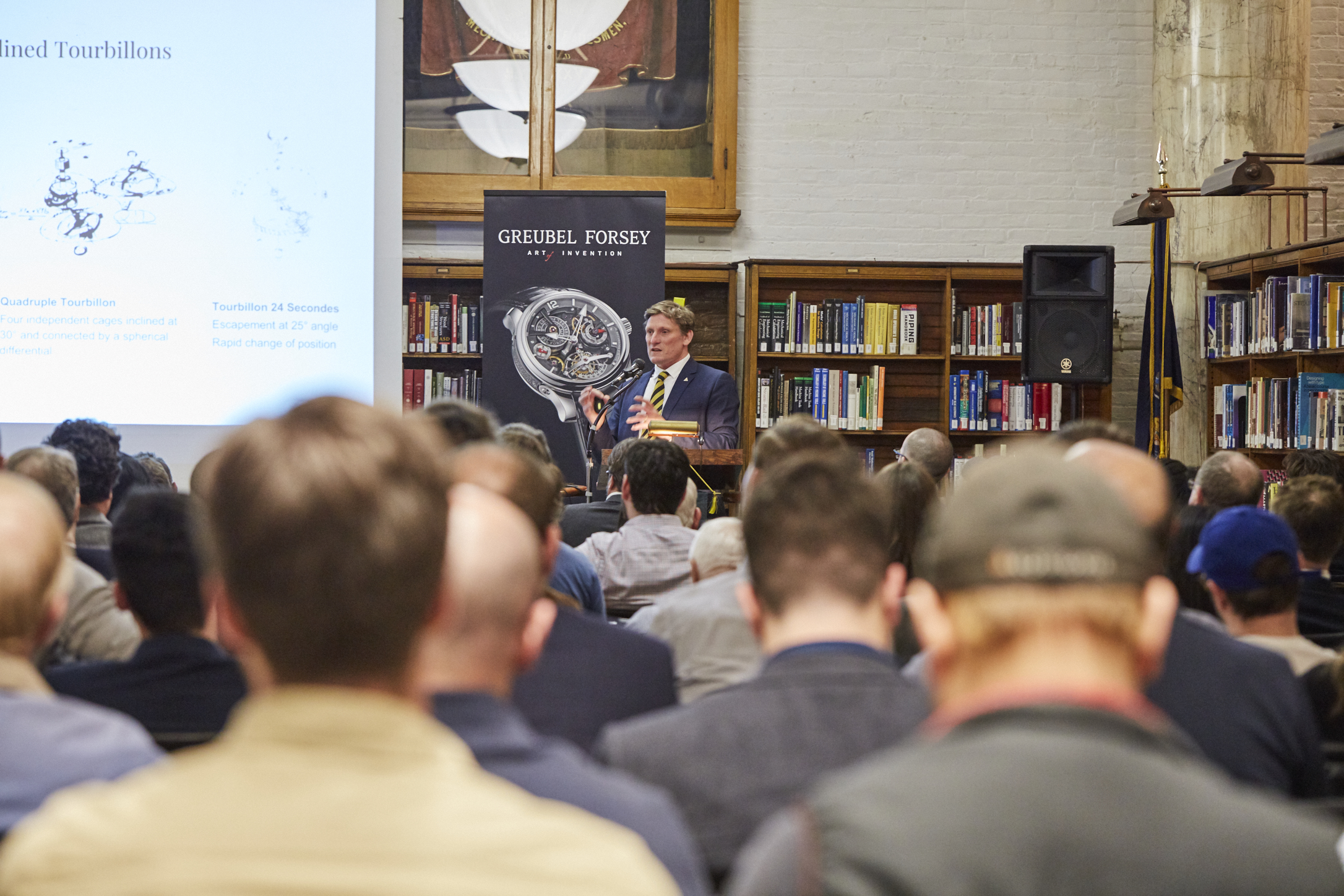


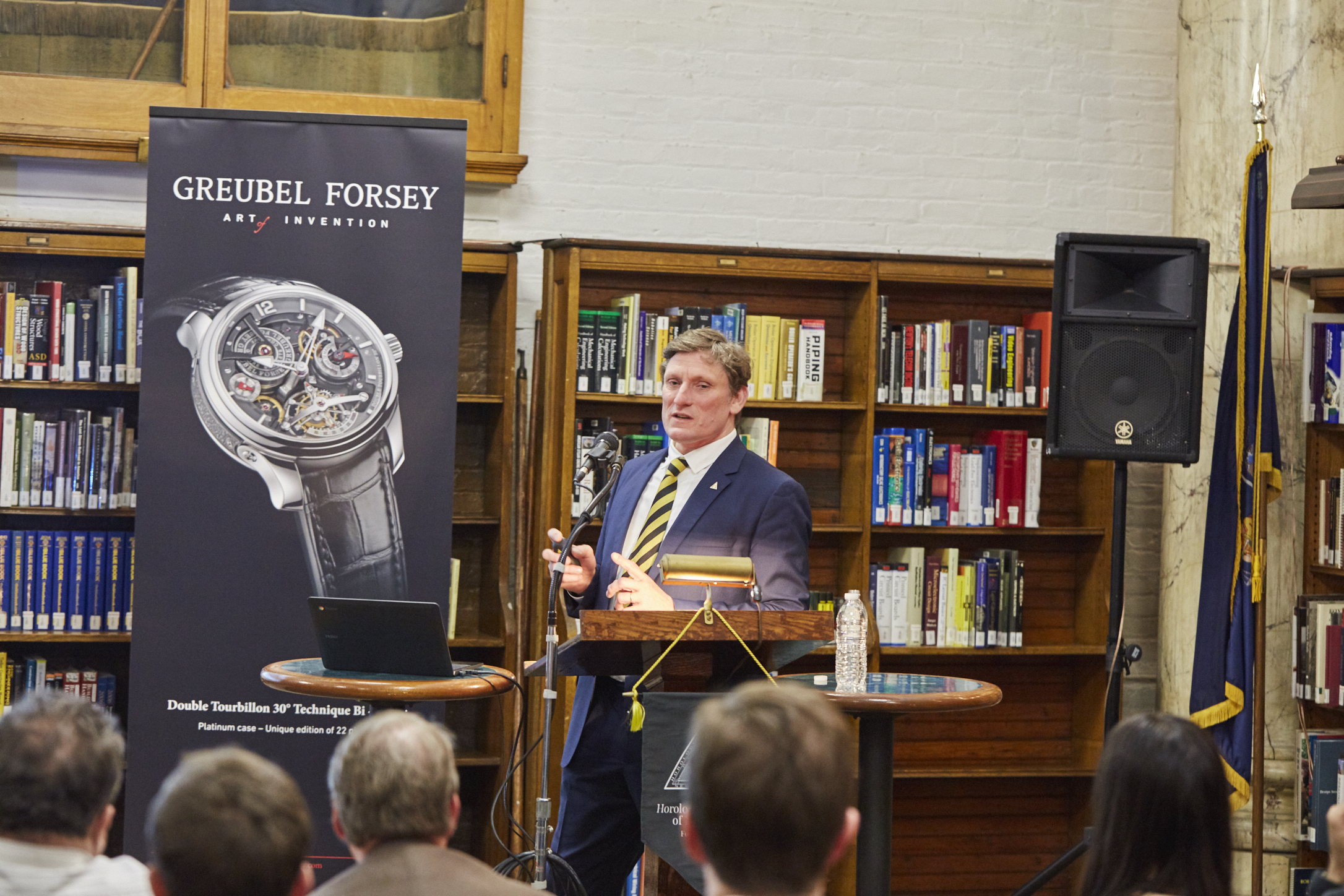

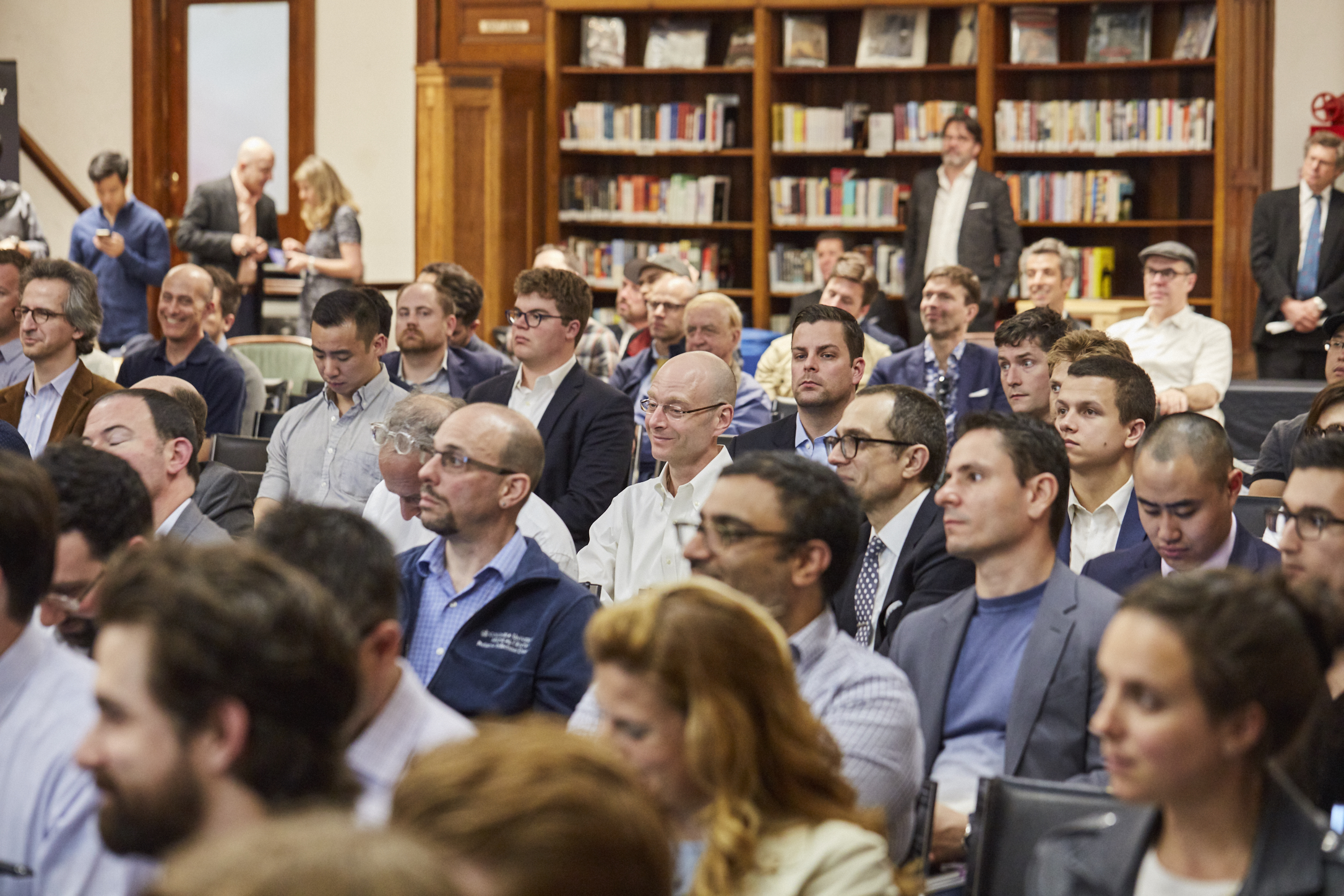
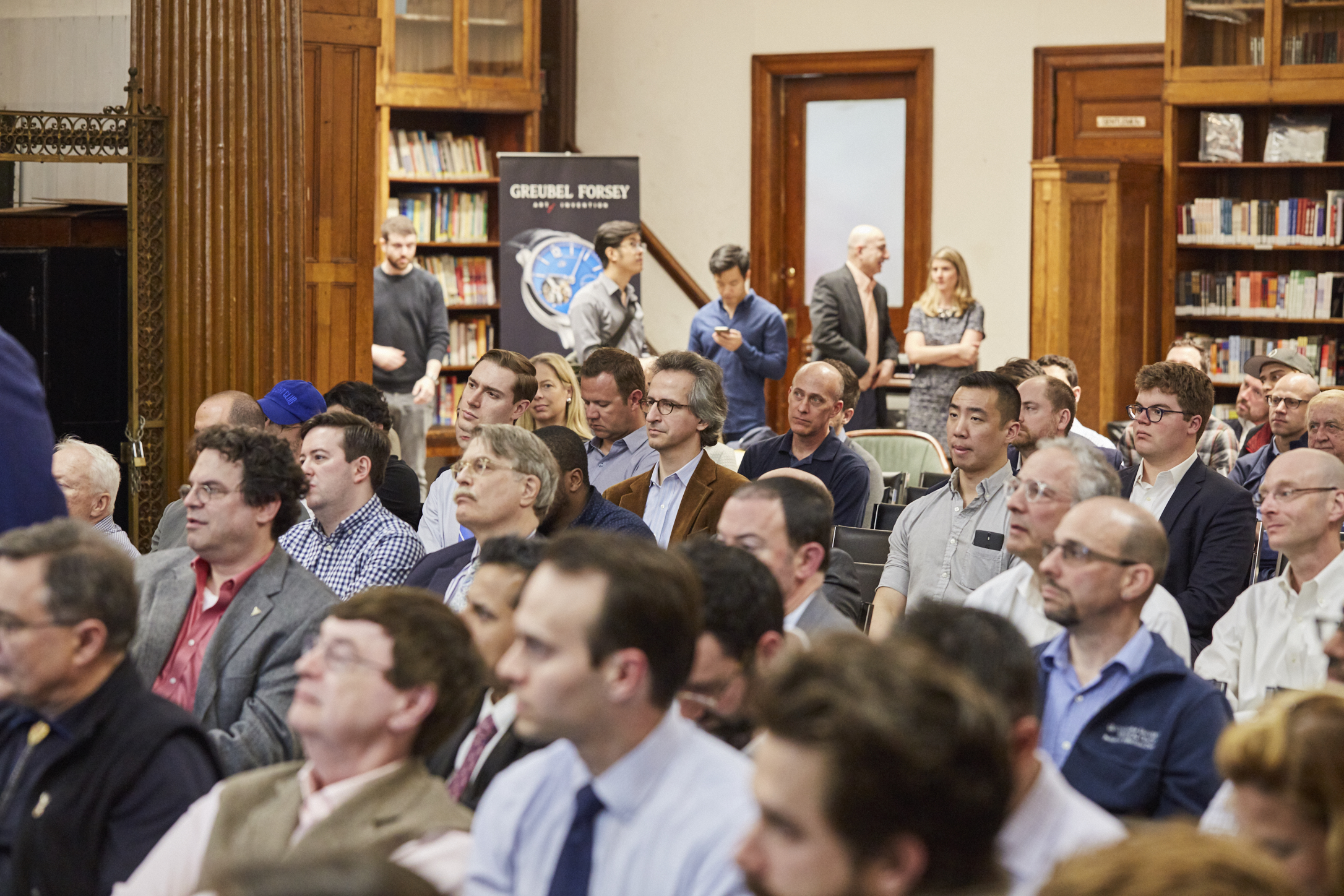
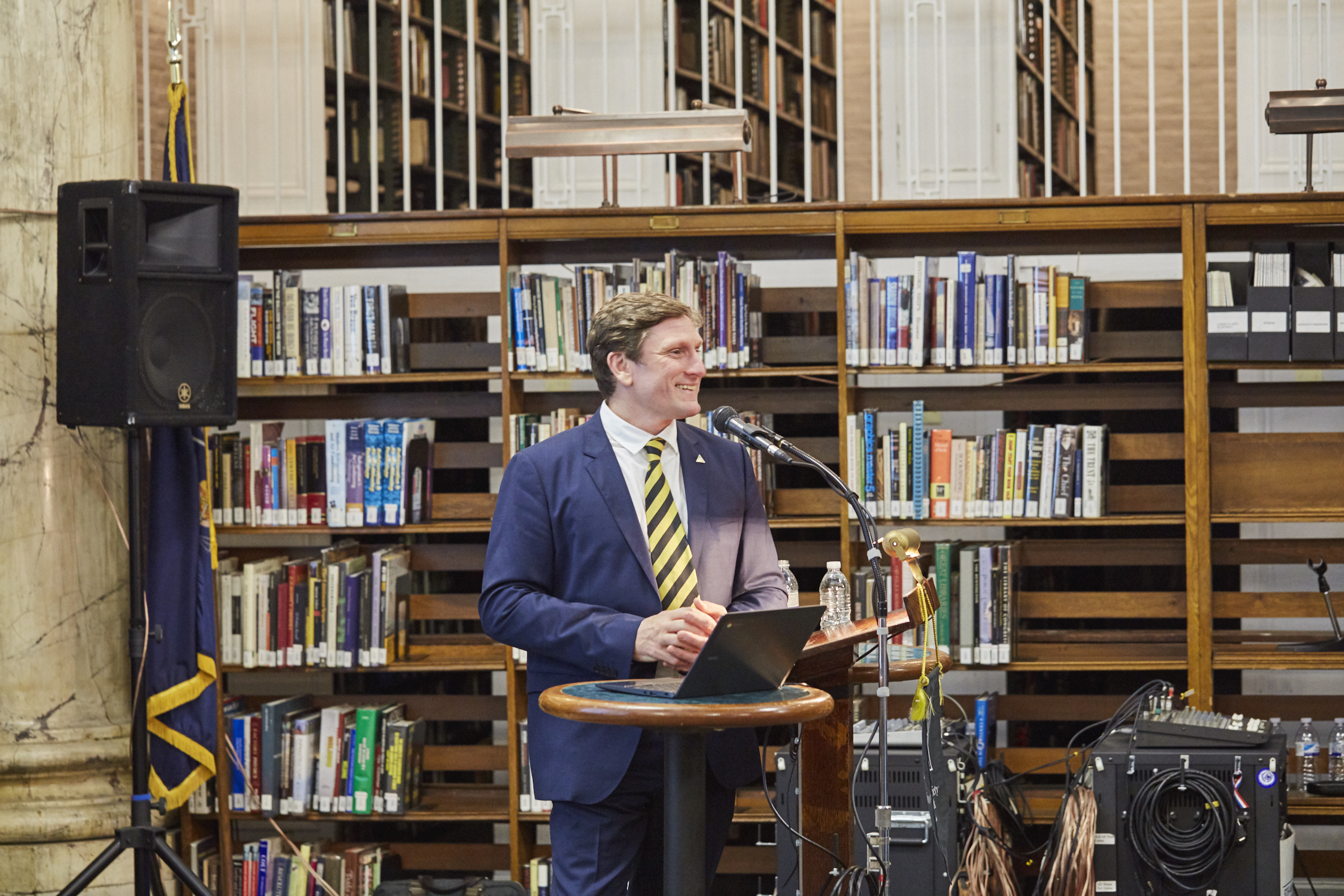
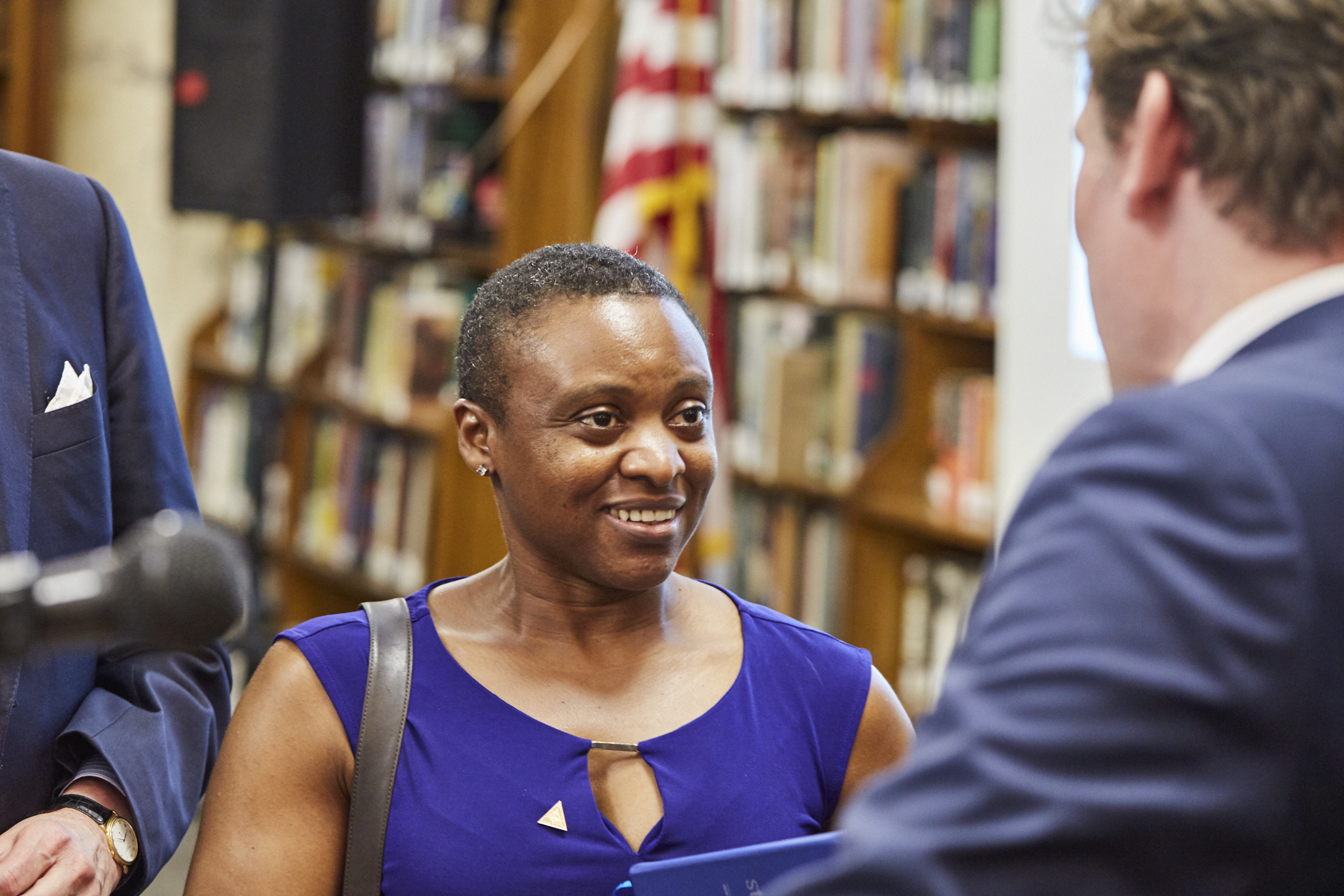
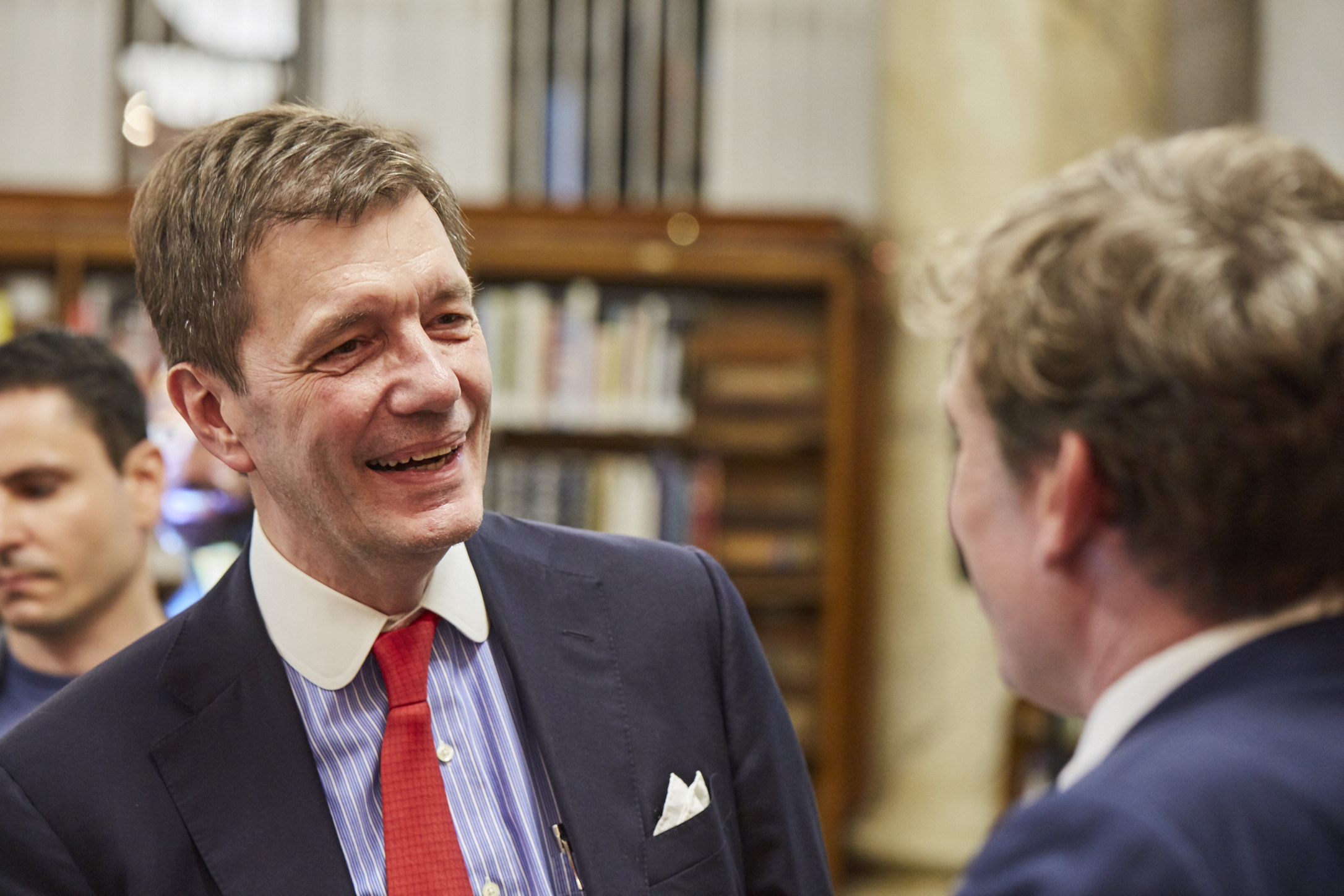

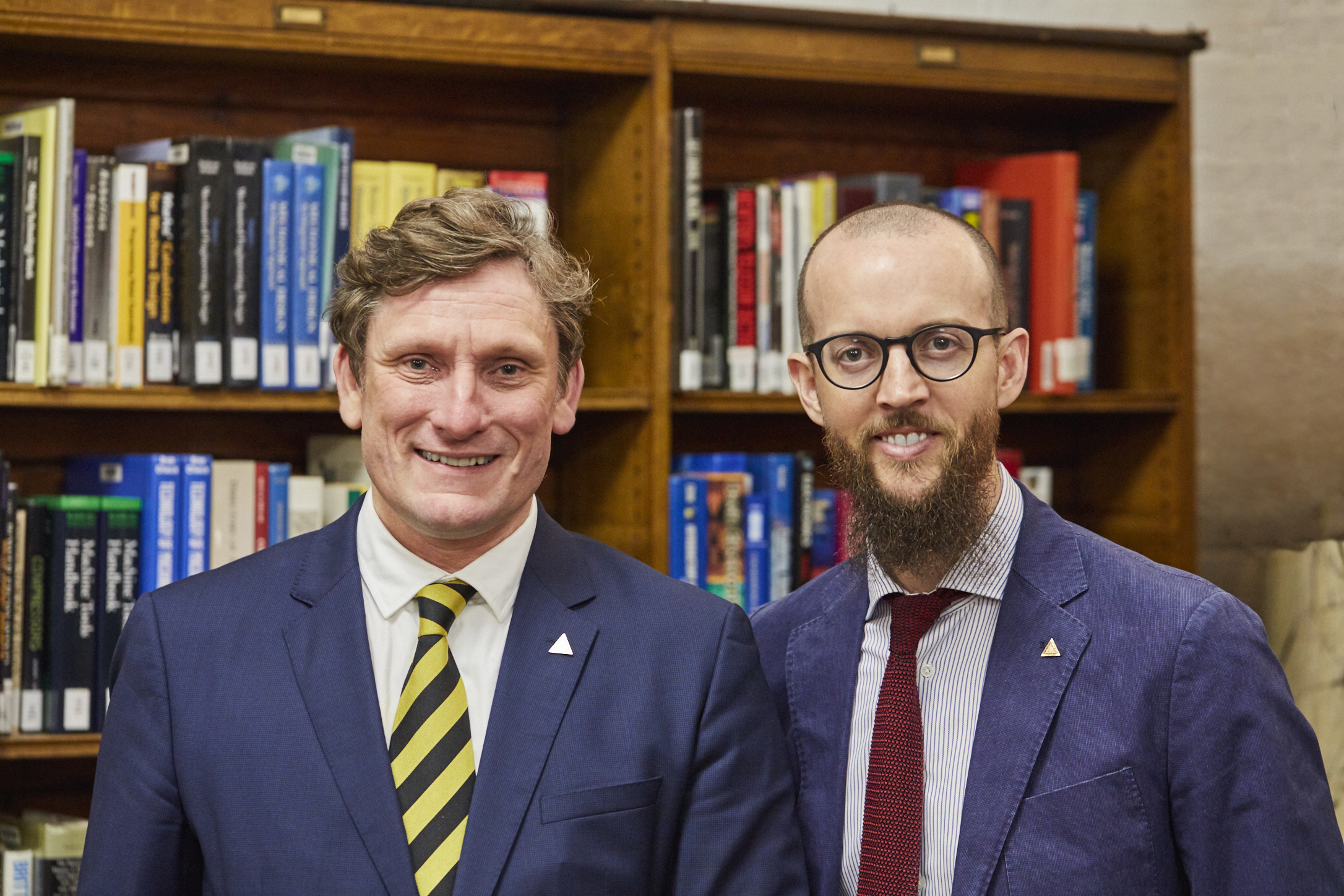
Meeting Recap: Glashütte on Board – 130 Years of Marine Chronometers From Saxony
Ulrike Kranz - Glashütte Original
May 1, 2017
Video recordings of meetings are available to HSNY members.
There is always something new and interesting to learn at HSNY lectures. This was proven once again at the May 1st meeting when Glashütte Original's Ulrike Kranz discussed the history of German marine chronometers. Since the late 19th century and continuing to the present day, watch companies located in the city of Glashütte have produced marine chronometers used by countries worldwide to aid in sea navigation.
Ms. Kranz pointed out that the Glashütte horological industry went through hard times after WWII. Much of their machinery, equipment, and designs were confiscated by Russian forces as part of war reparations. However, they were able to retool most of their factories, recreating designs from memory. It was a remarkable achievement since there was a postwar blockade preventing imports from the west. The new GDR state controlled all factories. Nevertheless, outstanding timepieces continued to be exported.
Kranz explained that after the reunification of Germany the Glashütte Observatory was reopened, and today houses a chronometer testing facility. The Glashütte Observatory also officially certifies the chronometers made by Glashütte Original – the legal successor of the VEB Glashütter Uhrenbetriebe. HSNY thanks Ulrike Kranz, Glashütte Original and the German Watch Museum for the incredible look at German horological history!
Submitted by Walter Pangretitsch, Recording Secretary, HSNY
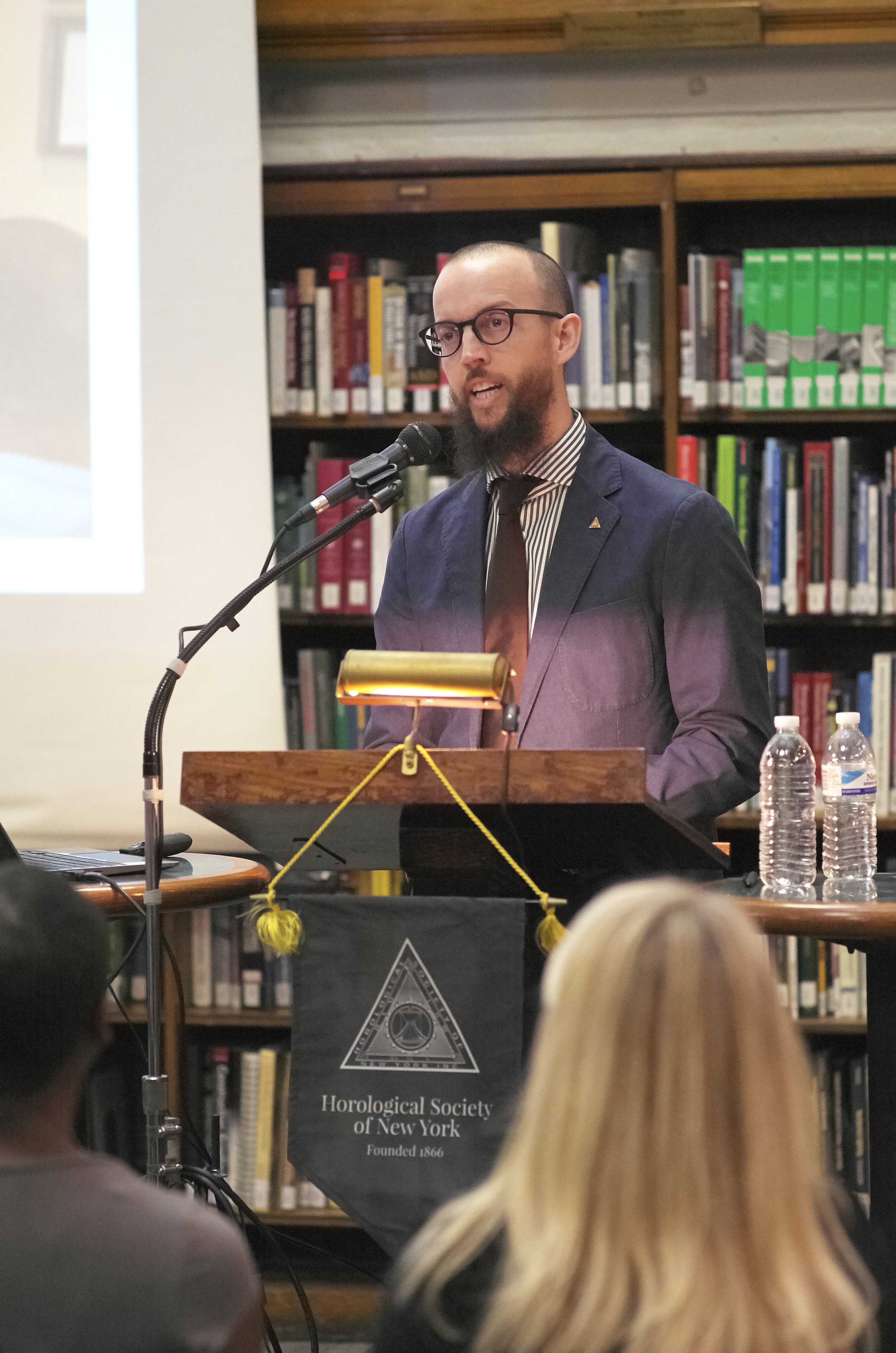
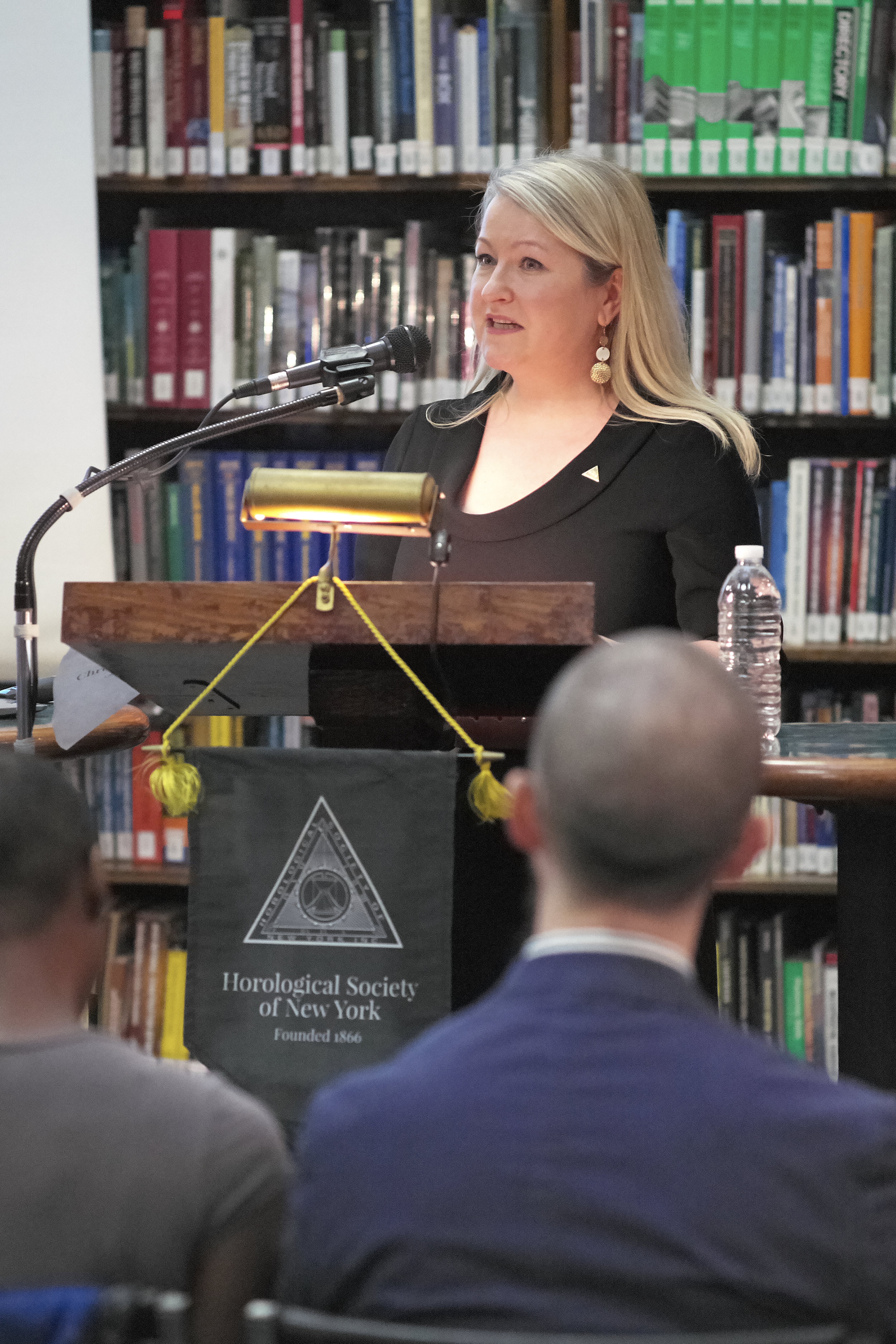
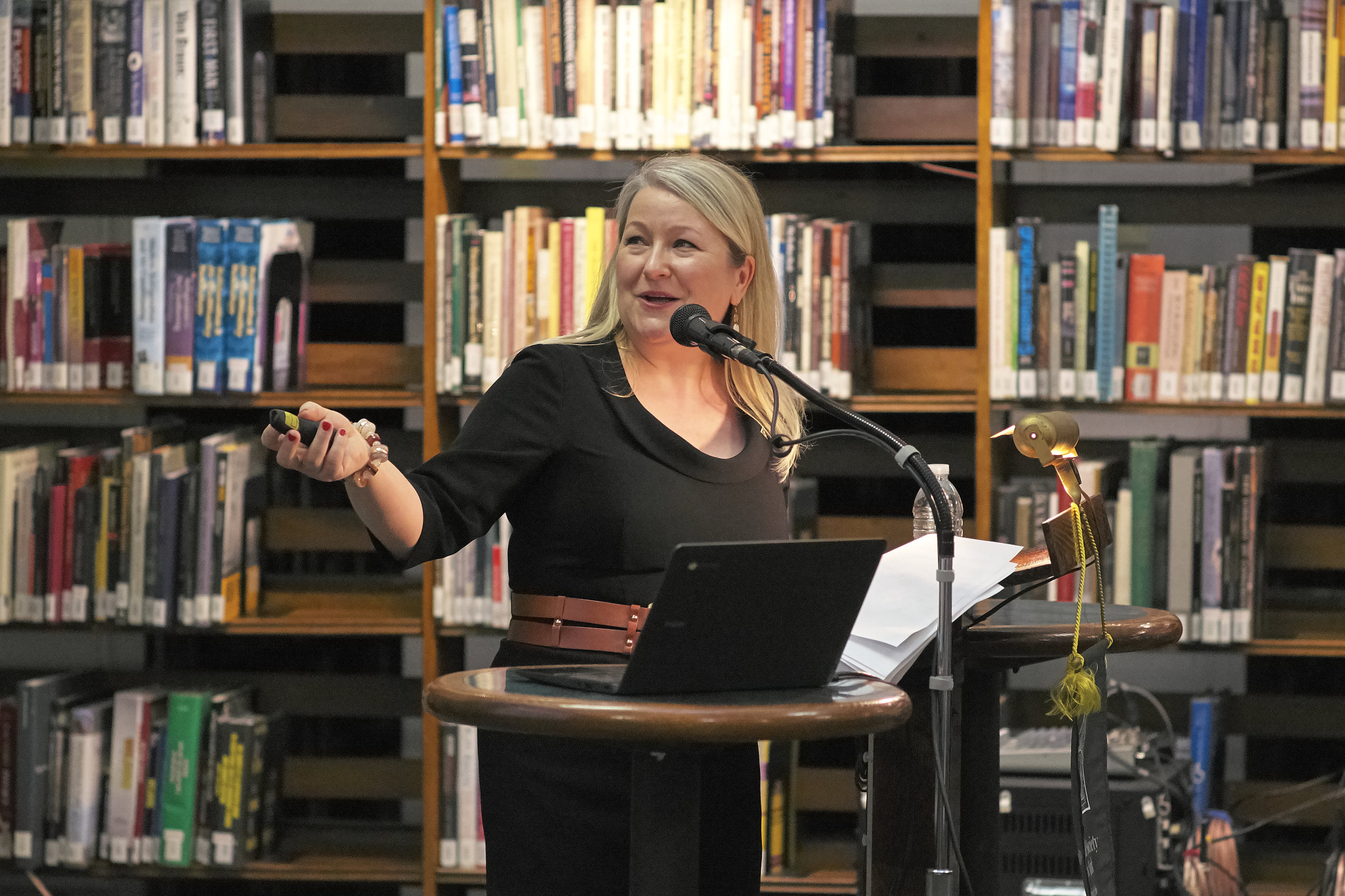
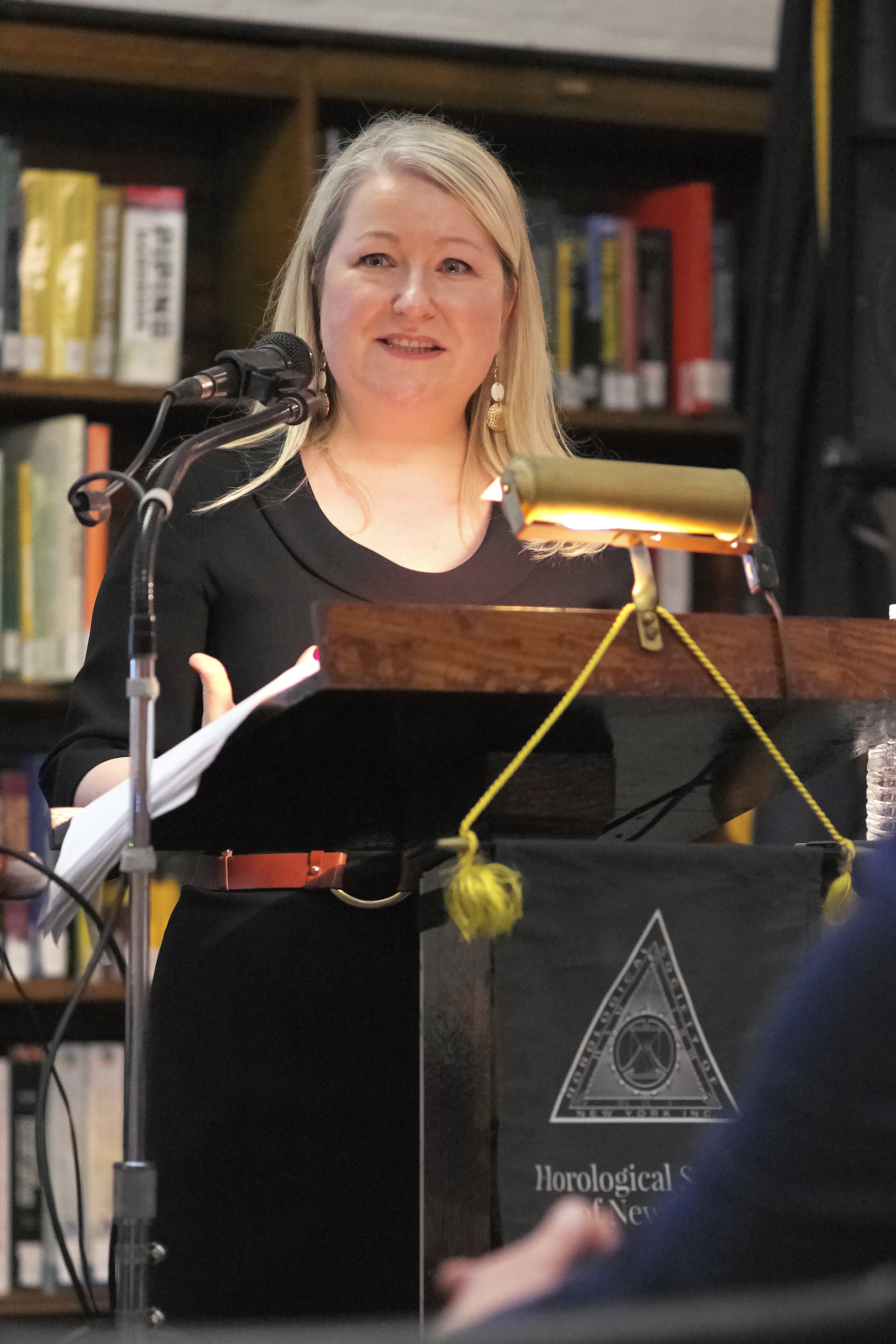

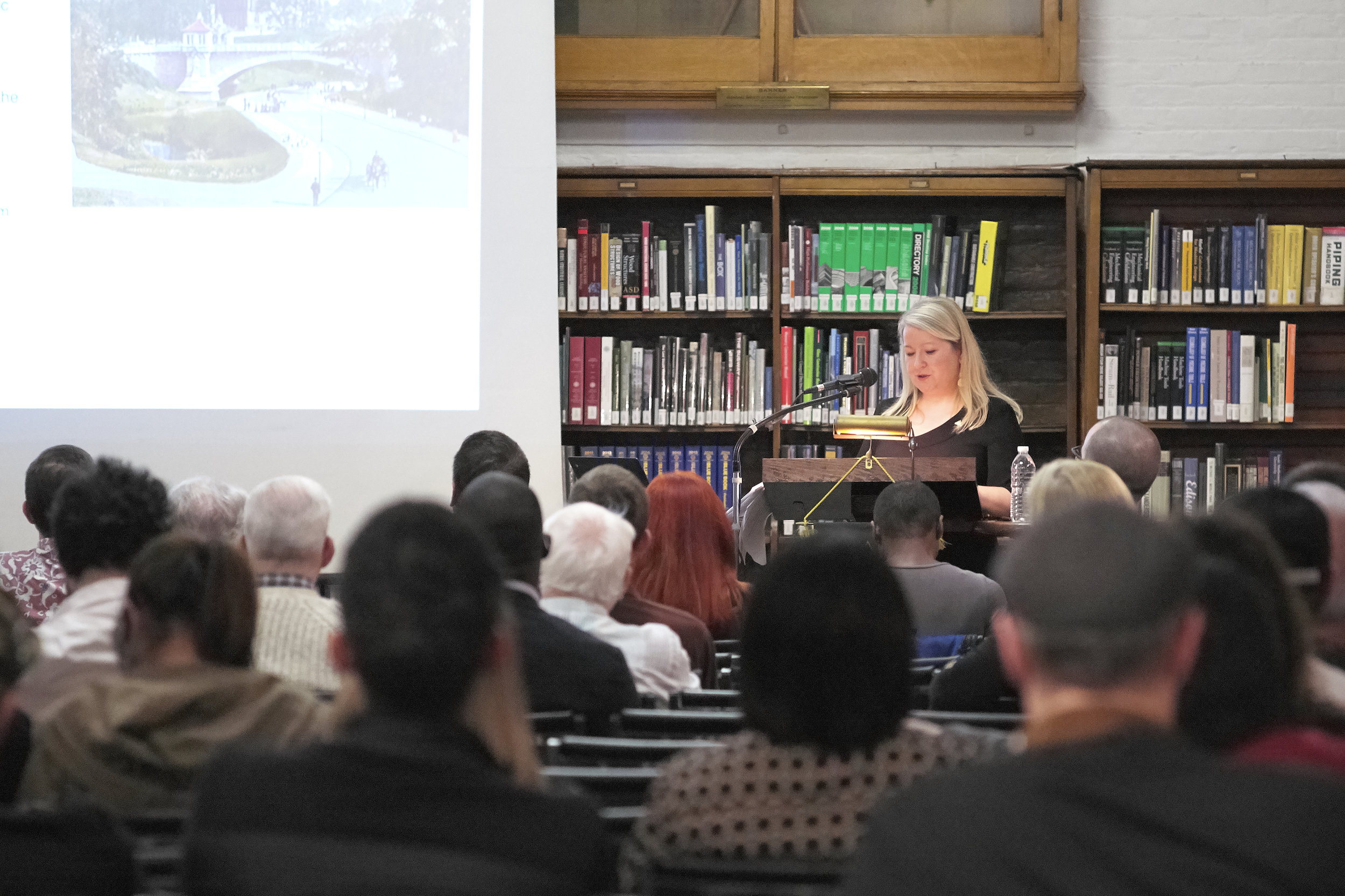
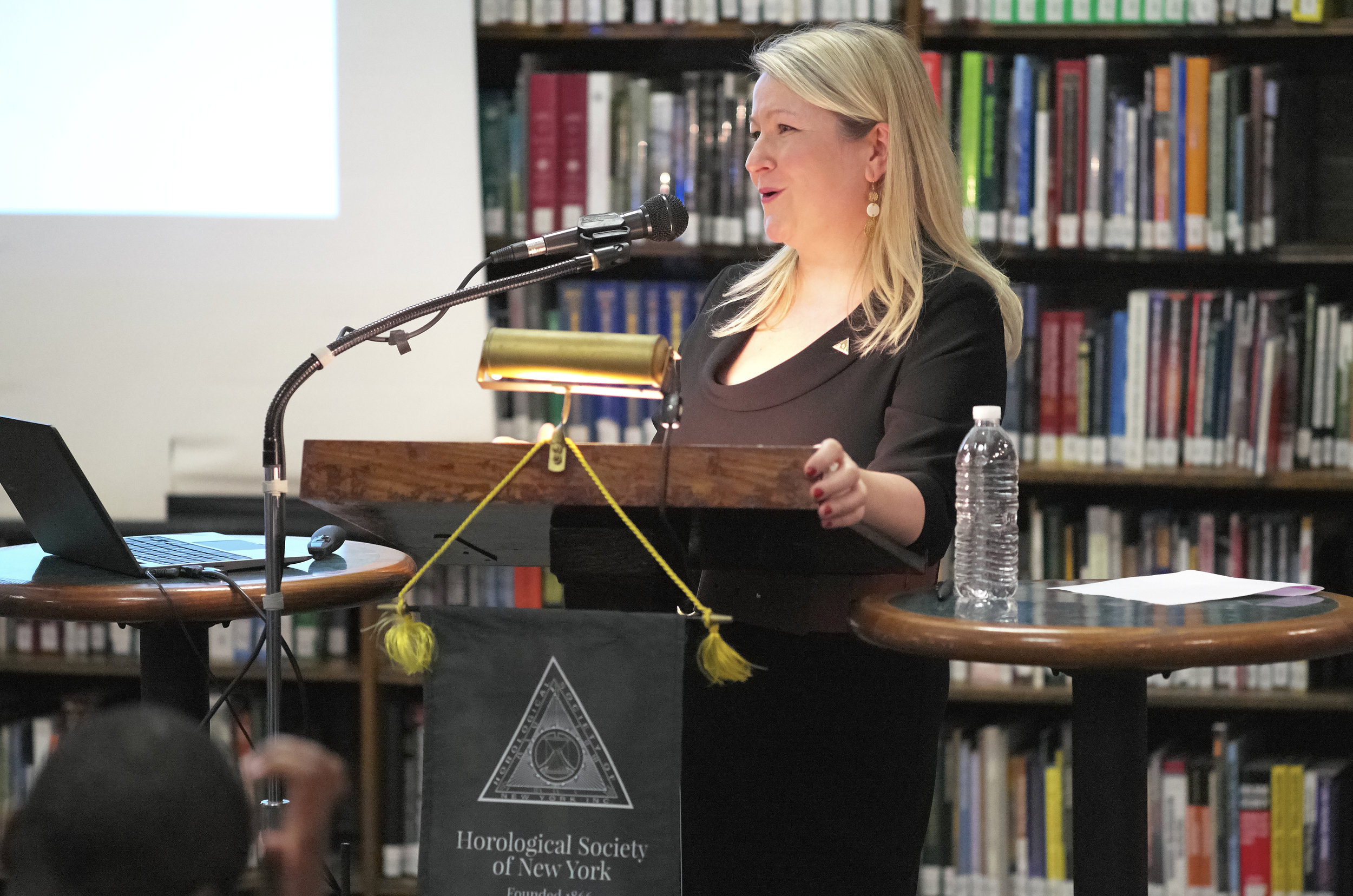
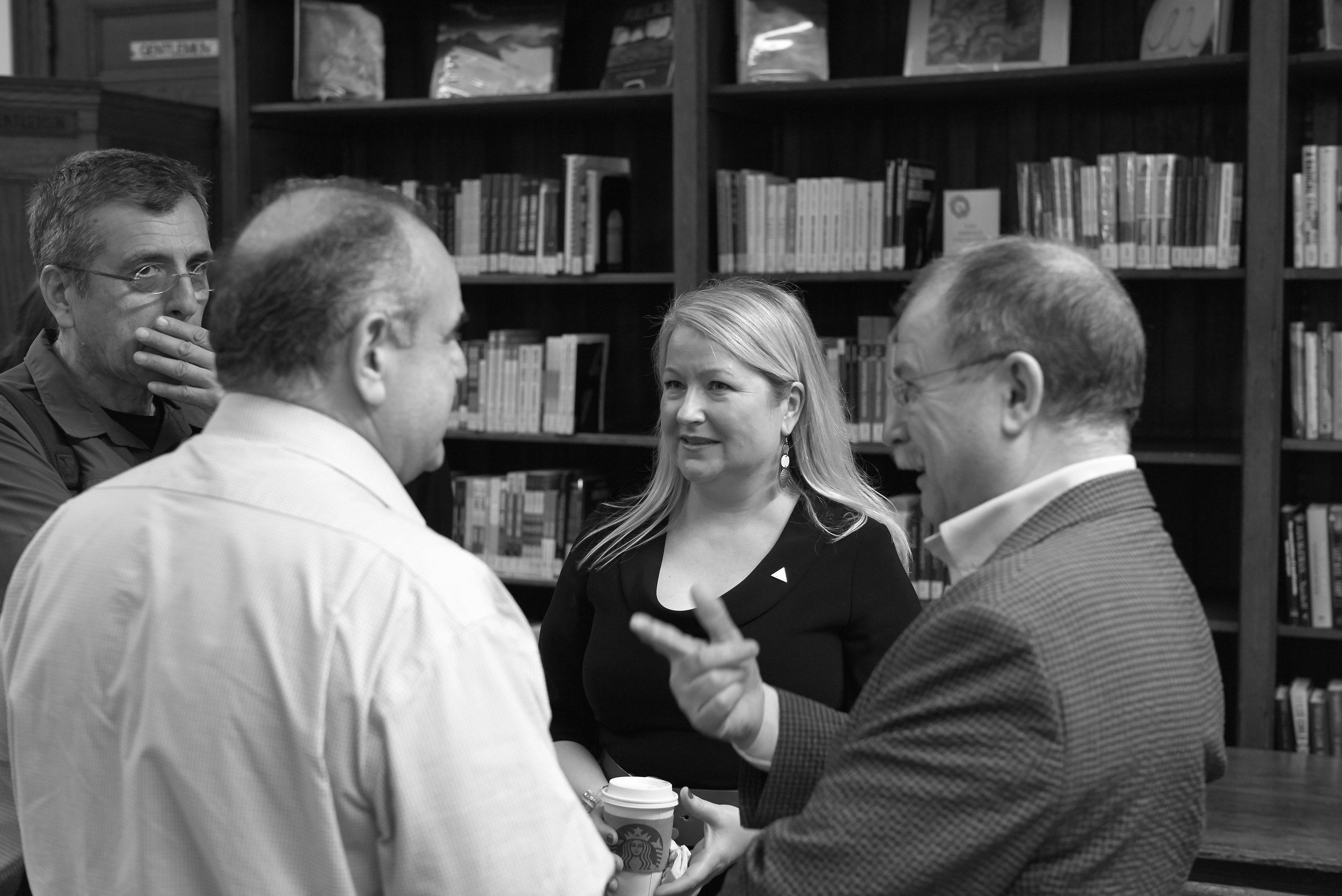
Event Recap: HSNY 2017 Annual Gala & Charity Auction
Video recordings of meetings are available to HSNY members.
On April 3rd, the Horological Society of New York celebrated its 151st anniversary with a gala dinner and charity auction in Midtown Manhattan. Members and guests from across the country gathered to celebrate New York's horological tradition, see the presentation of the Henry B. Fried Scholarship, and bid on a collection of vintage timepieces.
Steve Eagle (HSNY's Director of Education, right) presenting the 2017 Henry B. Fried Scholarship to Justin Shellenberger
The Henry B. Fried Scholarship was established to assist American watchmaking students in their studies at full-time watchmaking schools and was awarded for the first time at the 2017 Gala. HSNY's Director of Education, Steve Eagle, spoke on the merits of horological education and reflected on his time at watchmaking school. Eagle then introduced the 2017 Henry B. Fried Scholarship awardee to the crowd, Justin Shellenberger. Shellenberger is a first year student at the Lititz Watch Technicum in Pennsylvania. In his scholarship application, Shellenberger referenced the impact that the writing of Fried and Daniels made on his watchmaking ambitions.
Nicholas Dawes calling the HSNY 2017 Charity Auction
A collection of vintage timepieces bequeathed to HSNY over forty years ago was auctioned at the 2017 Gala, with proceeds going towards HSNY's newly established endowment fund. Bidding was enthusiastic, with over $30,000 raised from the five lots. The charity auction was made possible by HSNY sponsor Heritage Auctions, and called by Nicholas Dawes of PBS' Antiques Roadshow fame.
The crowd was a diverse mix of watchmakers, clockmakers, collectors, journalists, auctioneers and executives, reflecting the friendship and generosity of the NYC & US watch industry. Plans for HSNY's 2018 Gala are already underway, we are looking forward to seeing you there!
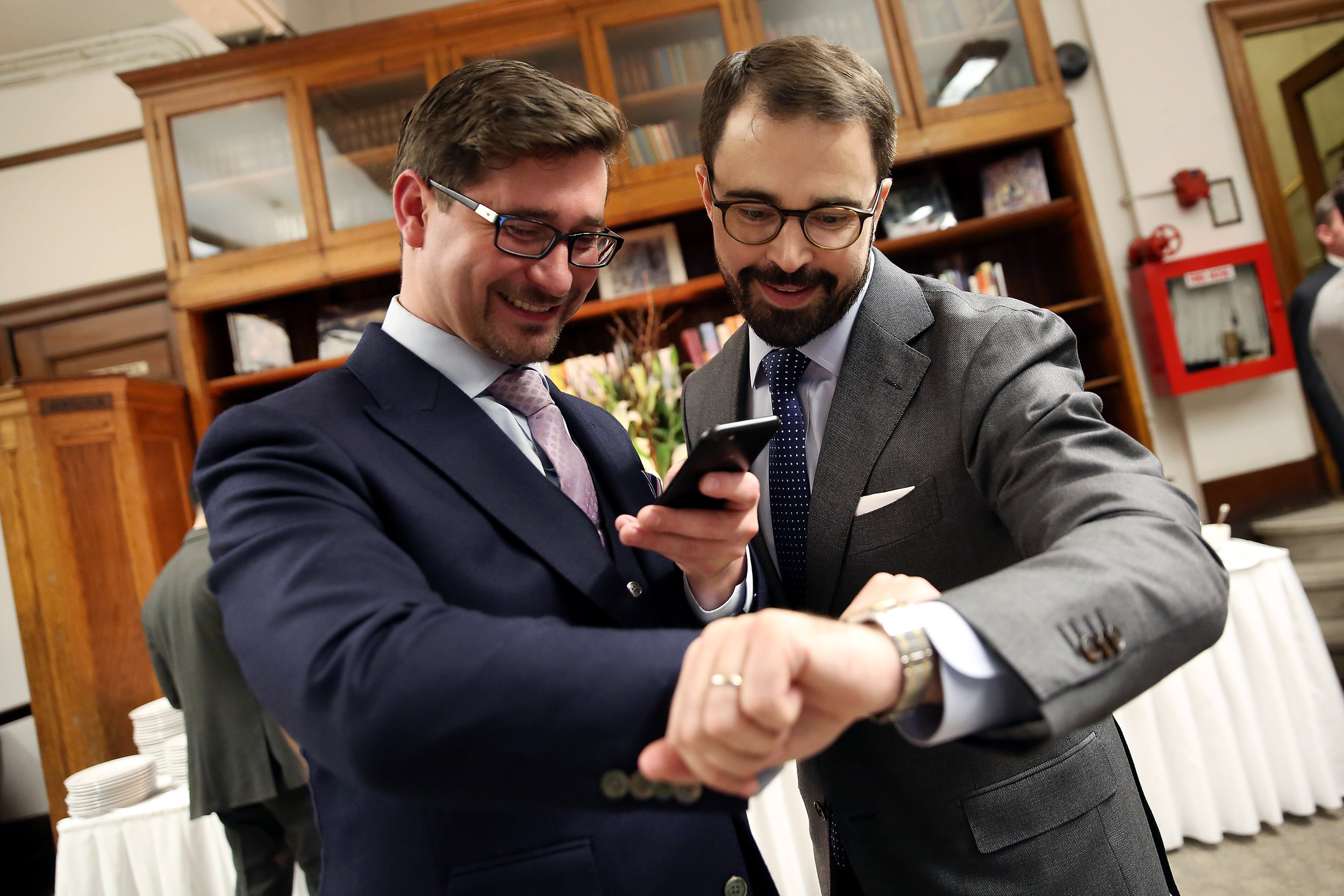
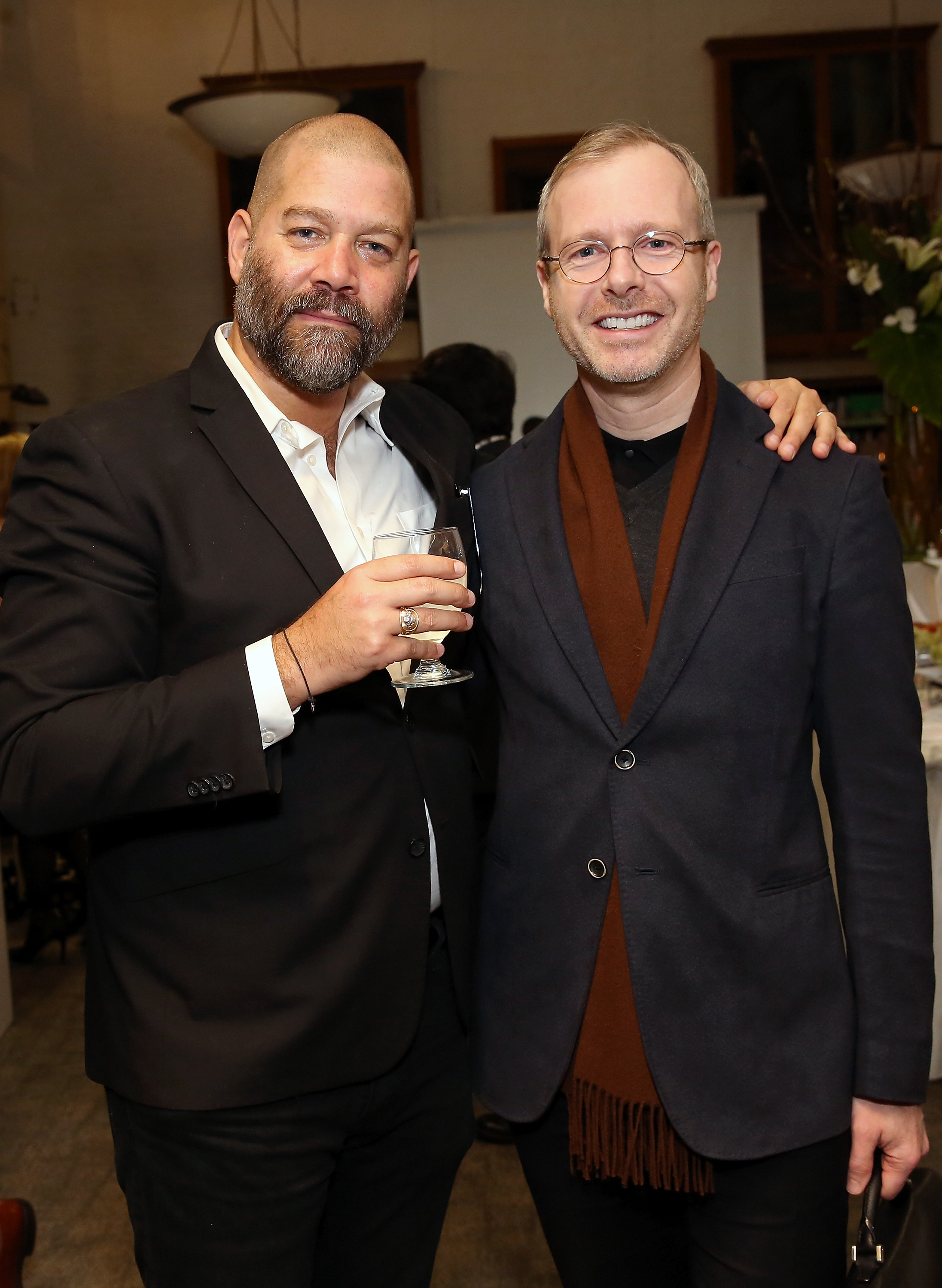
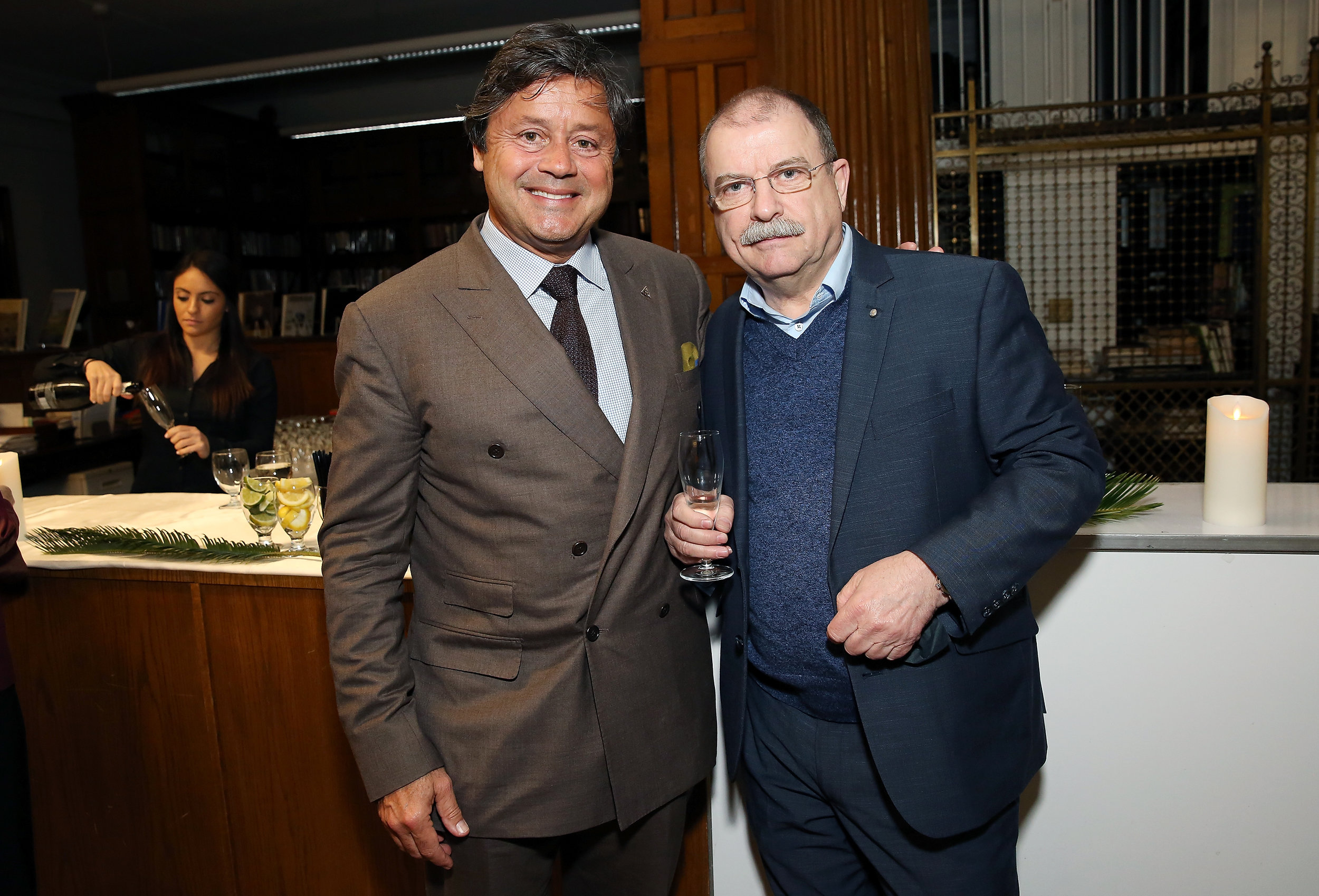

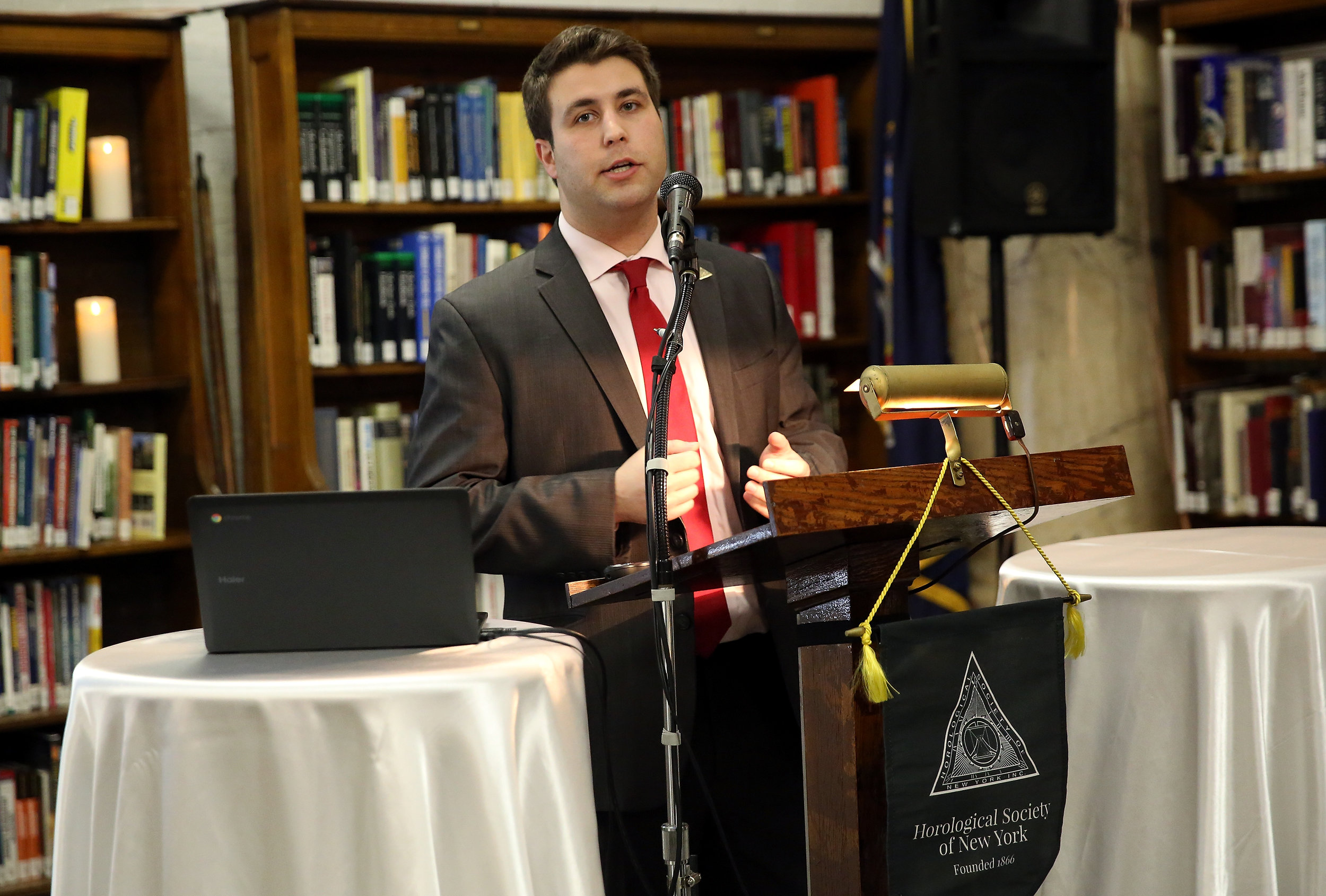
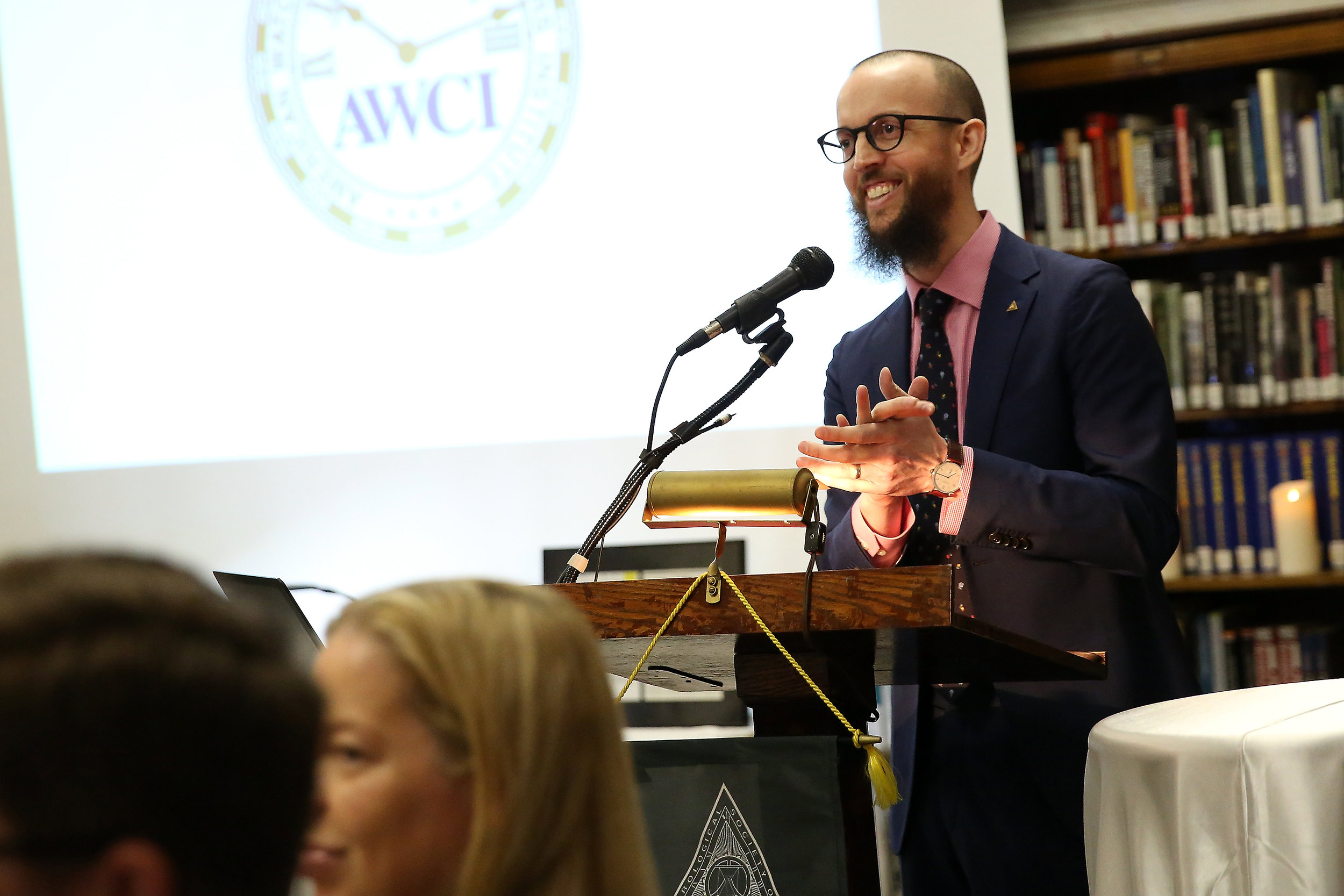
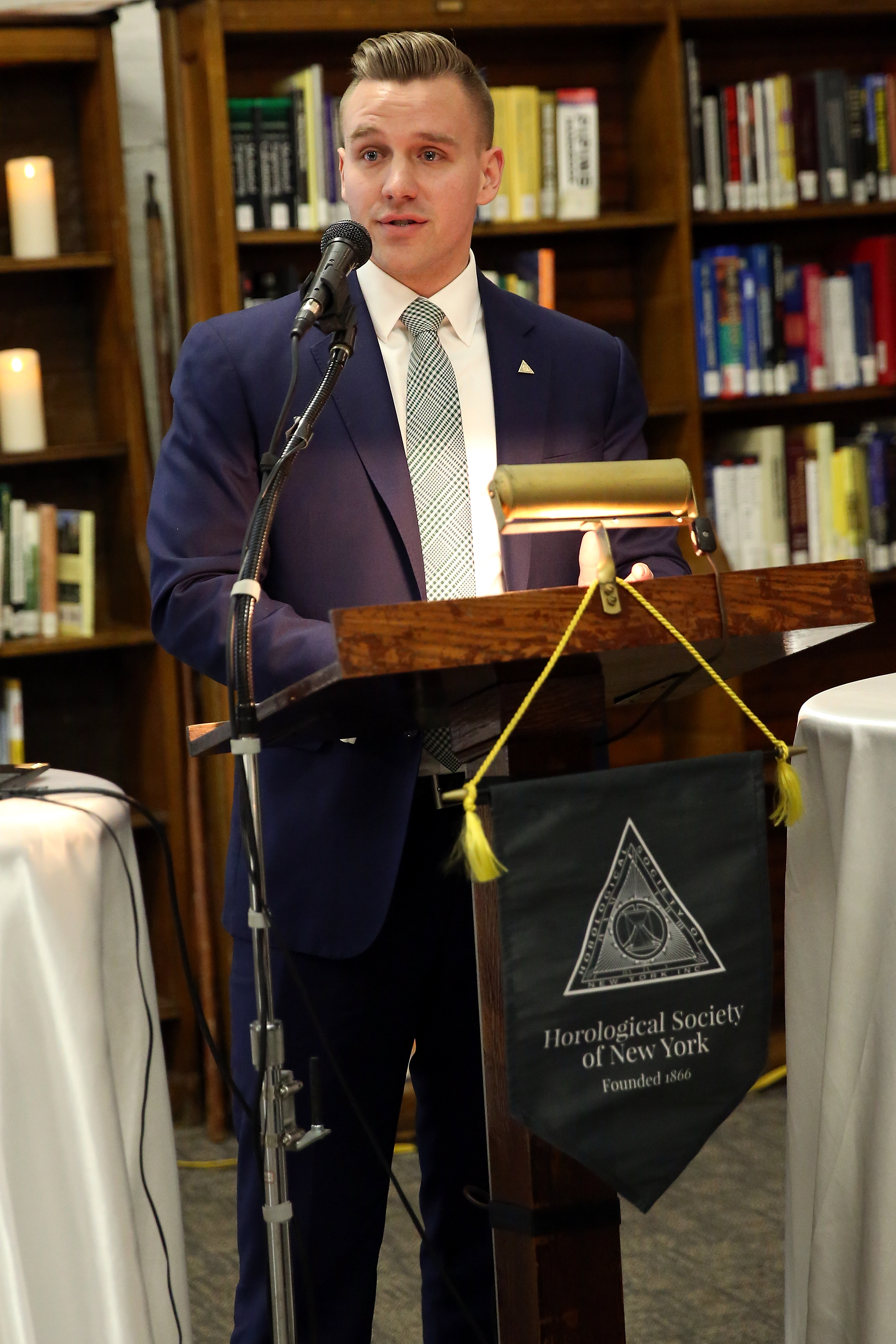
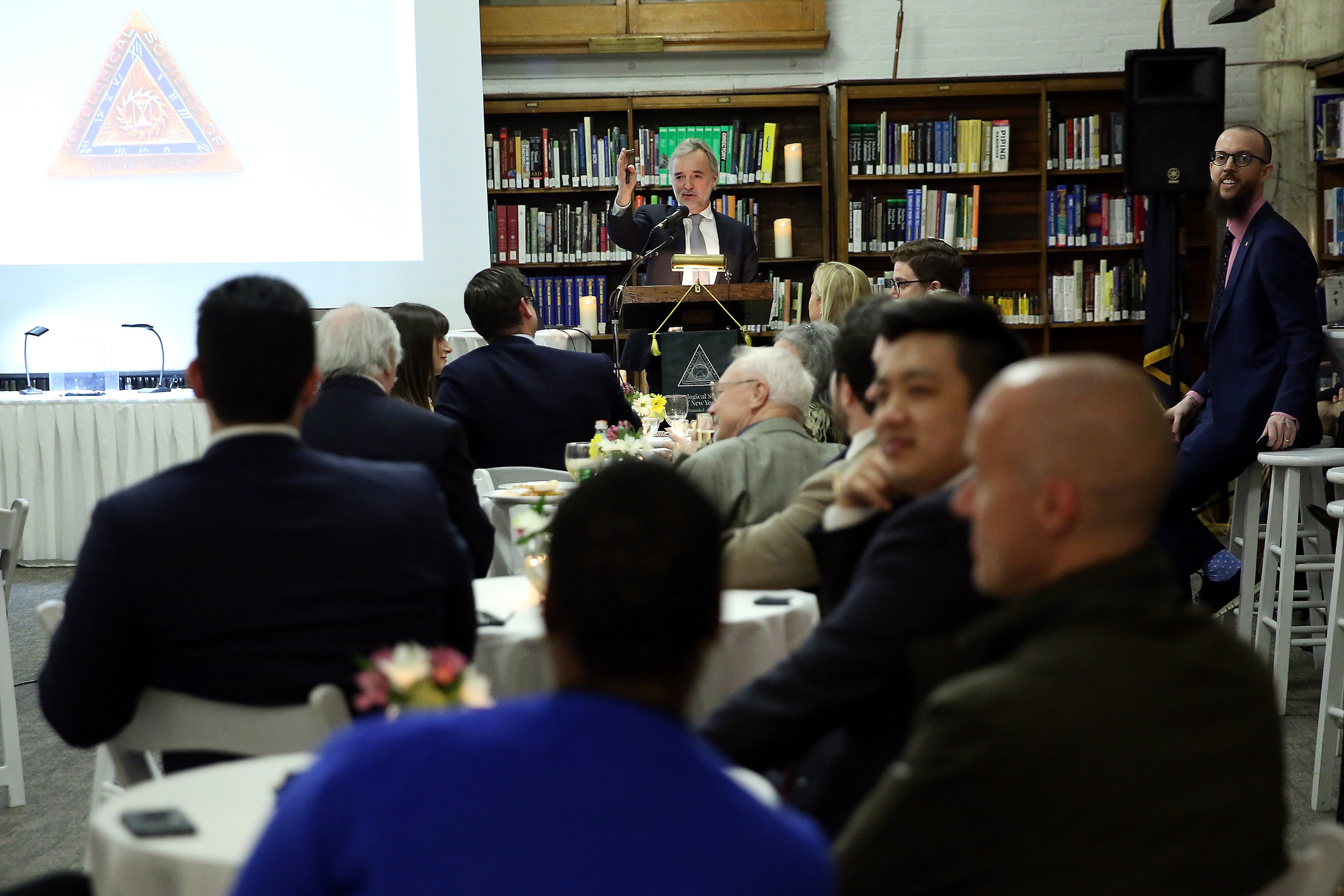
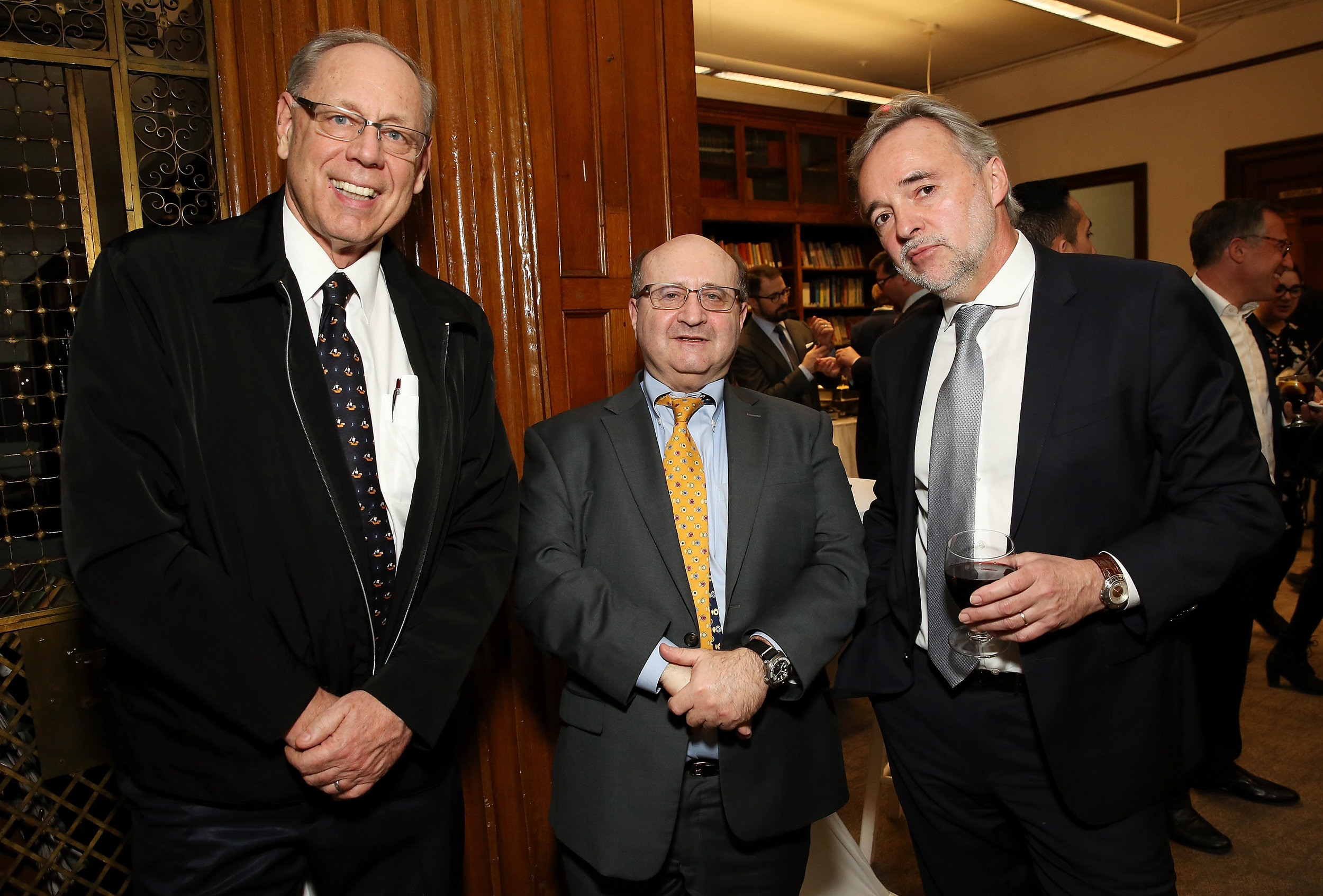


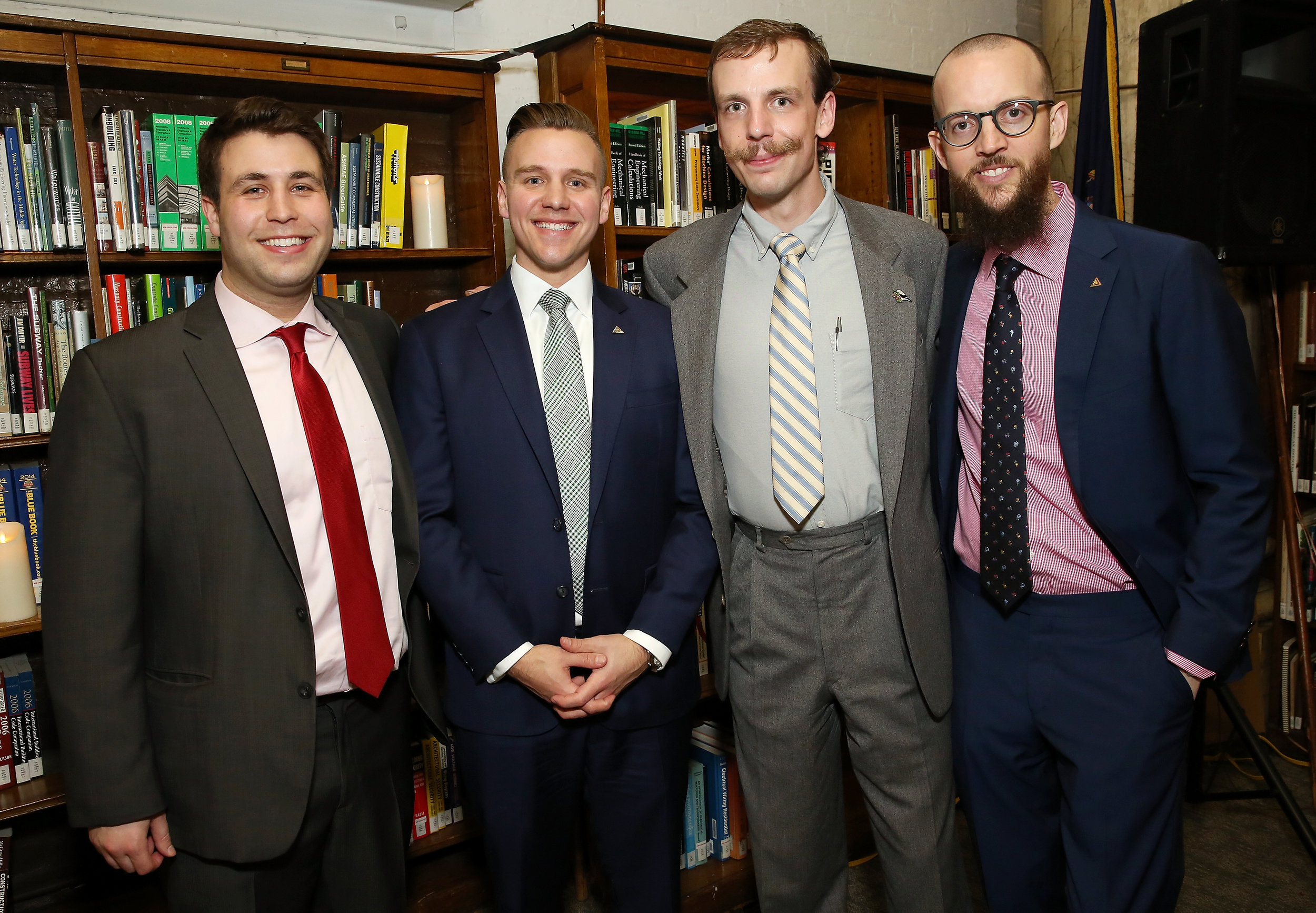
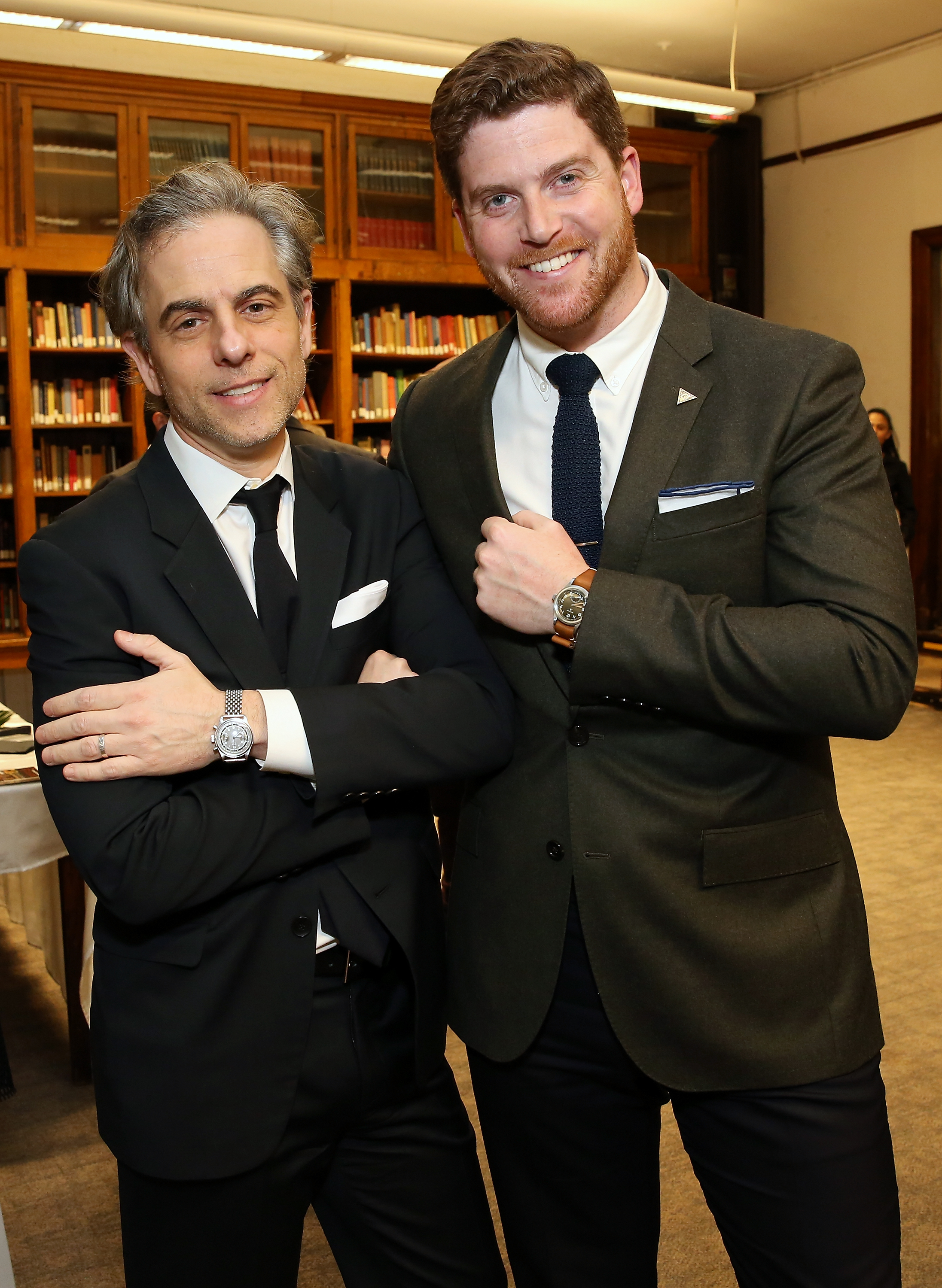
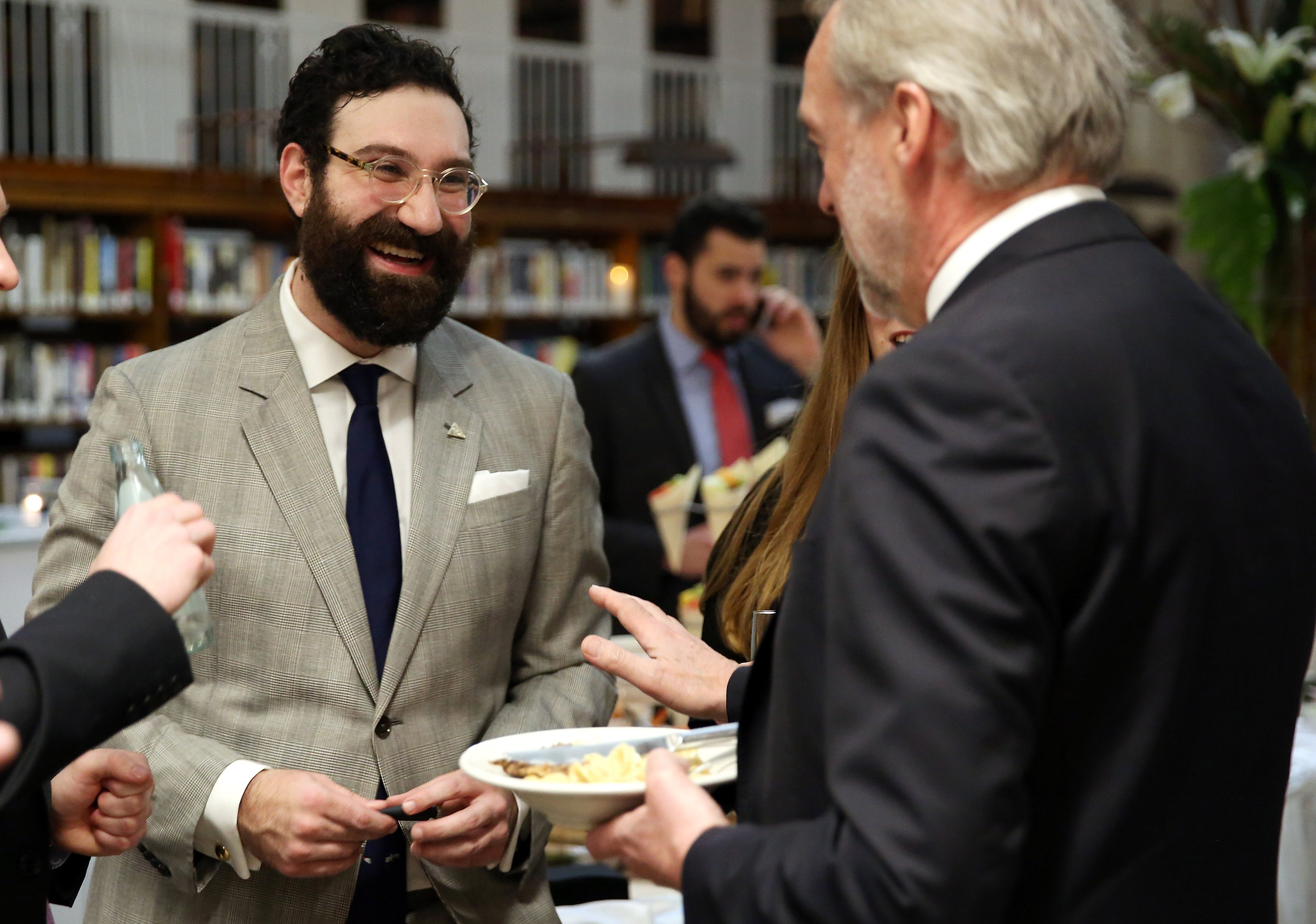

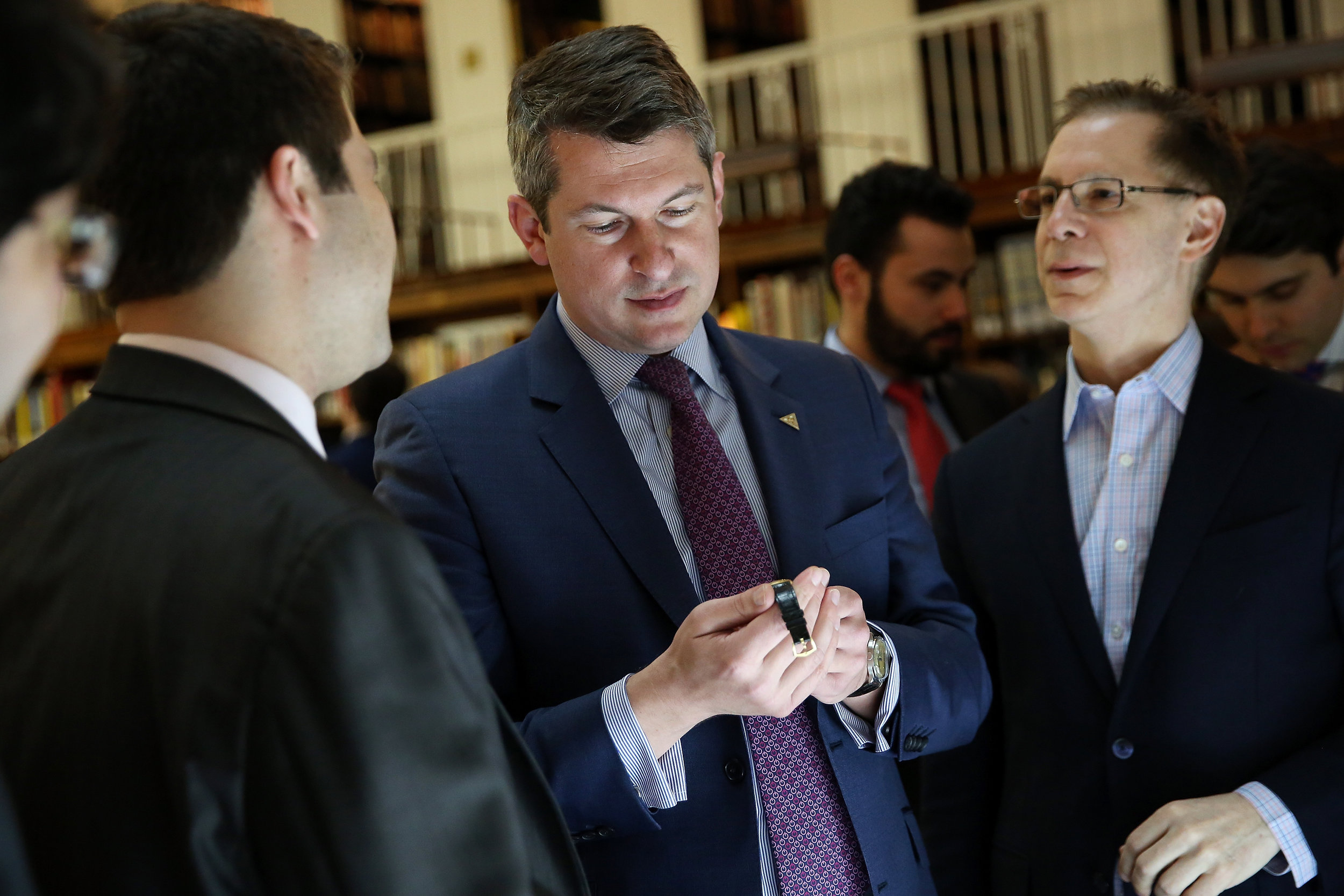
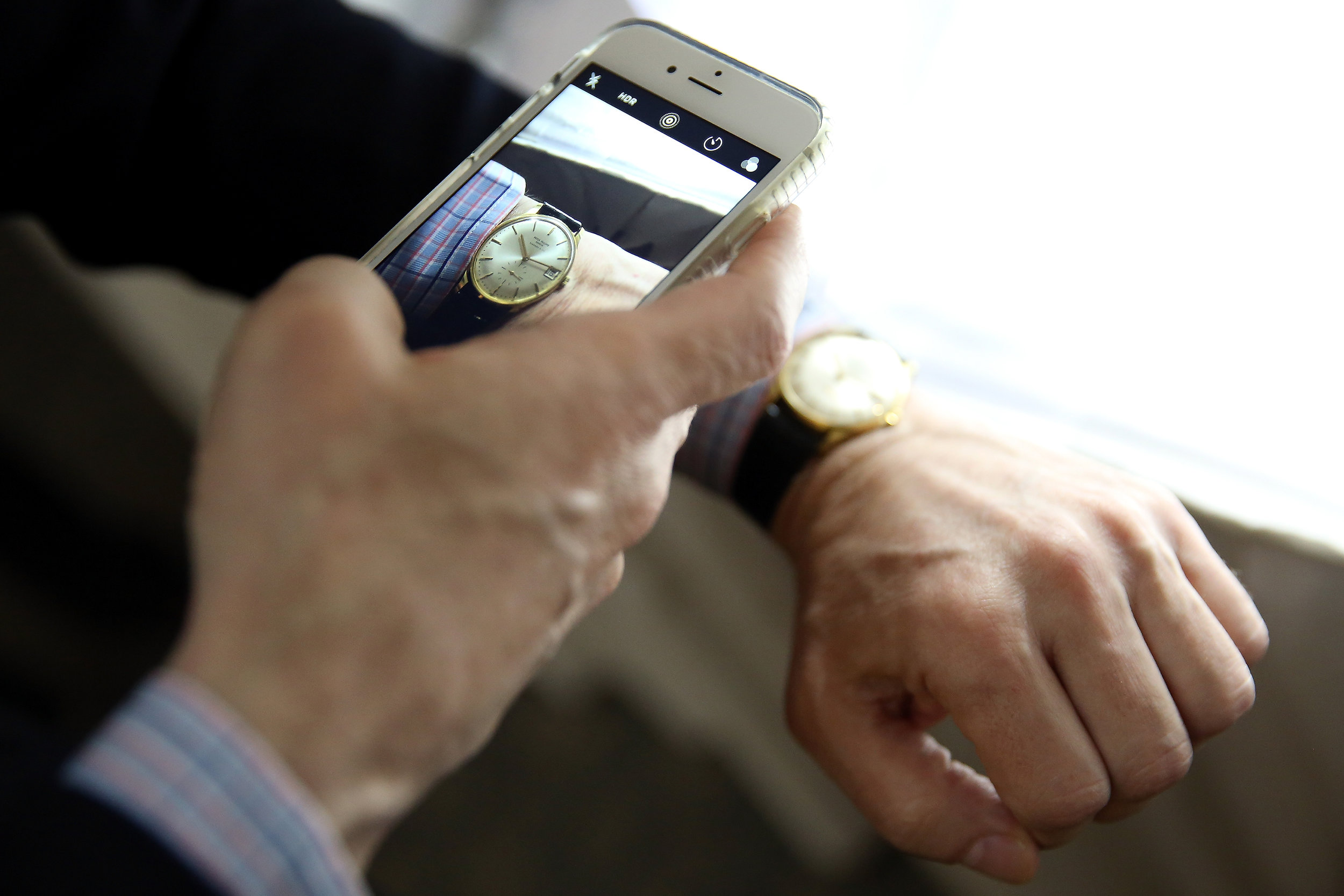
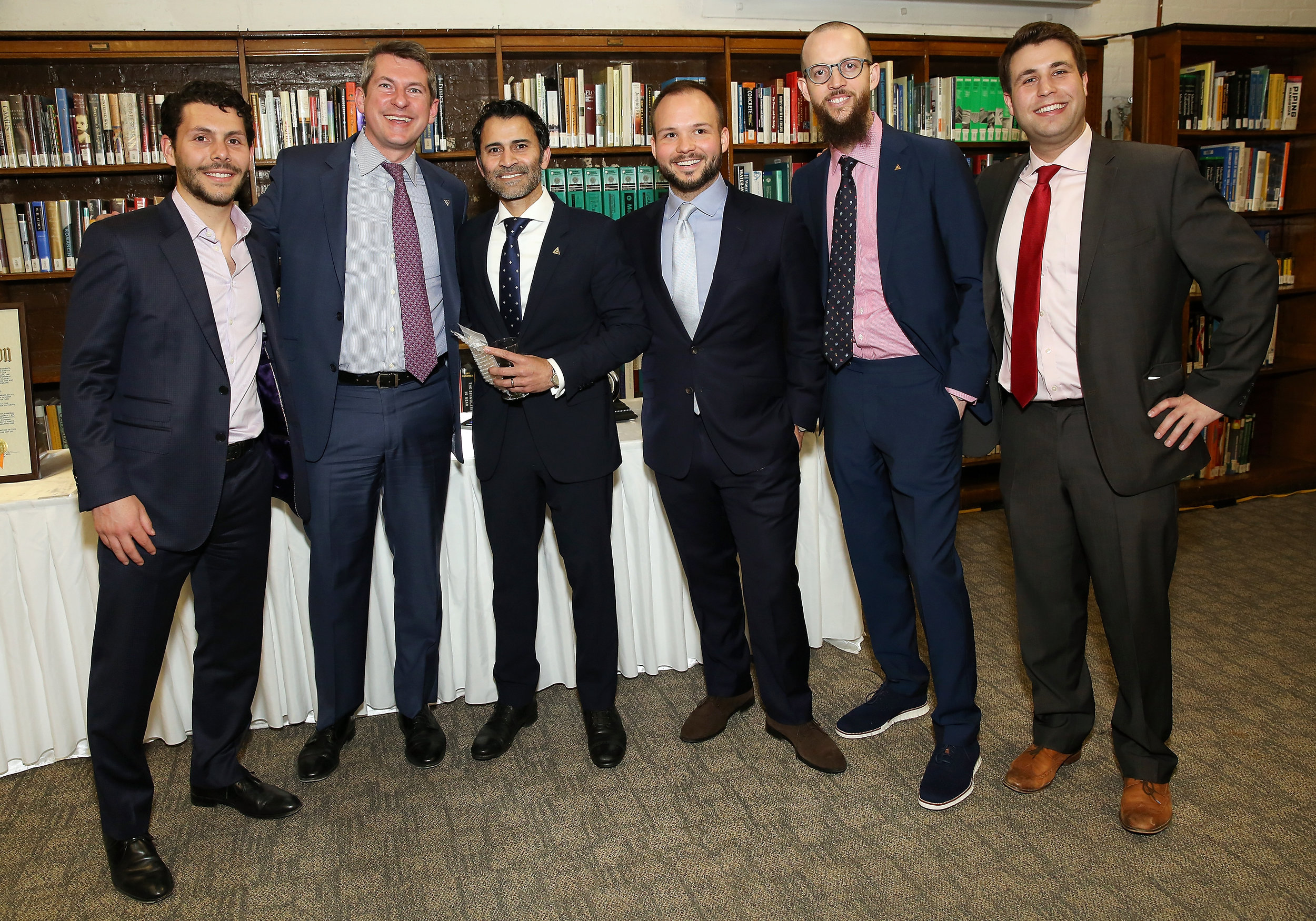
AWCI Teams up With Richter & Phillips Jewelers to Host an Afternoon at Their Museum Focused on Chronographs
The chronograph is one of the most widely loved complications in the watchmaking world. While it may seem simple to make those secondary hands start, stop, and reset there are many components which need to interact with one another precisely in order for the watch to perform correctly.
On April 22nd, the American Watchmakers-Clockmakers Institute hosts Richter & Phillips Jewelers’ watchmaker Matthew Schloemer, CW21 at their museum near Cincinnati as he lectures on the chronograph mechanism, its history, and its function. Matthew will demonstrate several different chronograph movements and point out key differences between them. He will dive beneath the dial and illustrate from the watchmaker’s perspective all the moving parts and how they interact.
The afternoon event is the first of what AWCI hopes will be many technical events for collectors. Each event will have limited seating and be both social and educational. The $50 registration fee will support watchmaking education and those in attendance will enjoy cocktails and light refreshments, tour the Orville R. Hagans History of Time museum, peruse the library collections, and sit down in their state-of-the-art classroom for a technical presentation.
Limited seats available. Register at awcimuseum.eventbrite.com
7th Annual Madison Avenue Watch Week, May 8-13, 2017
Madison Avenue will once again become the epicenter of haute horlogerie during the 7th Annual Madison Avenue Watch Week. Slated this year for May 8-13, Madison Avenue’s premiere watch retailers and brands will preview their newest and most exceptional timepieces that recently debuted at Baselworld and at SIHH in Switzerland, along with a weeklong immersion into the art of watchmaking.
Open to the public, premier watch brands are welcoming enthusiasts and collectors with special events and offerings during business hours in the participating Madison Avenue stores located between 57th and 86th Streets. For more information, a calendar of events, a map and to request an invitation, visit (new edition of the website coming soon): www.madisonavenuewatchweek.com.
Madison Avenue Watch Week is presented by the Madison Avenue Business Improvement District (BID) and sponsored by The Wall Street Journal. The event is supported by the Horological Society of New York.
Meeting Recap: How to Win (and Sometimes Lose) at Watch Auctions
William Massena - Managing Director of TimeZone.com
March 6, 2017
Video recordings of meetings are available to HSNY members.
The speaker at the March 6th meeting of the Horological Society of New York was William Massena, well-known expert in the field of buying and selling watches. In his second lecture at HSNY, Massena gave practical advise on how to deal with auction houses. Some of the largest firms, such as Phillips, Christies and Sotheby's, handle only high end timepieces. Several others share the growing watch auction market, soliciting bids internationally.
It is up to the buyer to be knowledgable about their potential purchase. Sometimes catalogue descriptions are not sufficient and may be exaggerated. Massena suggests doing your homework, reading a condition report about the watch from the auctioneer and personally inspecting it, if possible. These are valuable tips for collectors and investors who undoubtably drive the auction market. HSNY thanks Massena for his great presentation.
Submitted by Walter Pangretitsch, Recording Secretary, HSNY
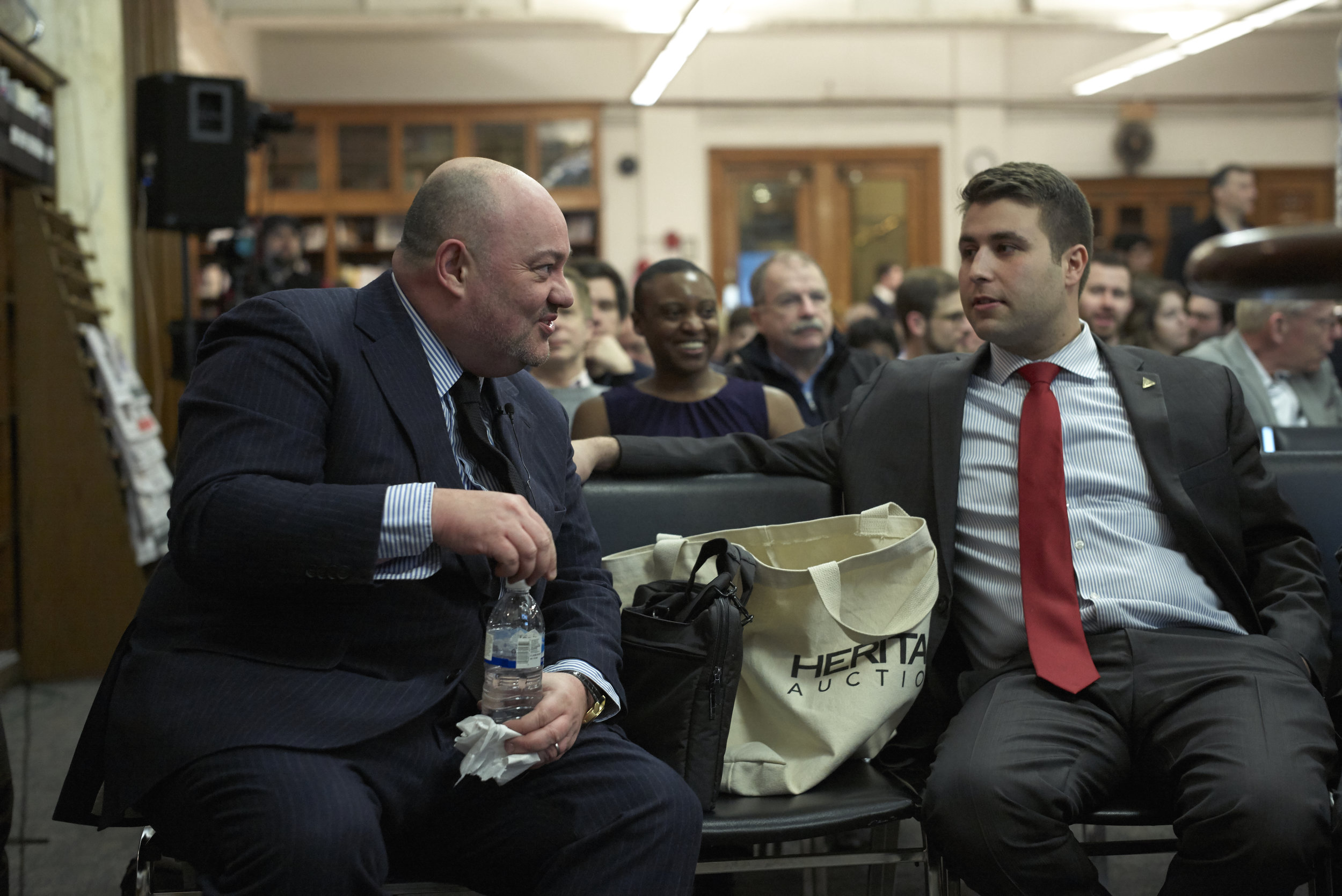
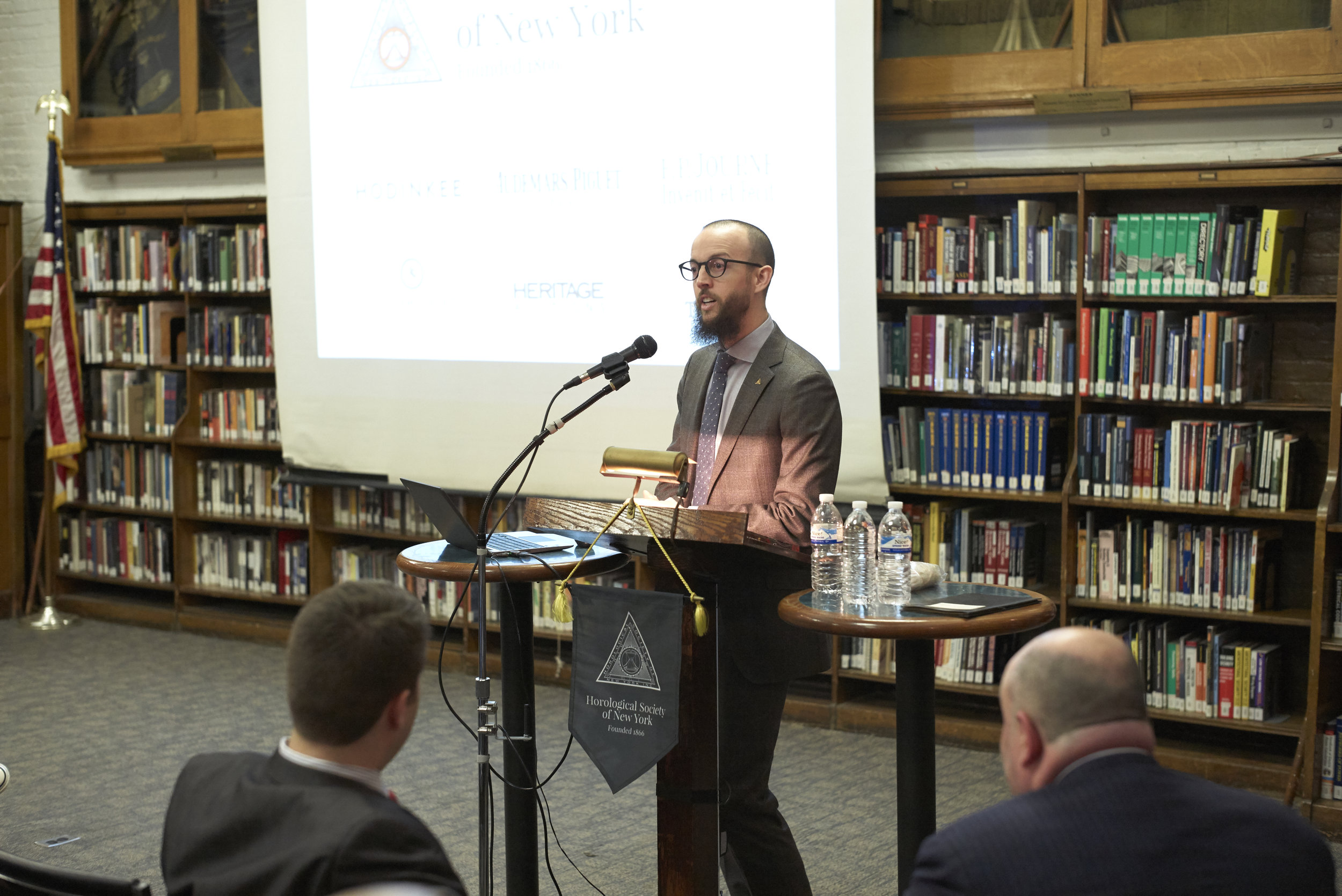
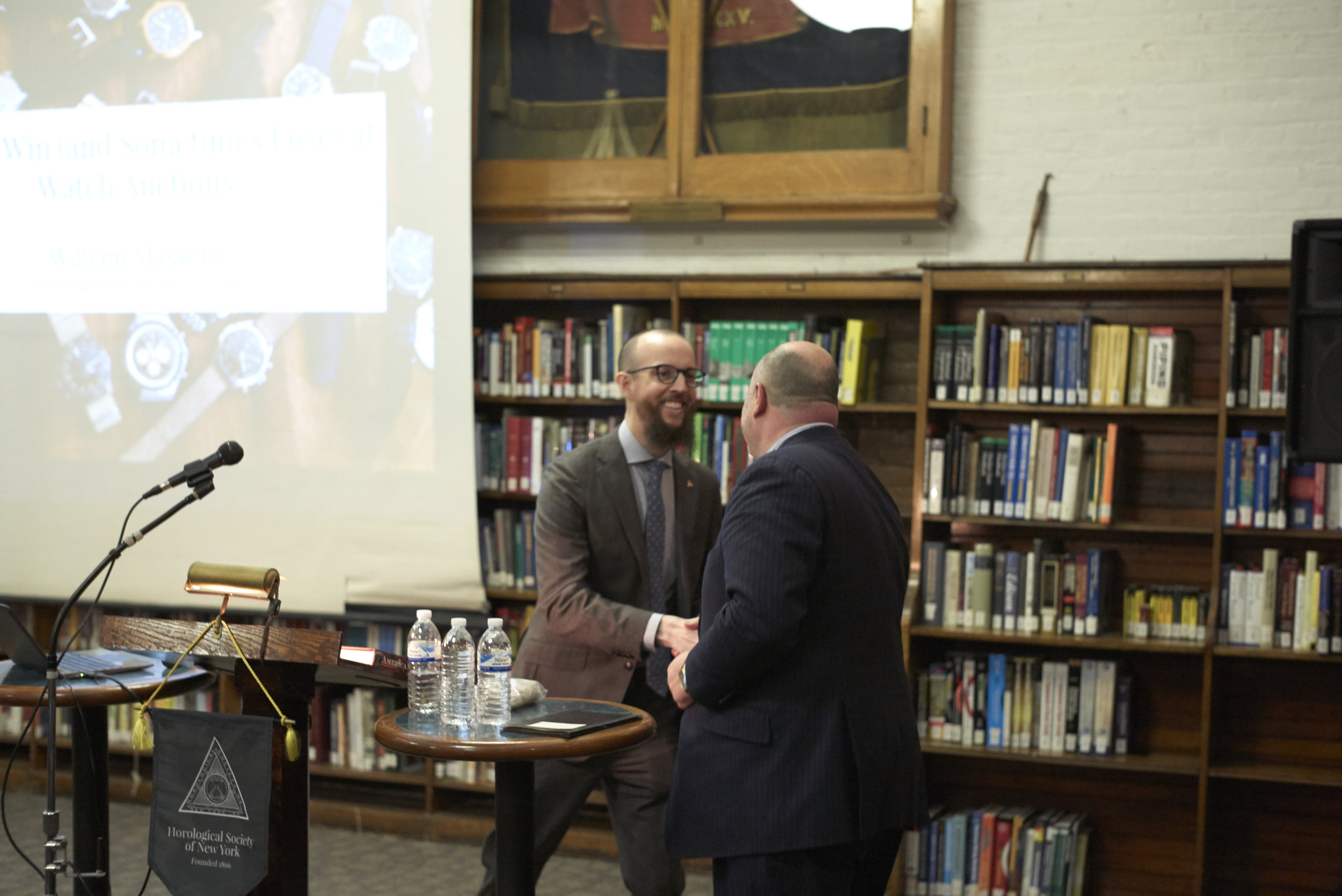
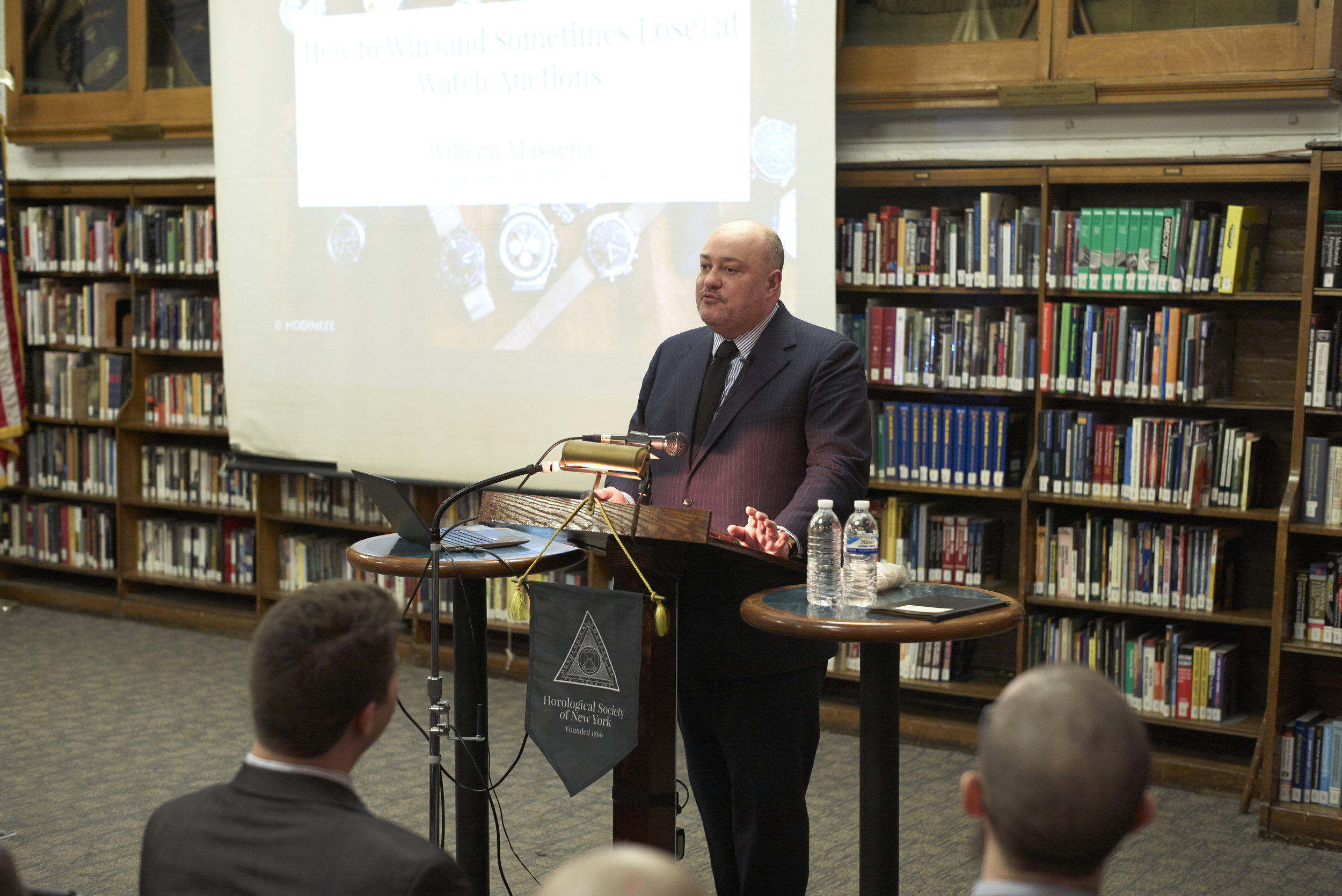
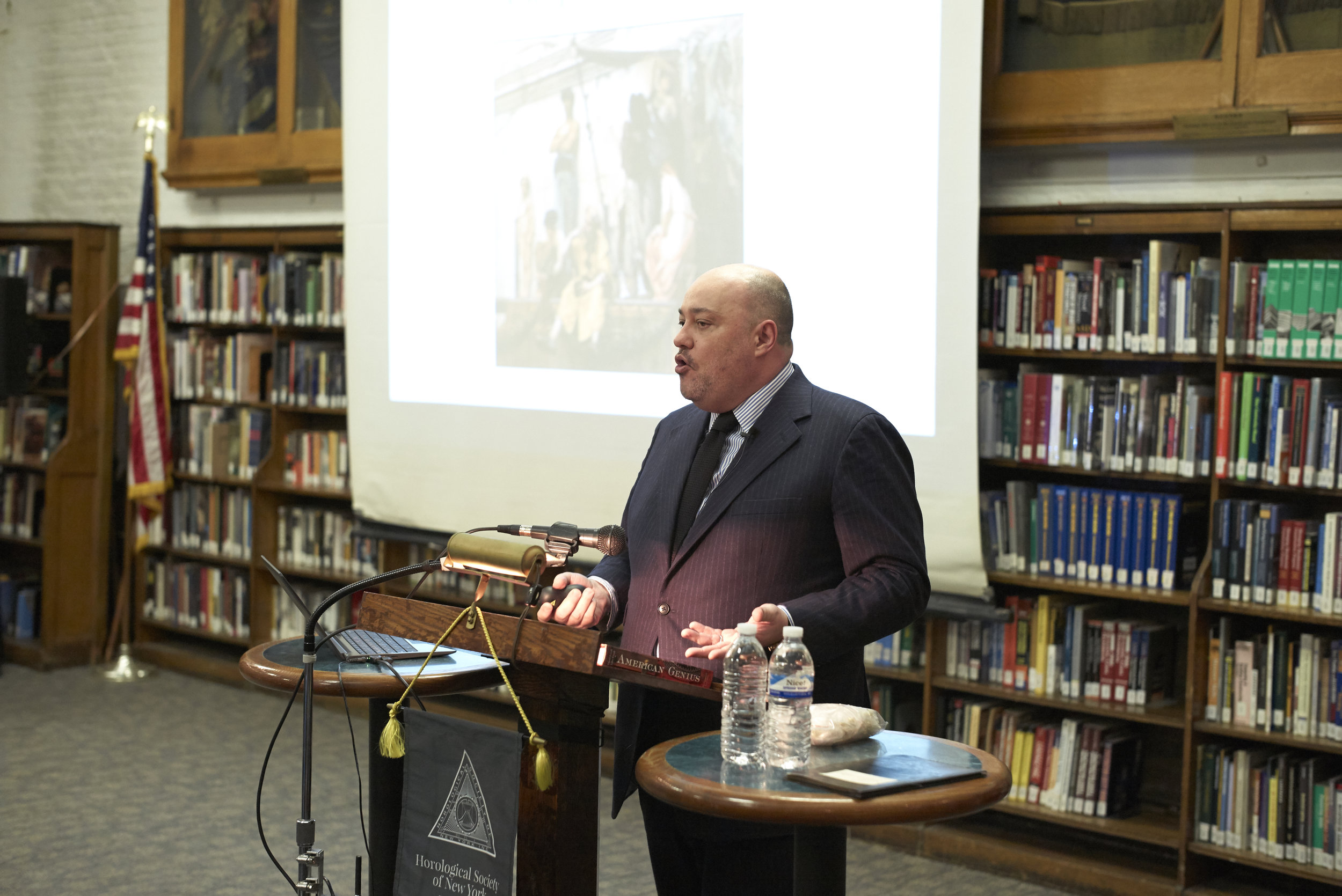
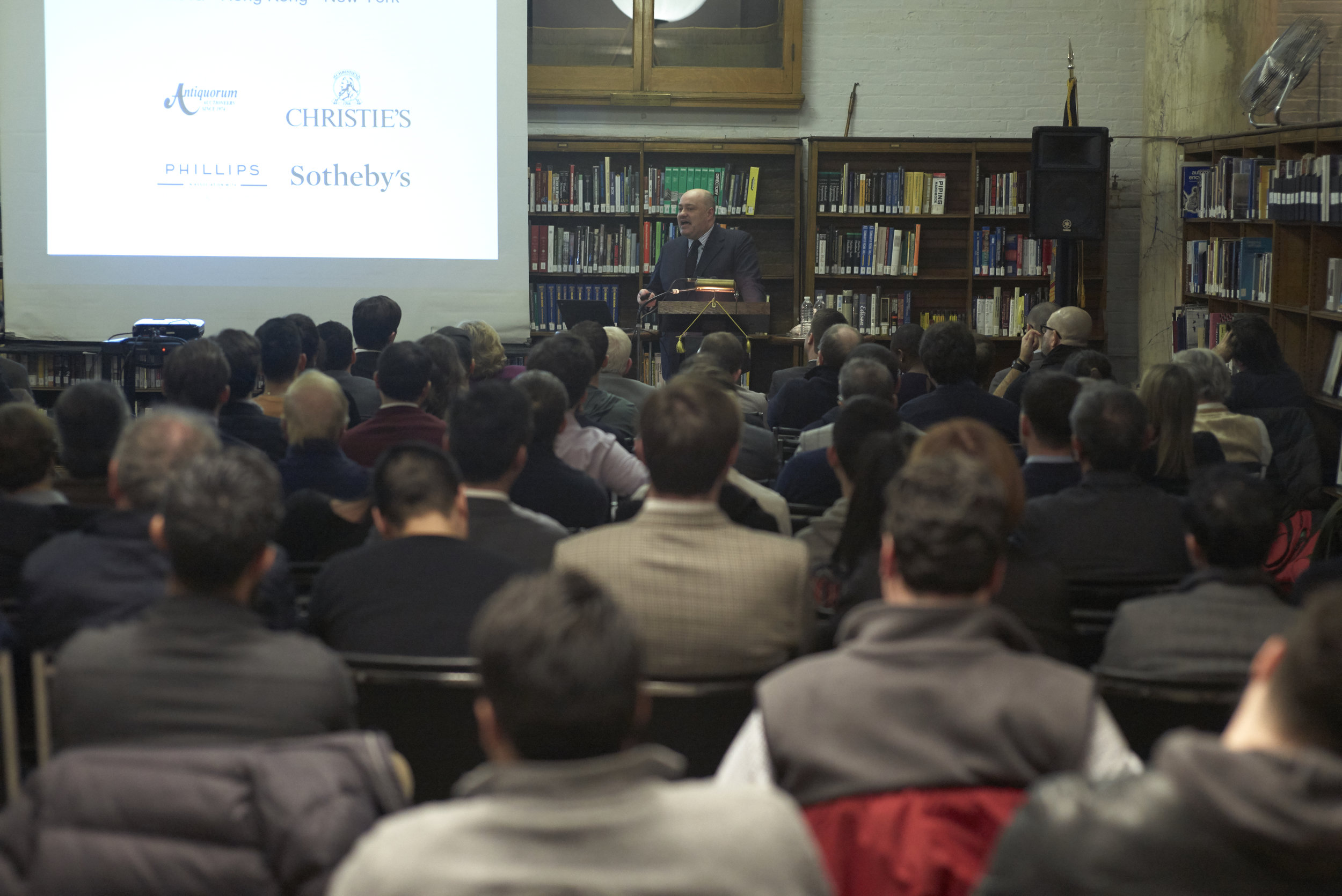
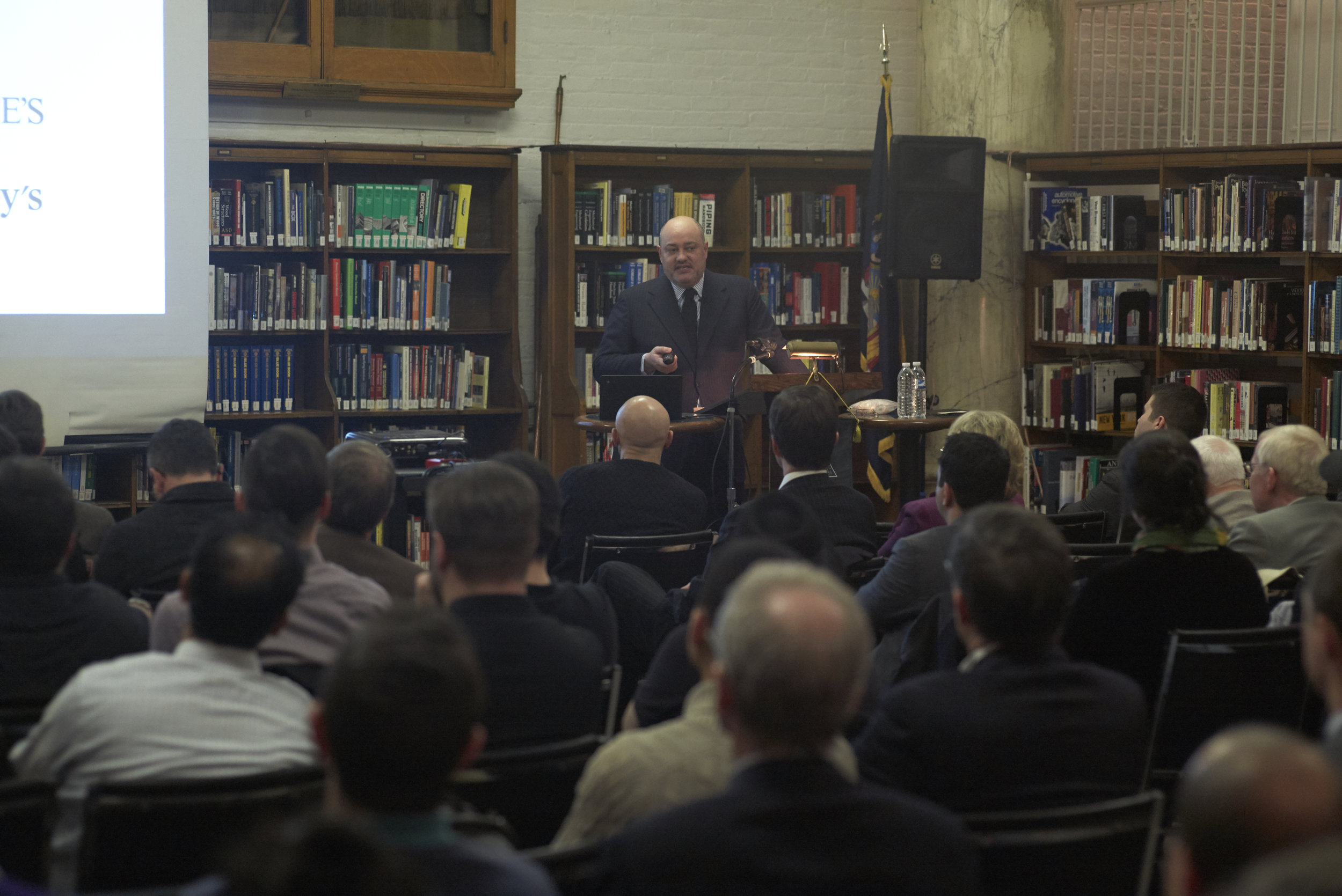
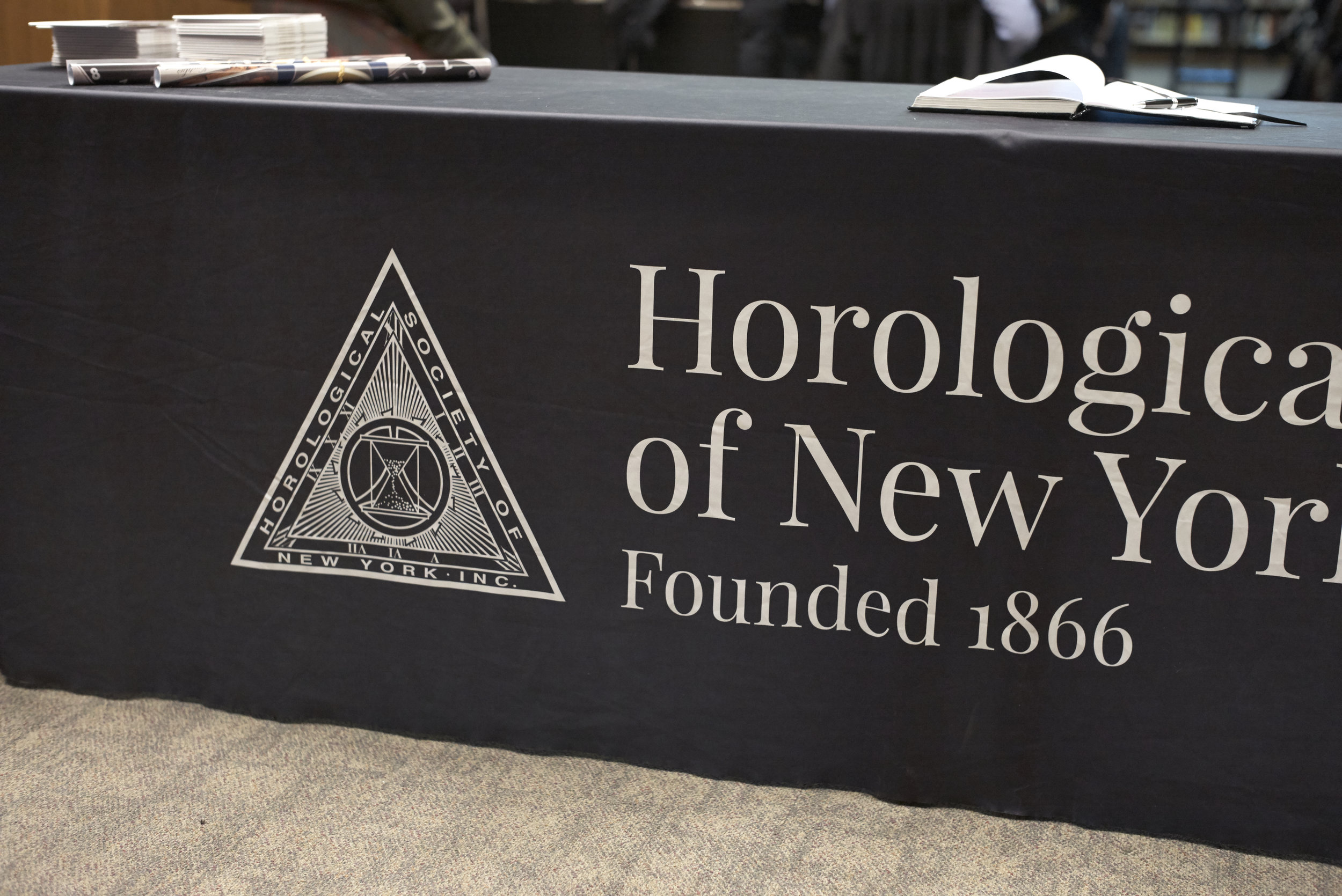

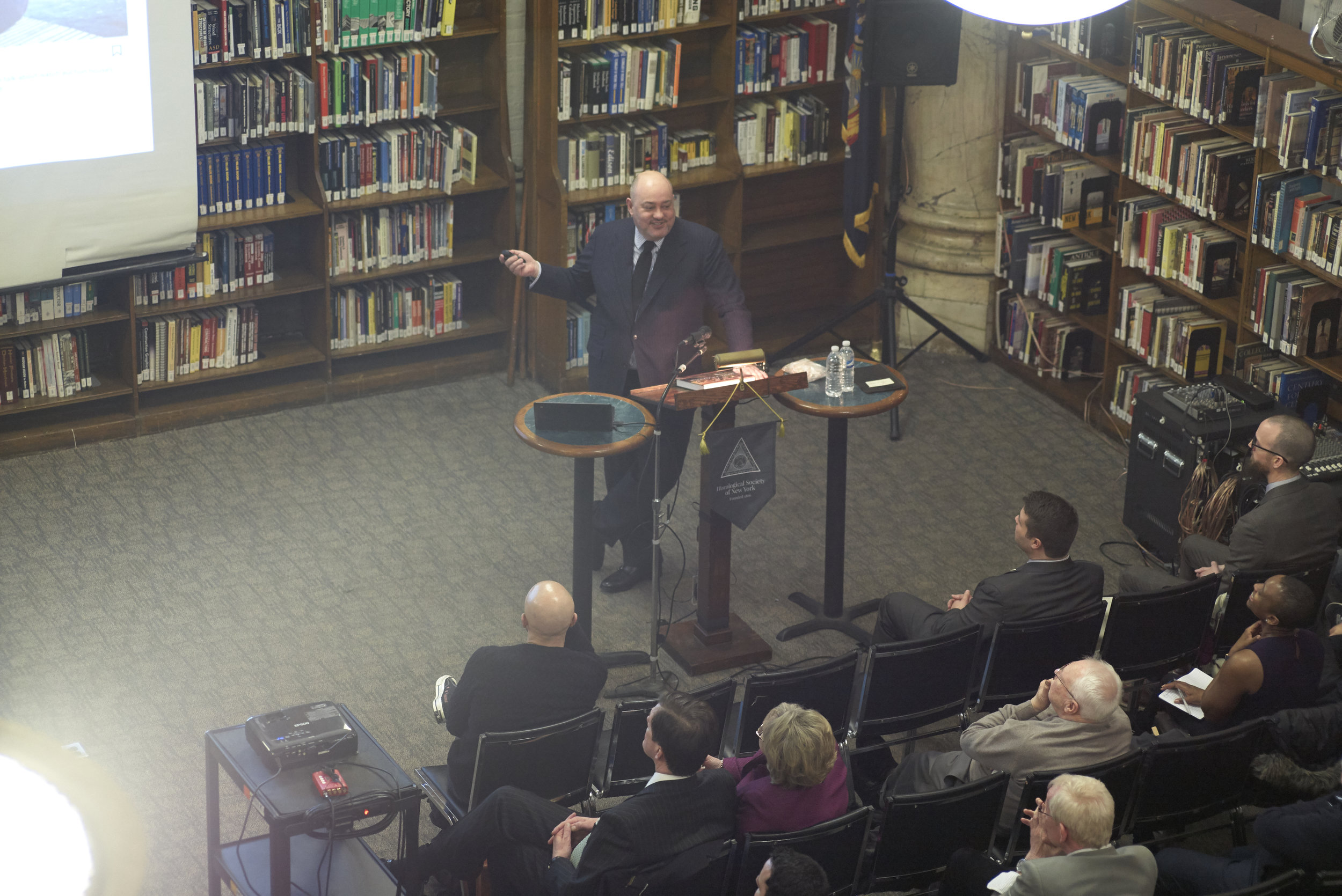

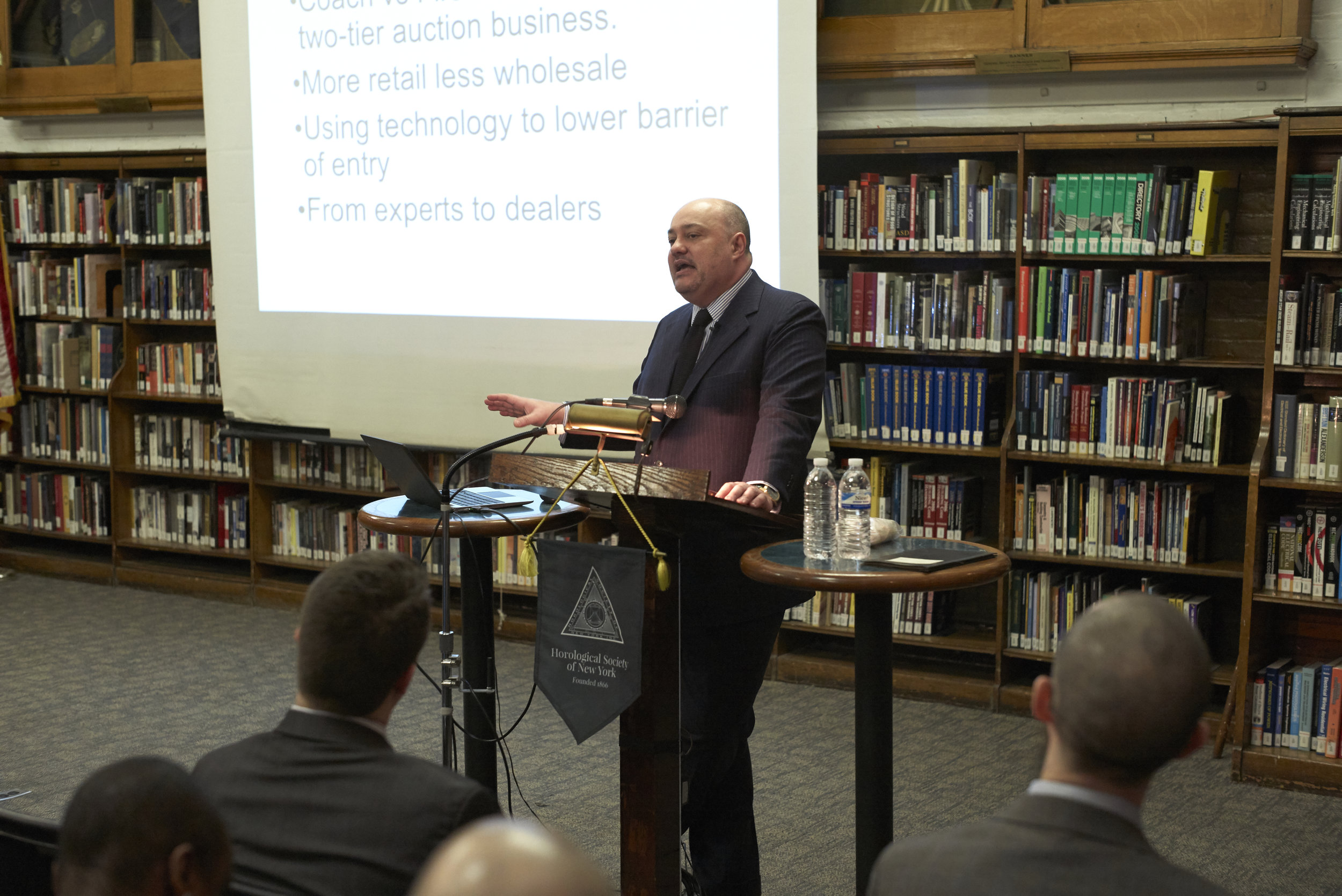

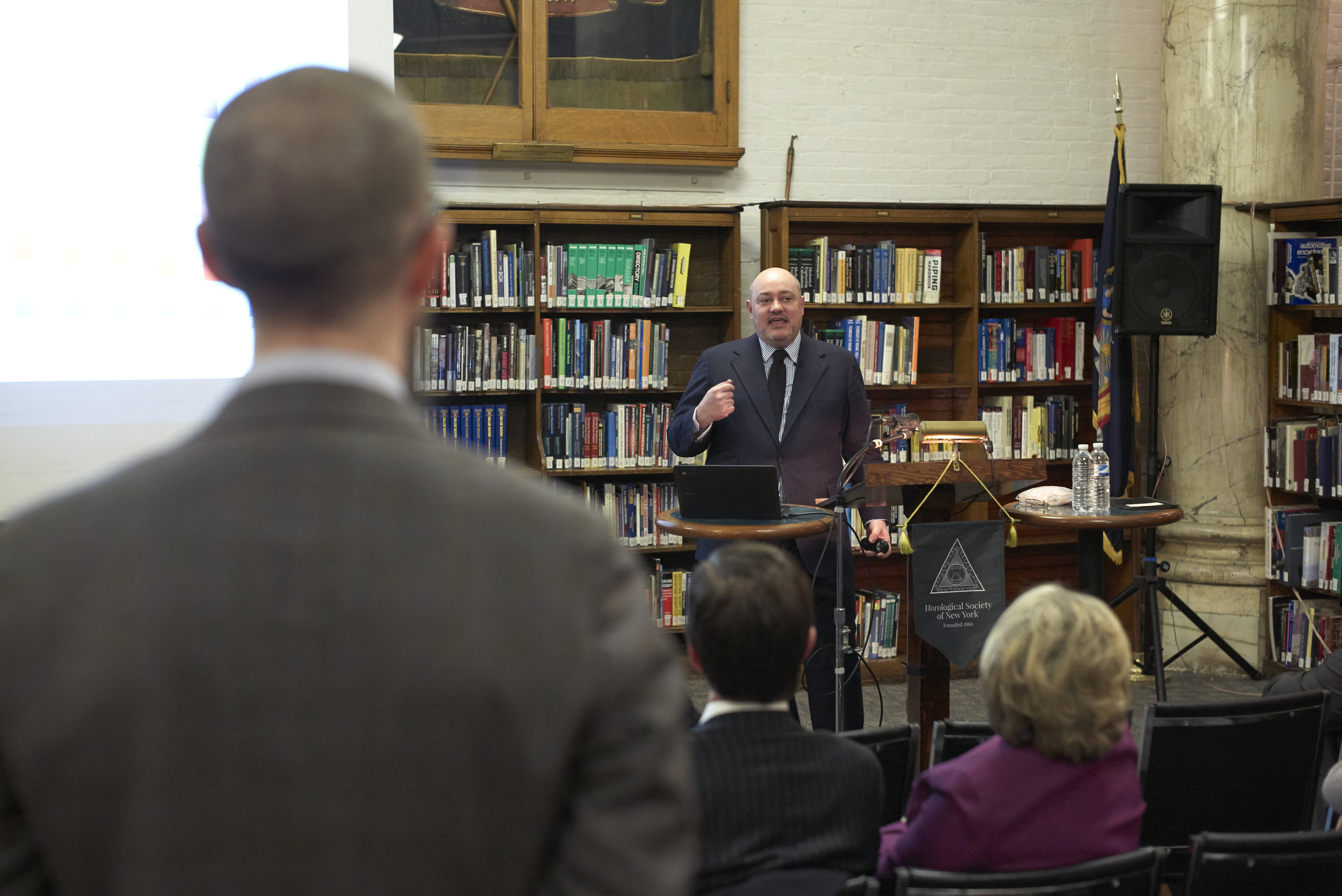
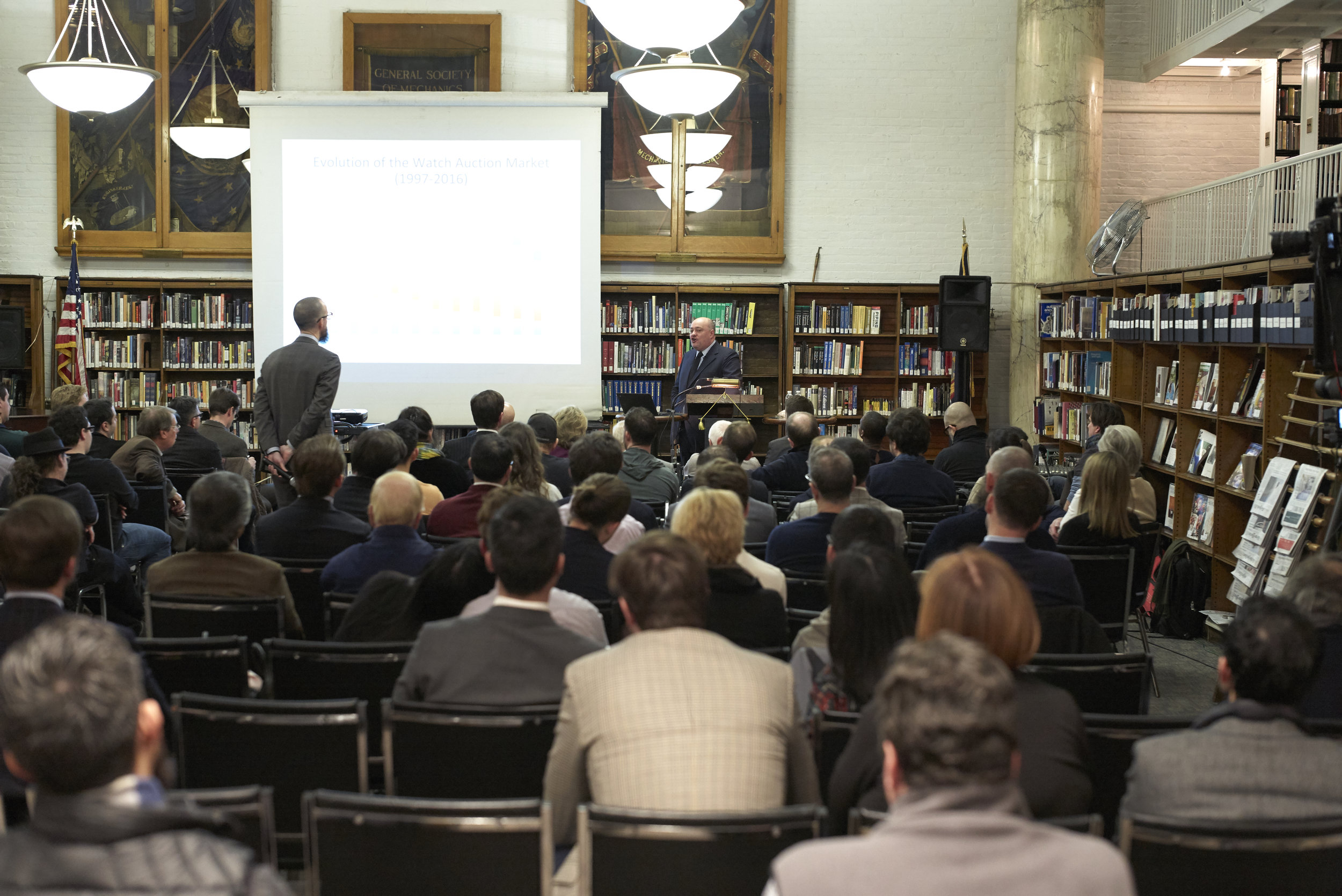
Meeting Recap: Time is Money - How to Make a Living in the World of Watches
John Reardon - International Head of Watches, Christie's
February 6, 2017
Video recordings of meetings are available to HSNY members.
It seemed like the entire membership was present at the February 6th meeting of the HSNY. Extra chairs were set up in the General Society Library to accommodate the large audience. The speaker of the evening, Mr. John Reardon, discussed various people connected with the watchmaking industry, including their beginning and what motivates them today. Names mentioned were Andrew Walden, Rudy Albers, Nicholas Manousos, Benjamin Clymer, Michael Friedman, Katie Reed, Atom Moore, among many others. Their success stories are inspirational to anyone hoping to participate in the world of watches today.
Mr. Reardon asked his interviewees how they got started in their respective fields and what advice they would give to others. The overwhelming answer was dedication to their jobs, enjoying what they do with a passion and sharing their knowledge and enthusiasm with others. They comprise a select group who keep the wheels turning in the watchmaking business.
Our thanks to Mr. Reardon for this extraordinary presentation.
Submitted by Walter Pangretitsch, Recording Secretary, HSNY
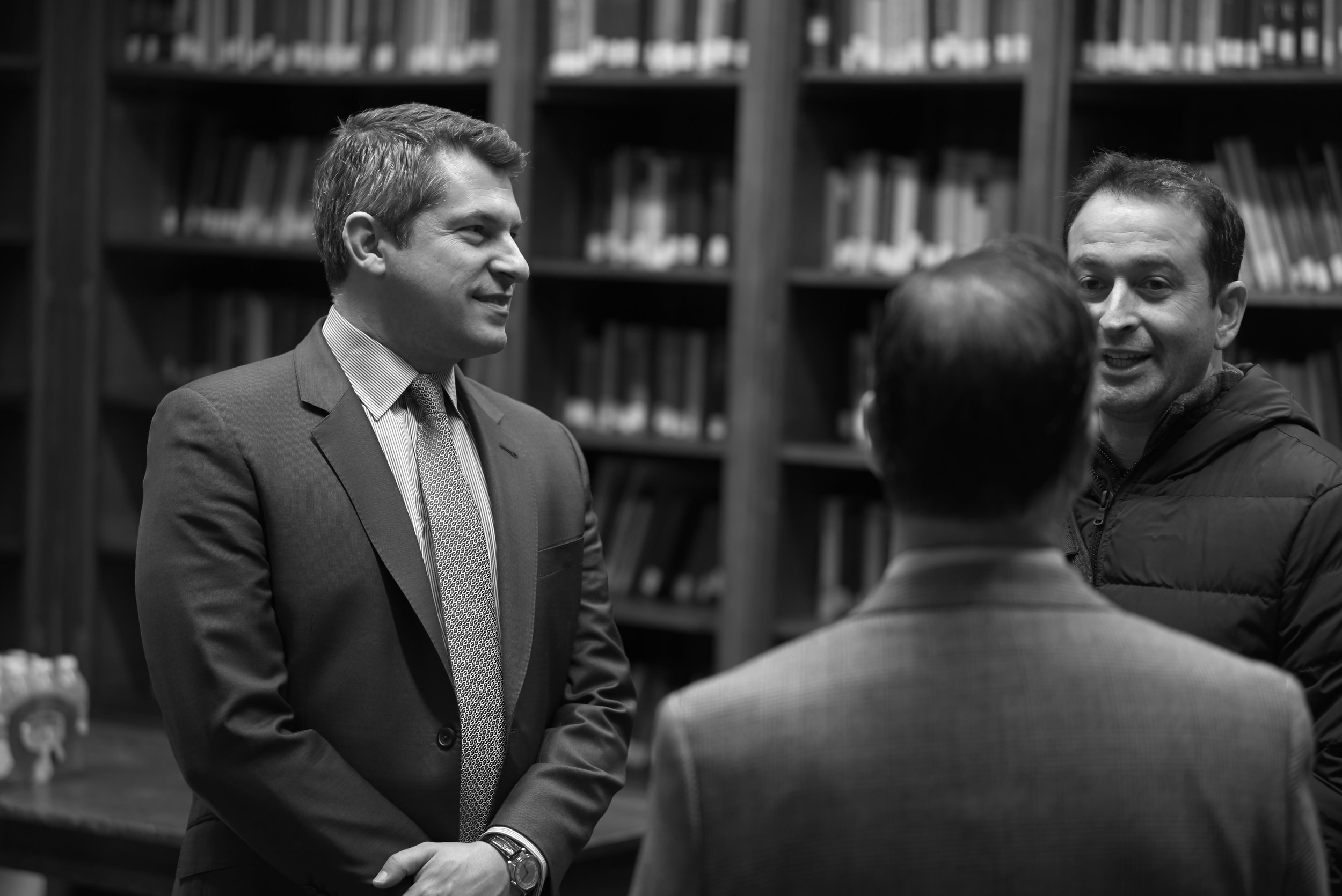



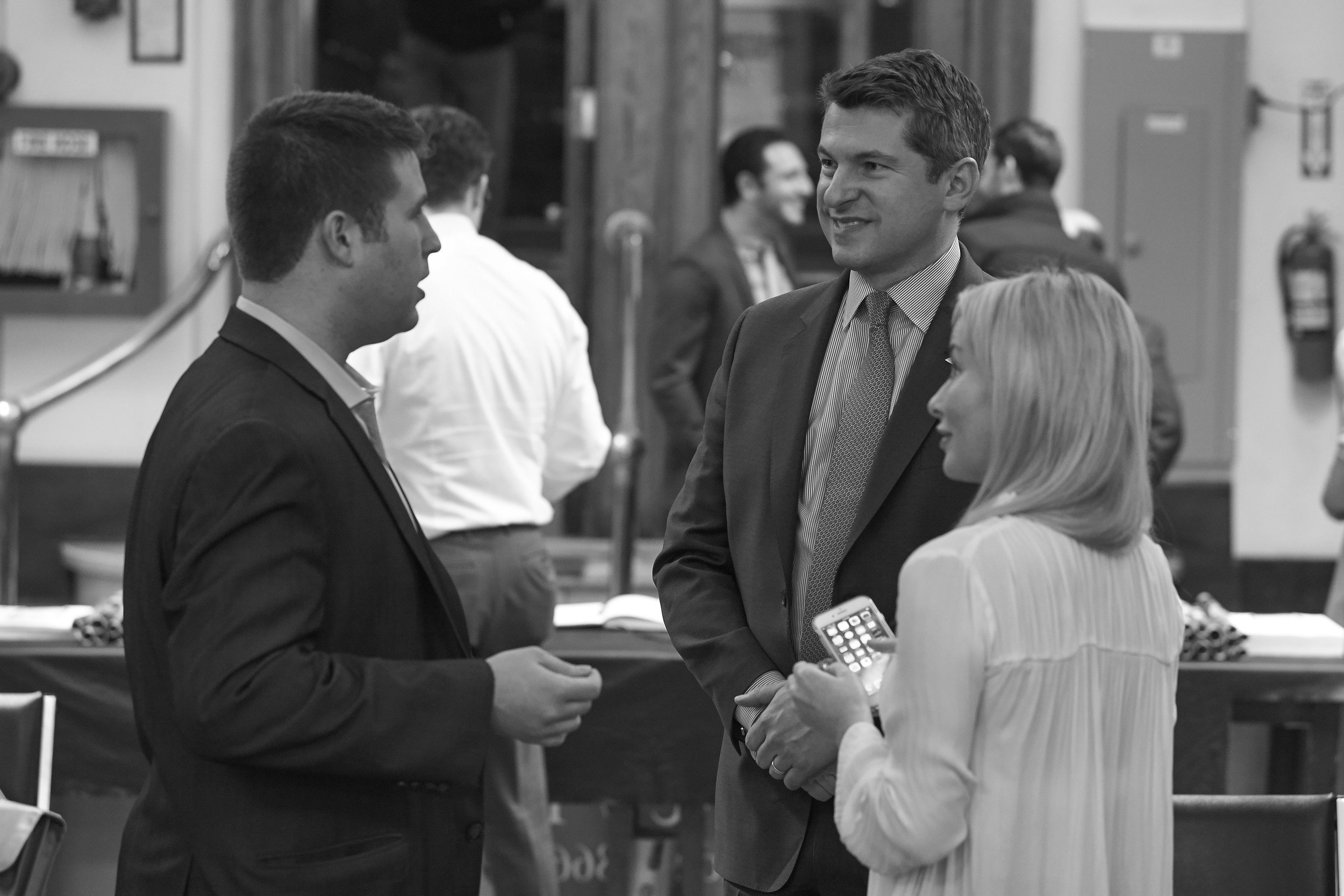
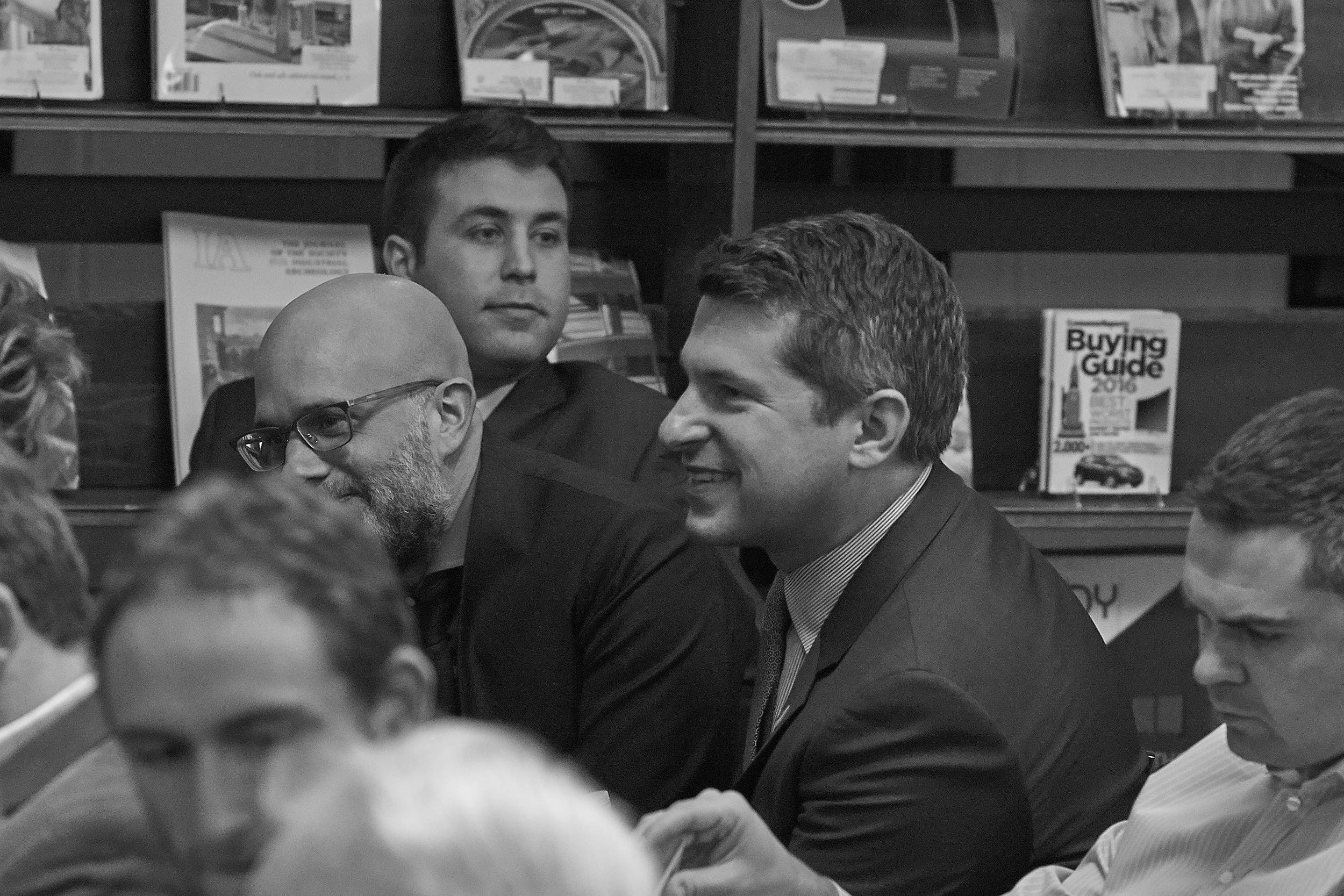

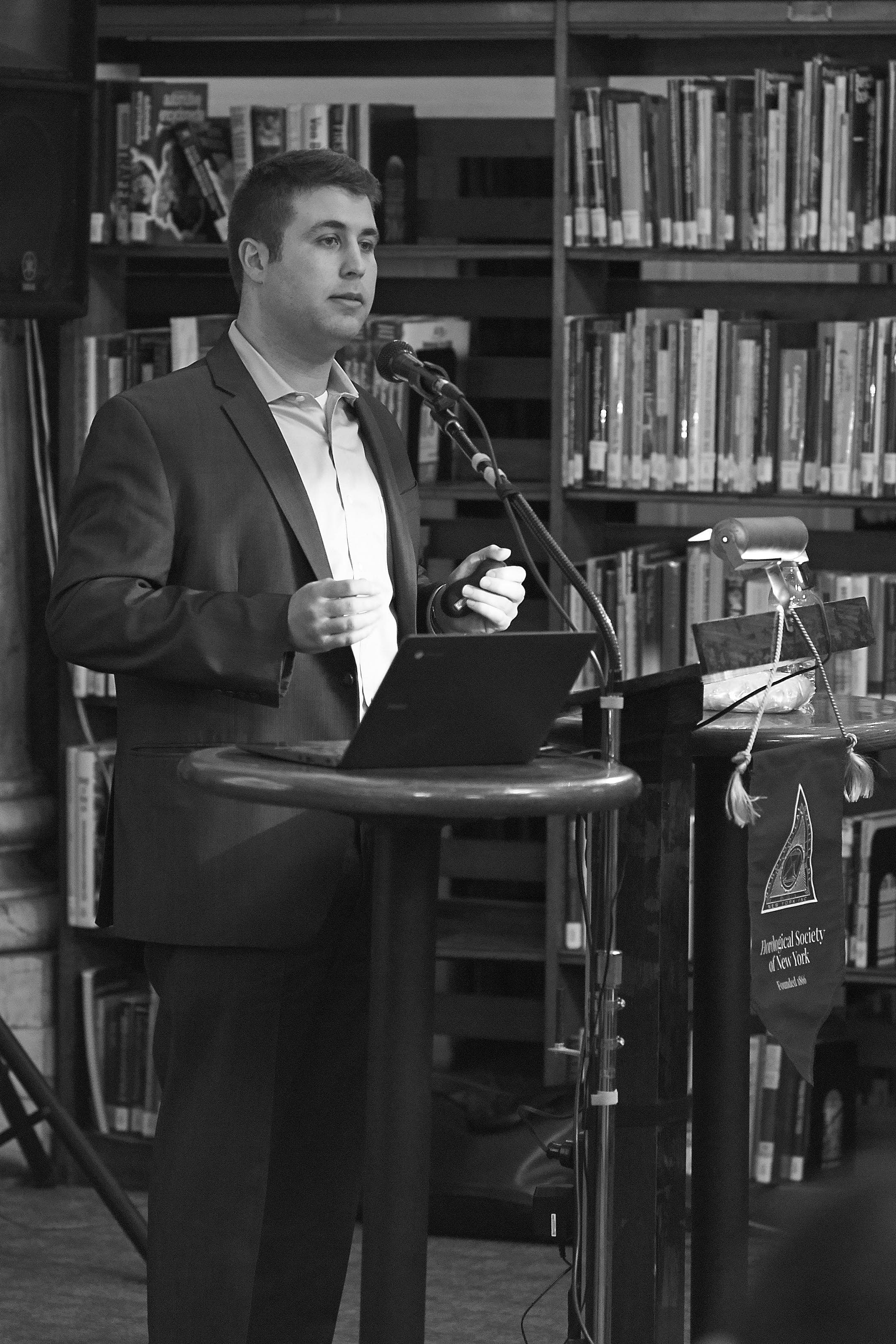

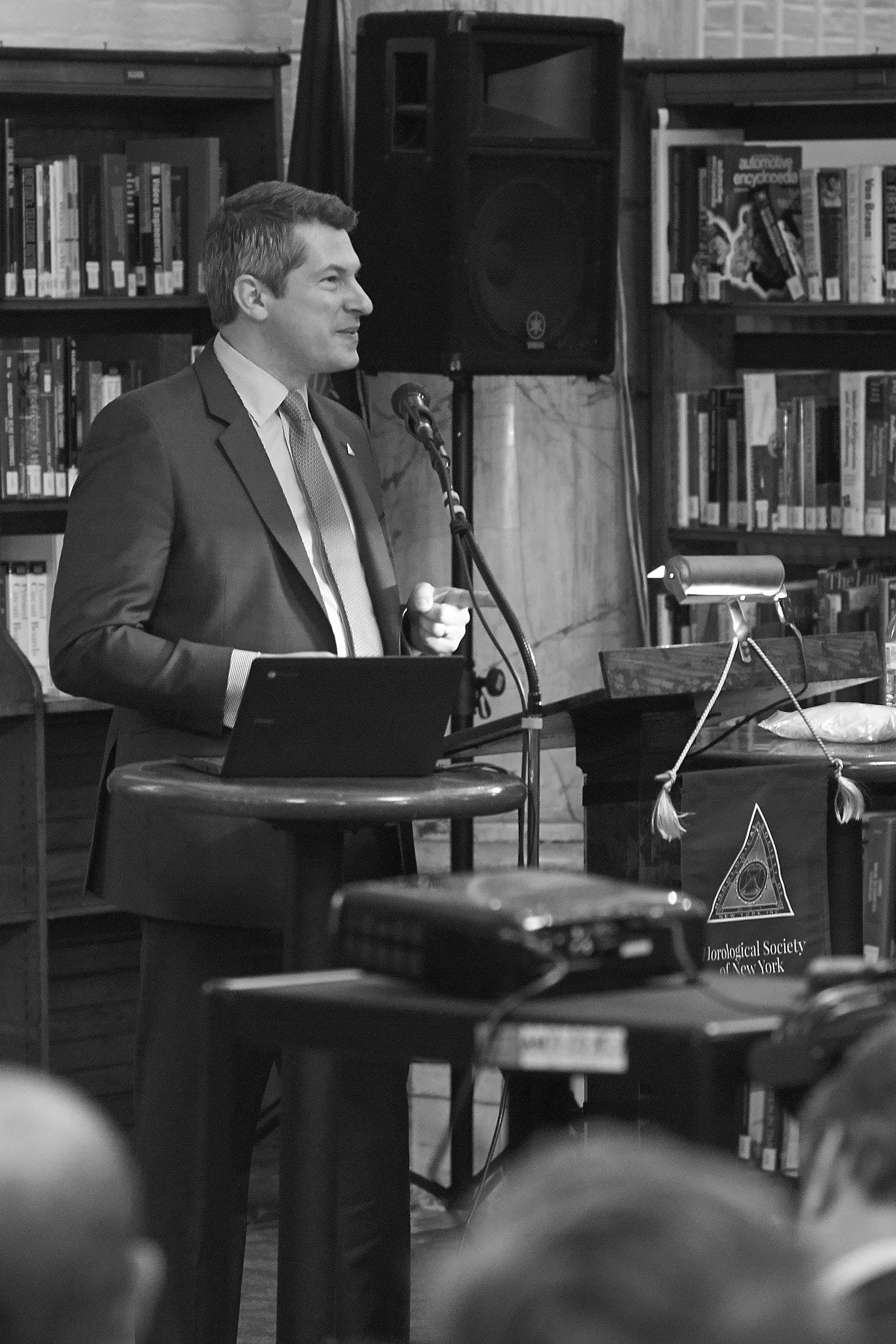
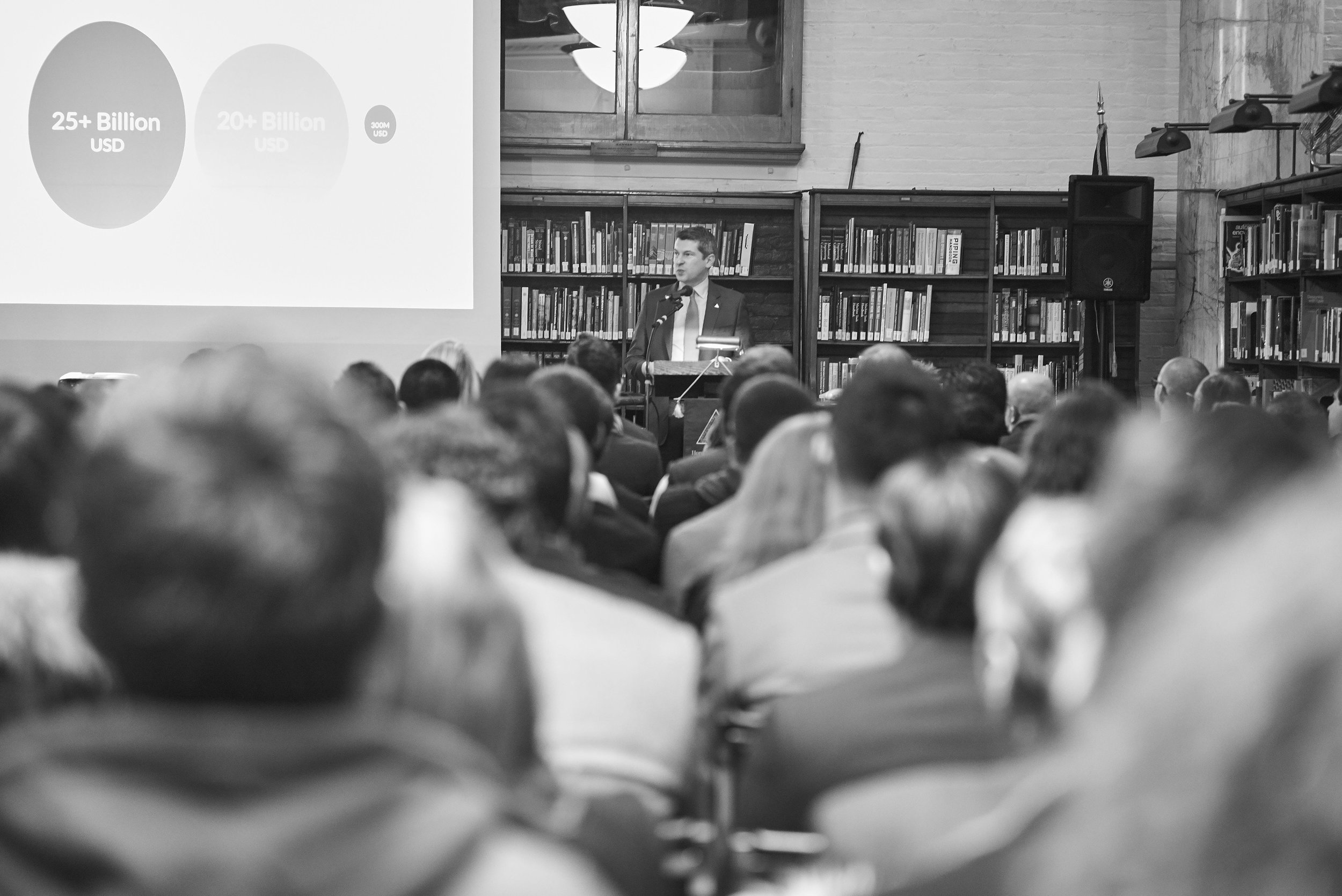
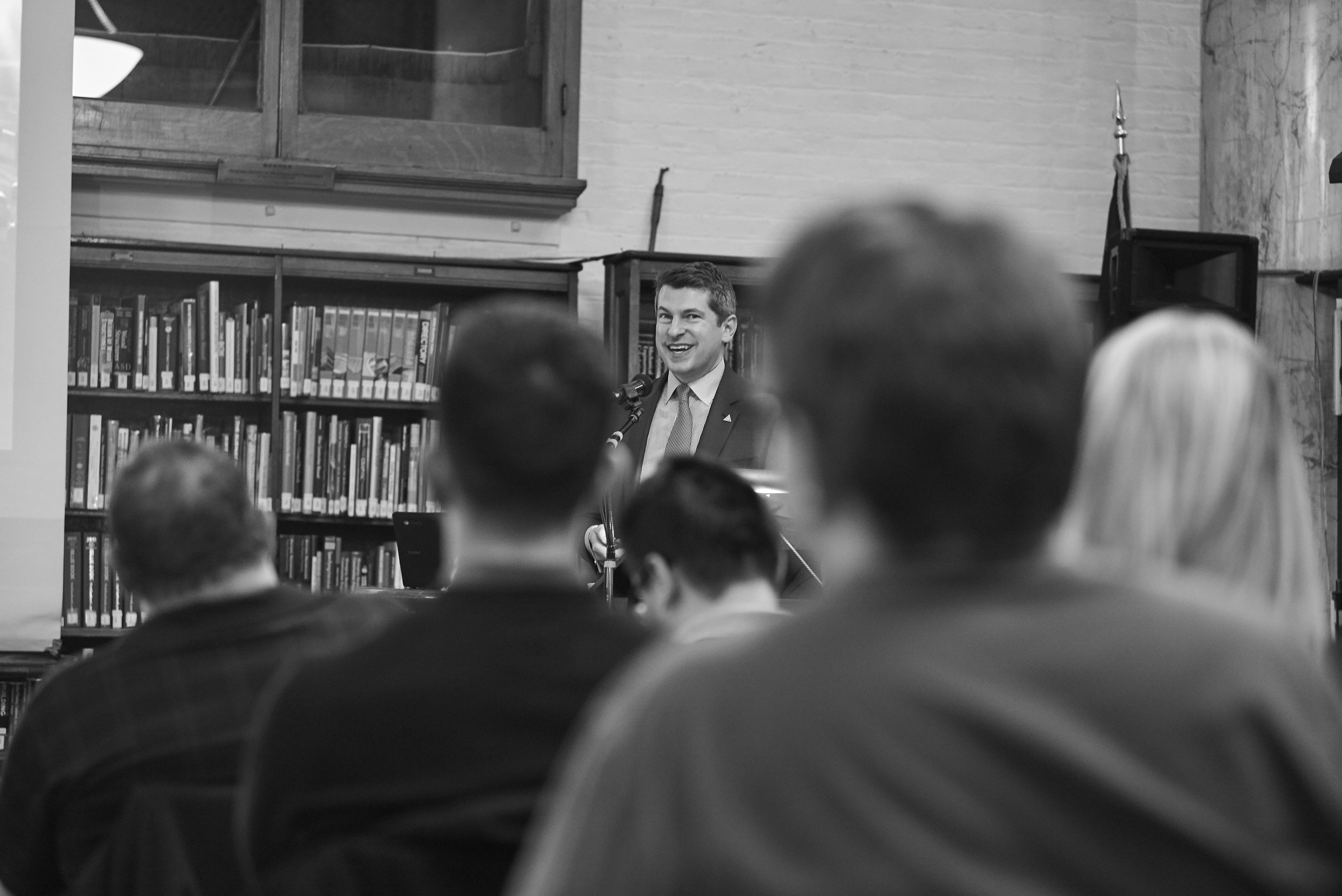
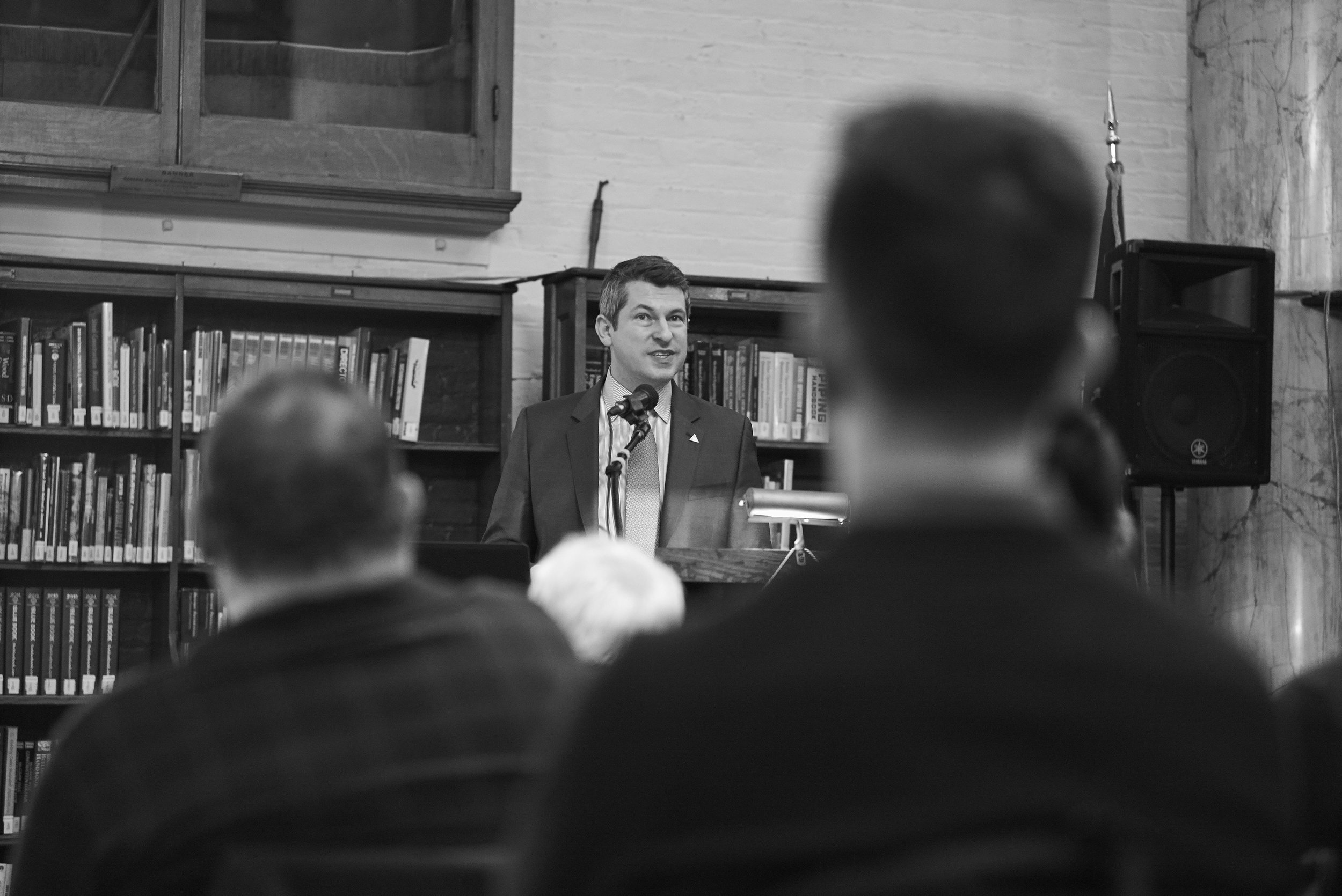


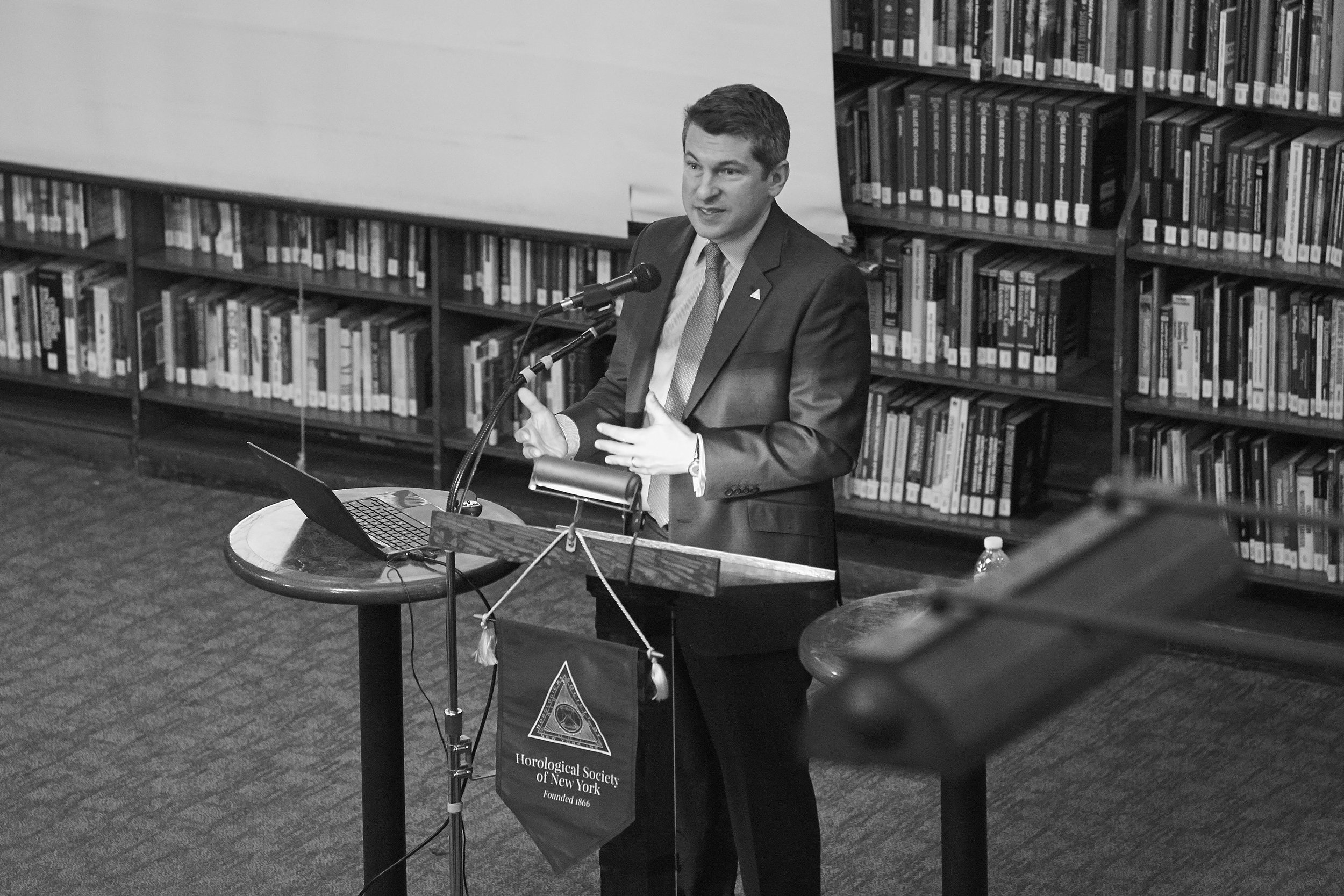
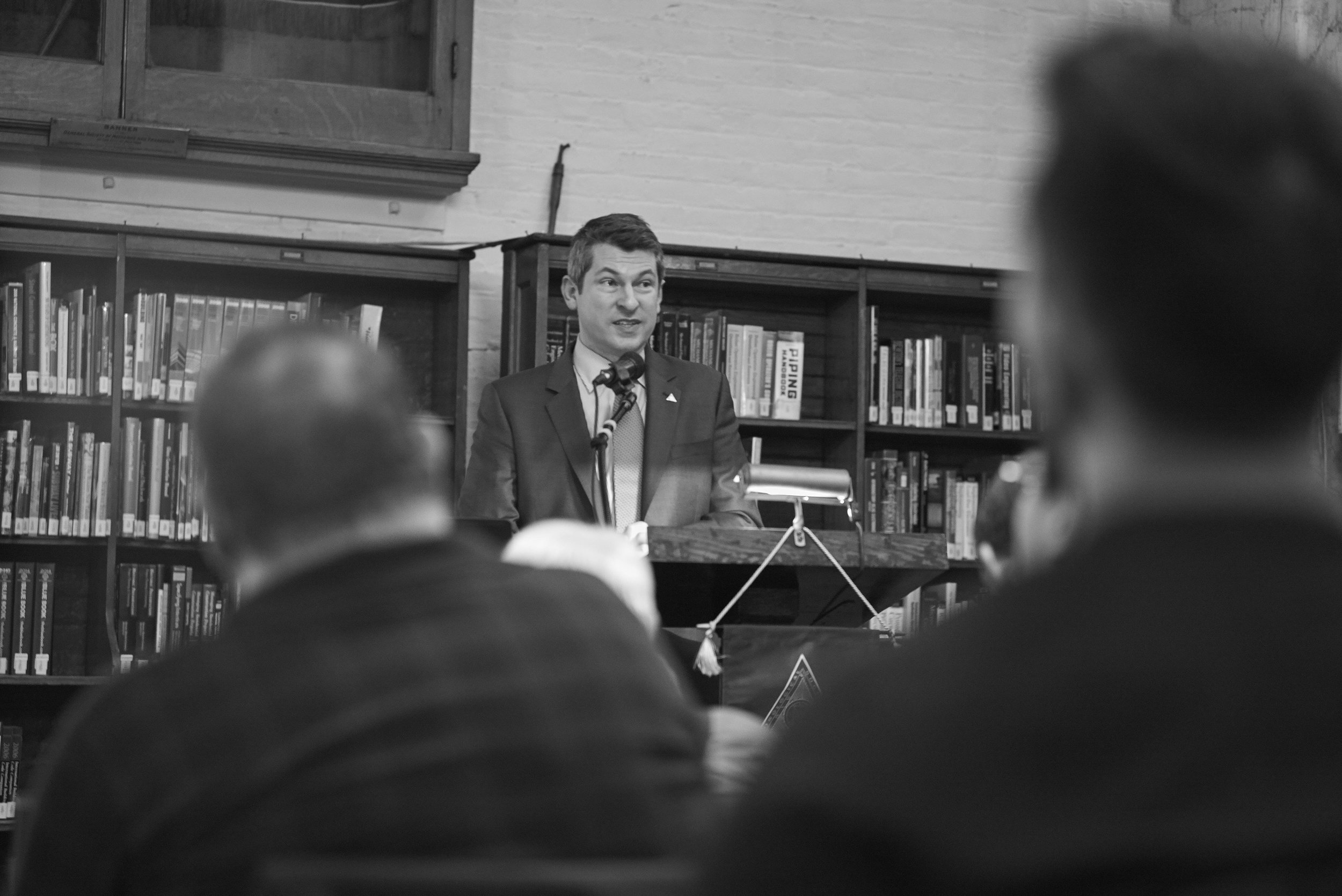
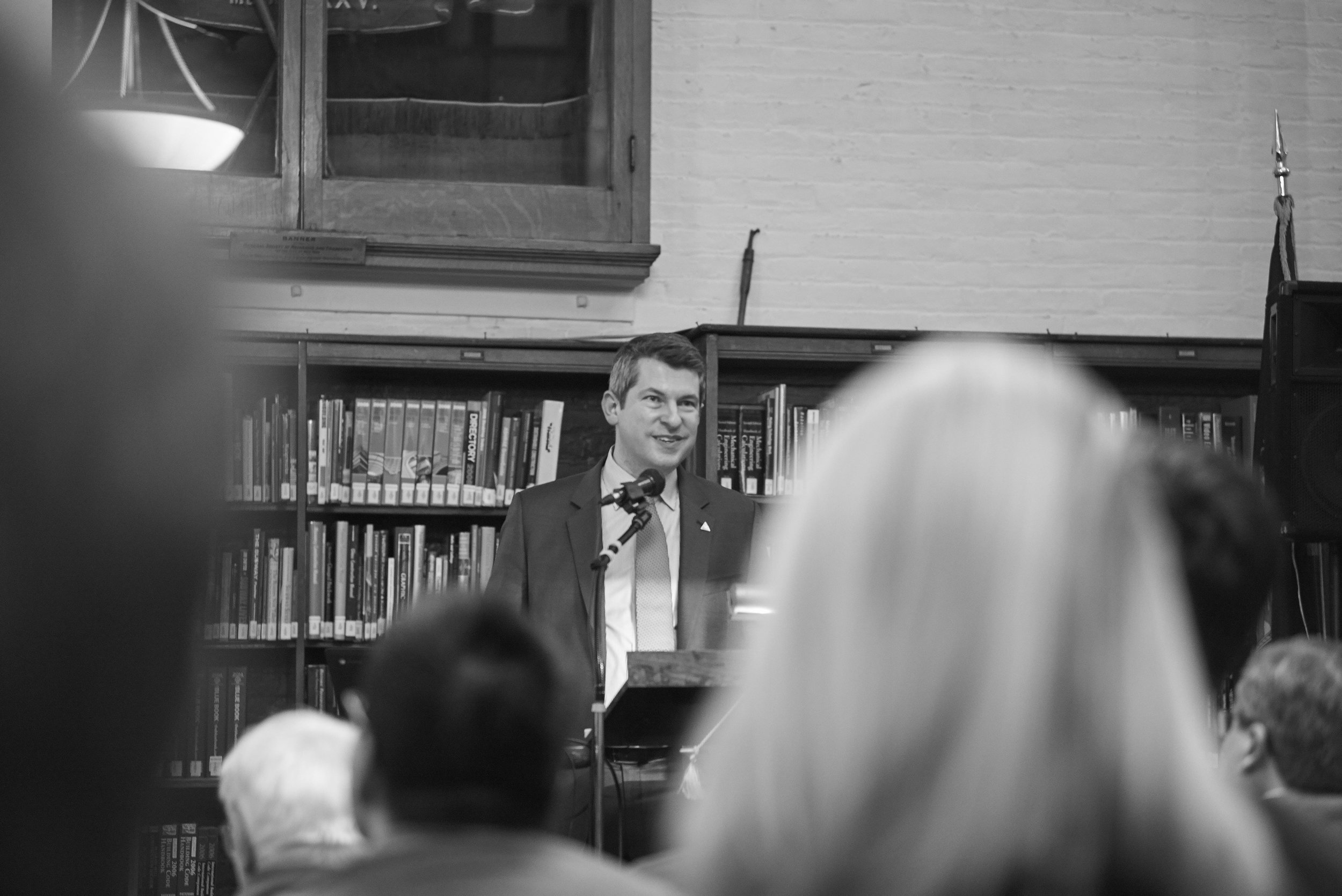

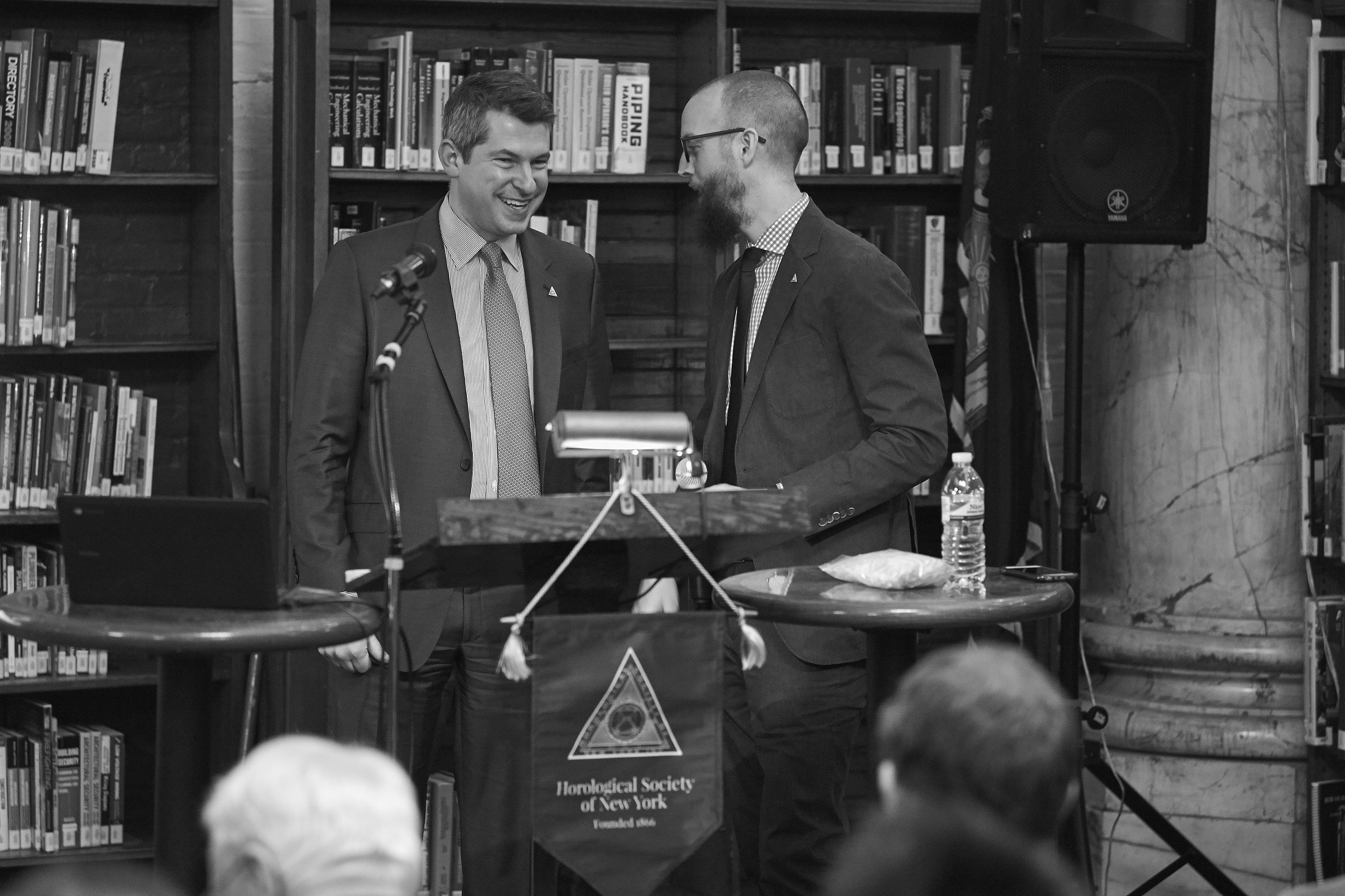

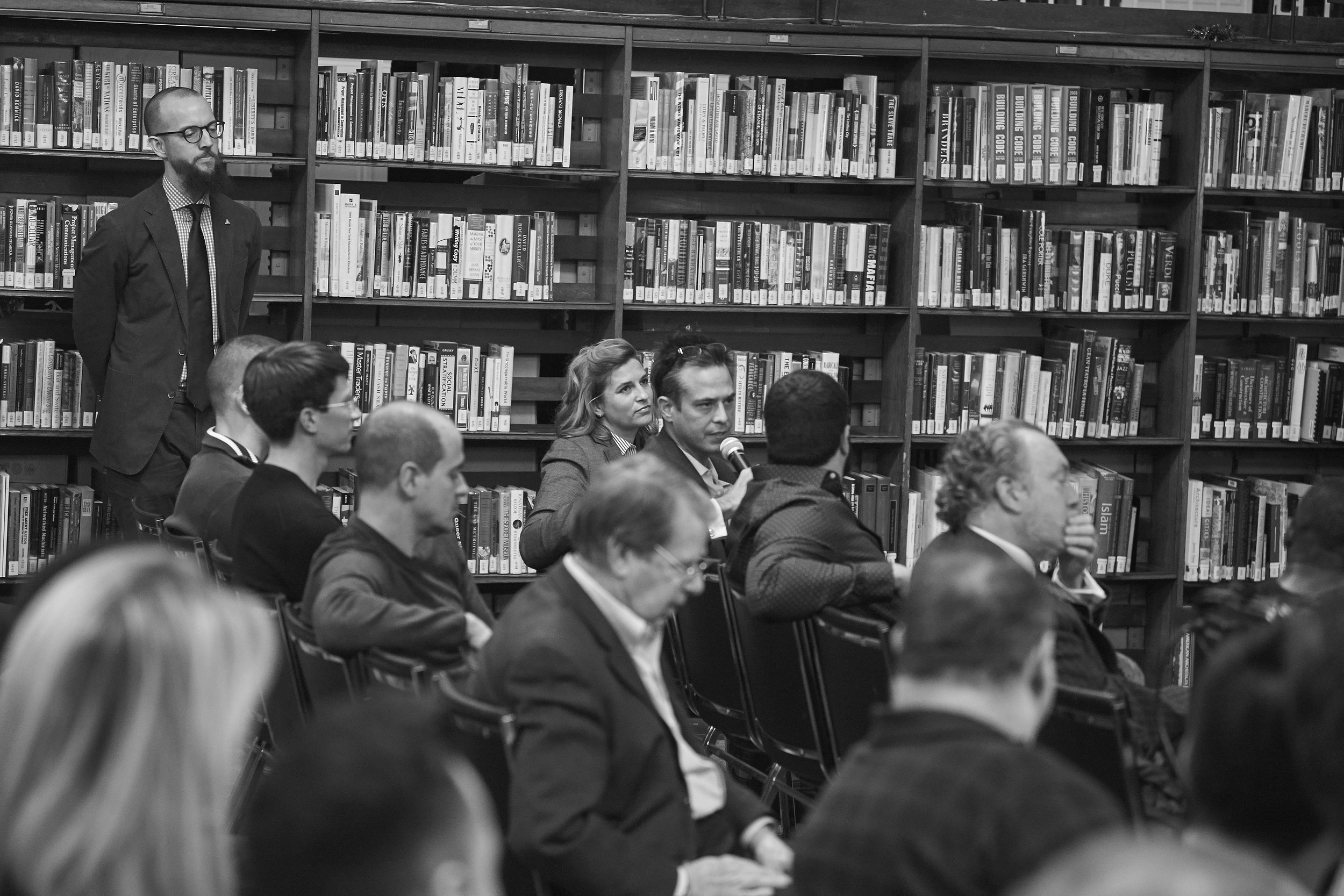


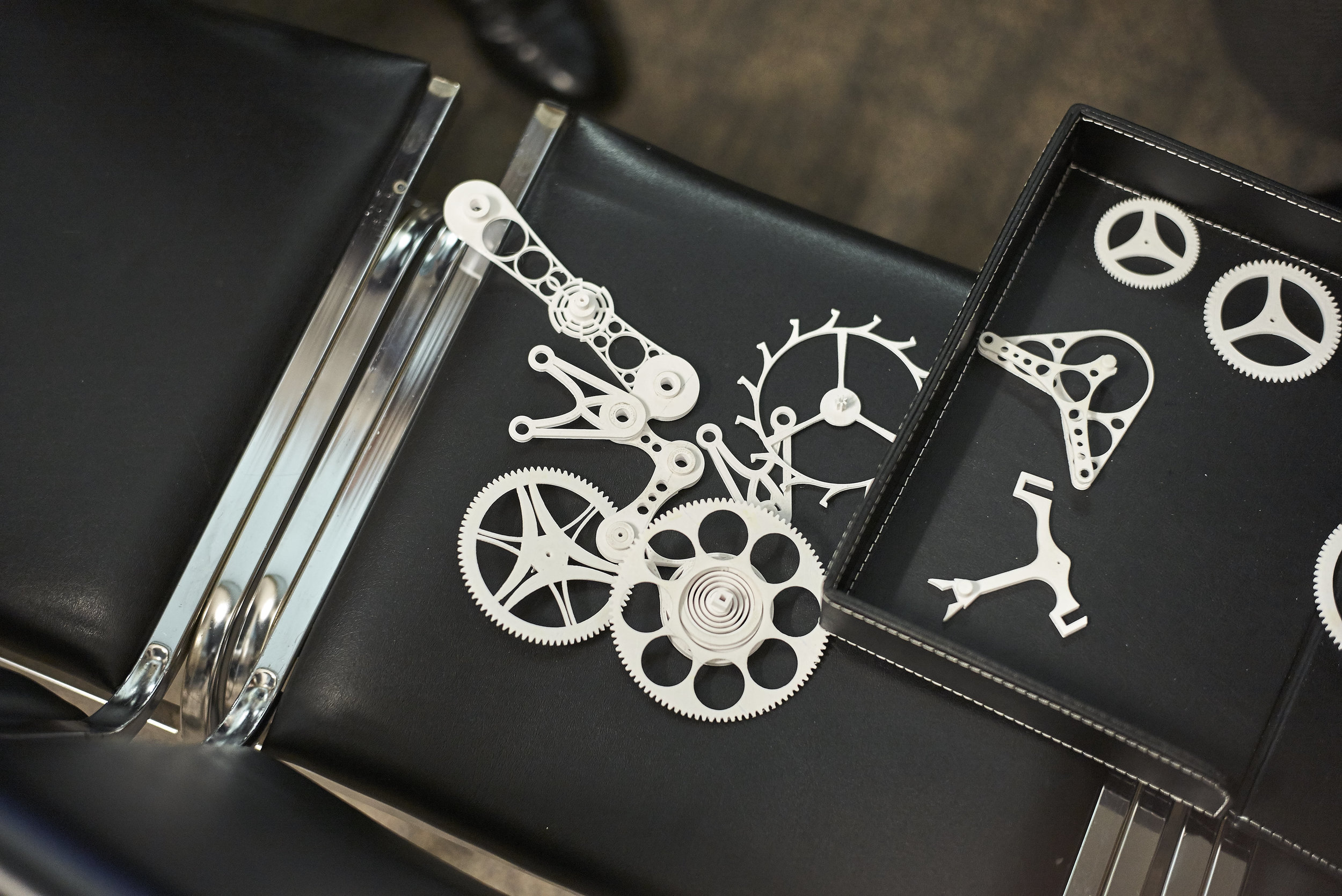
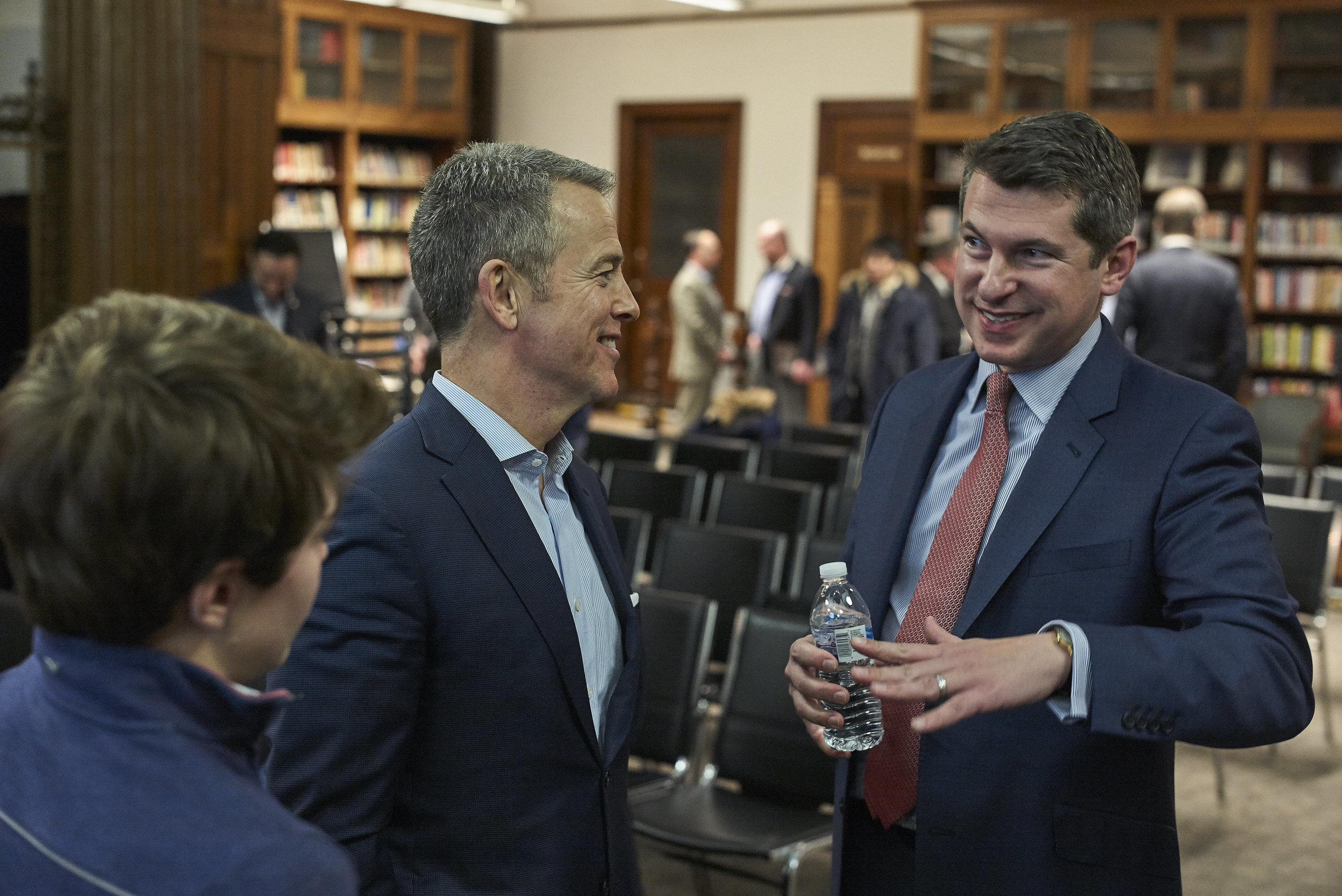
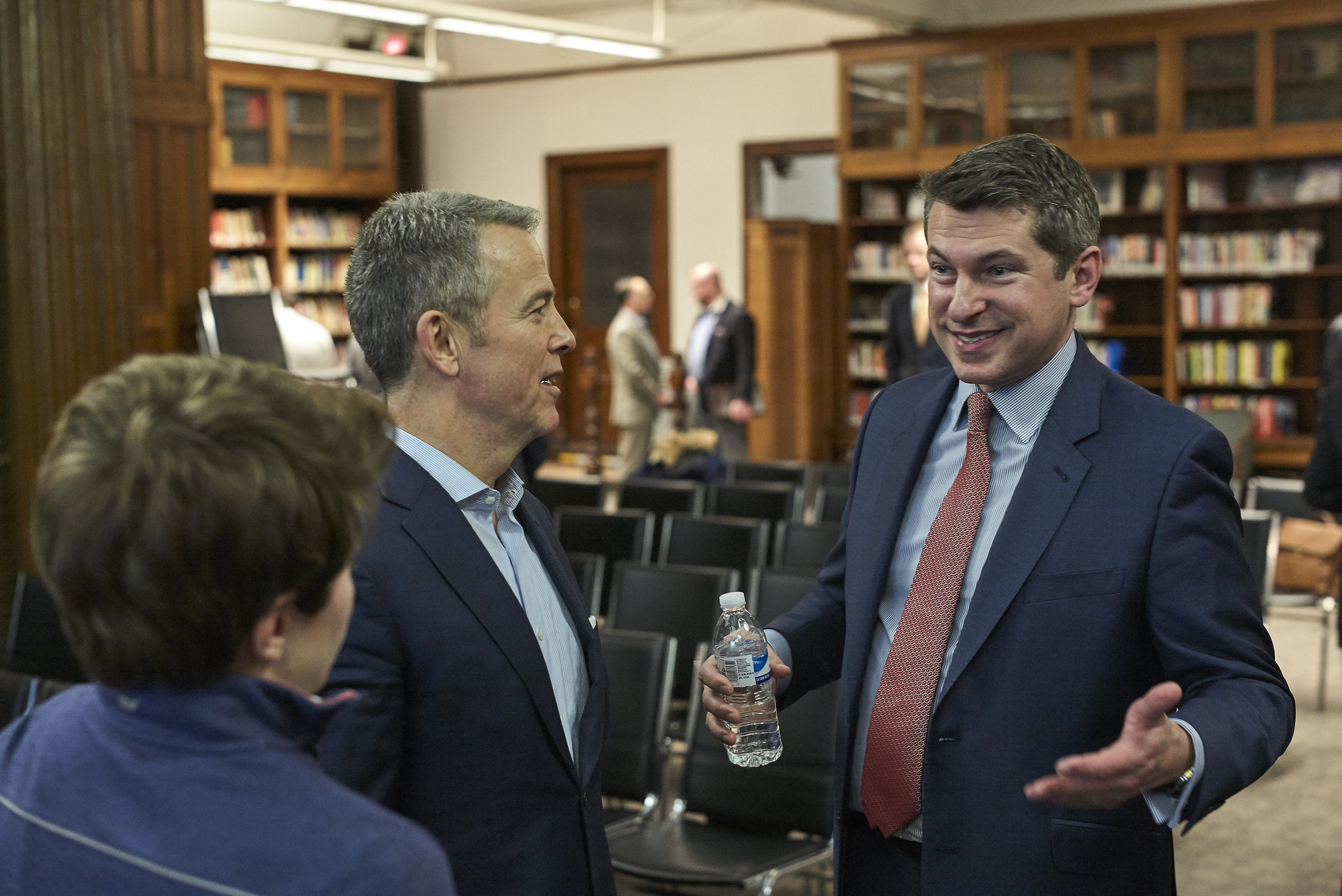
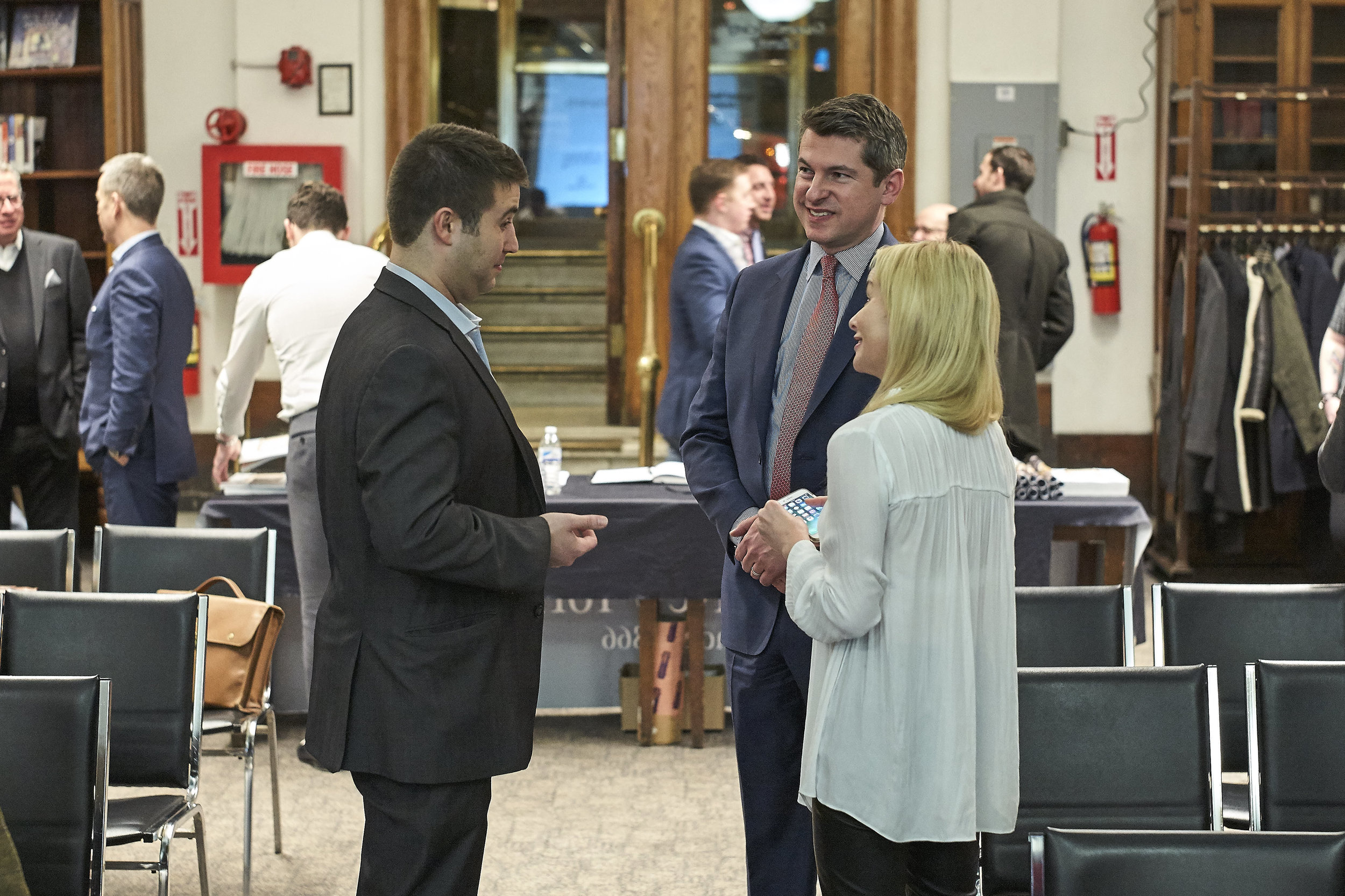
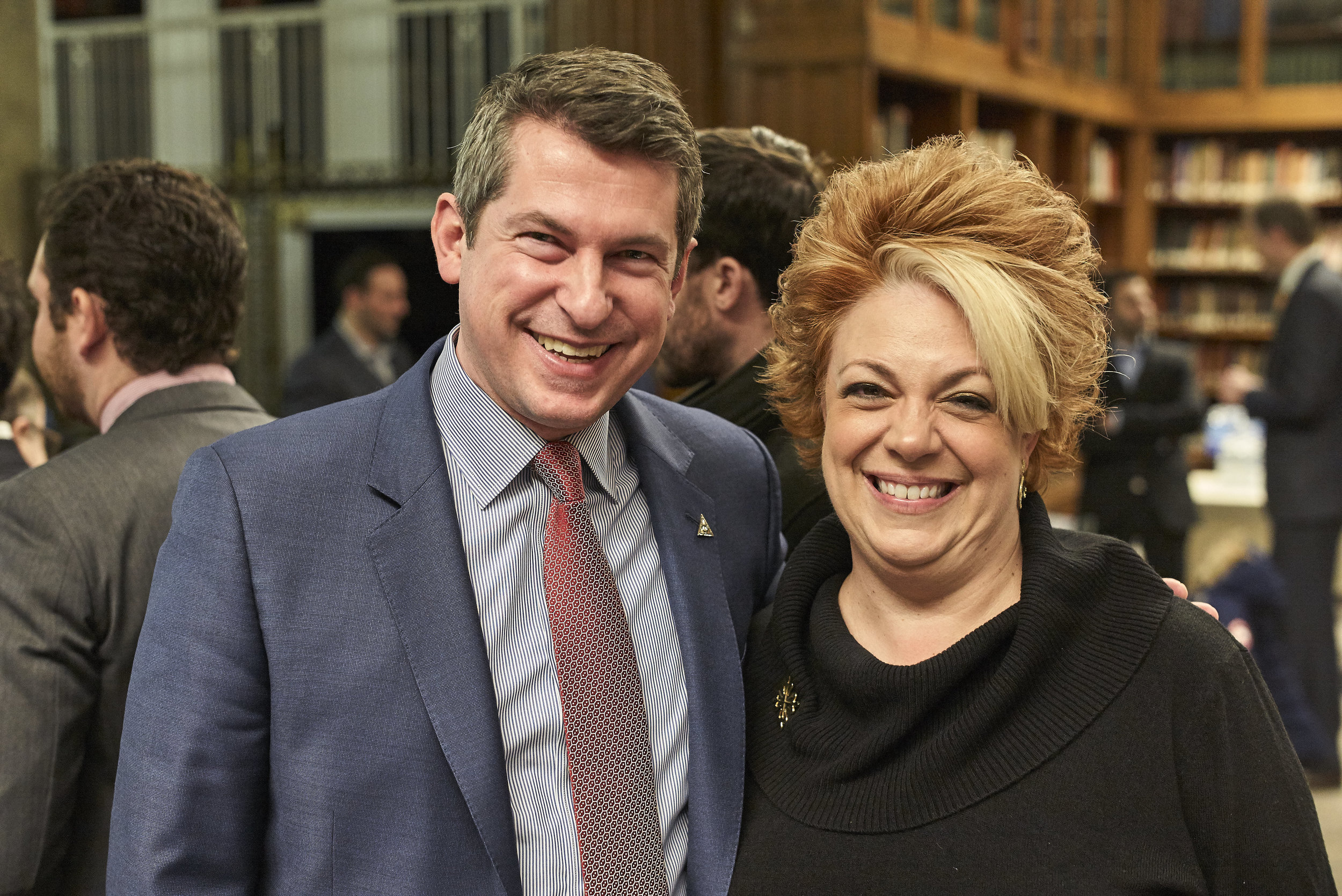
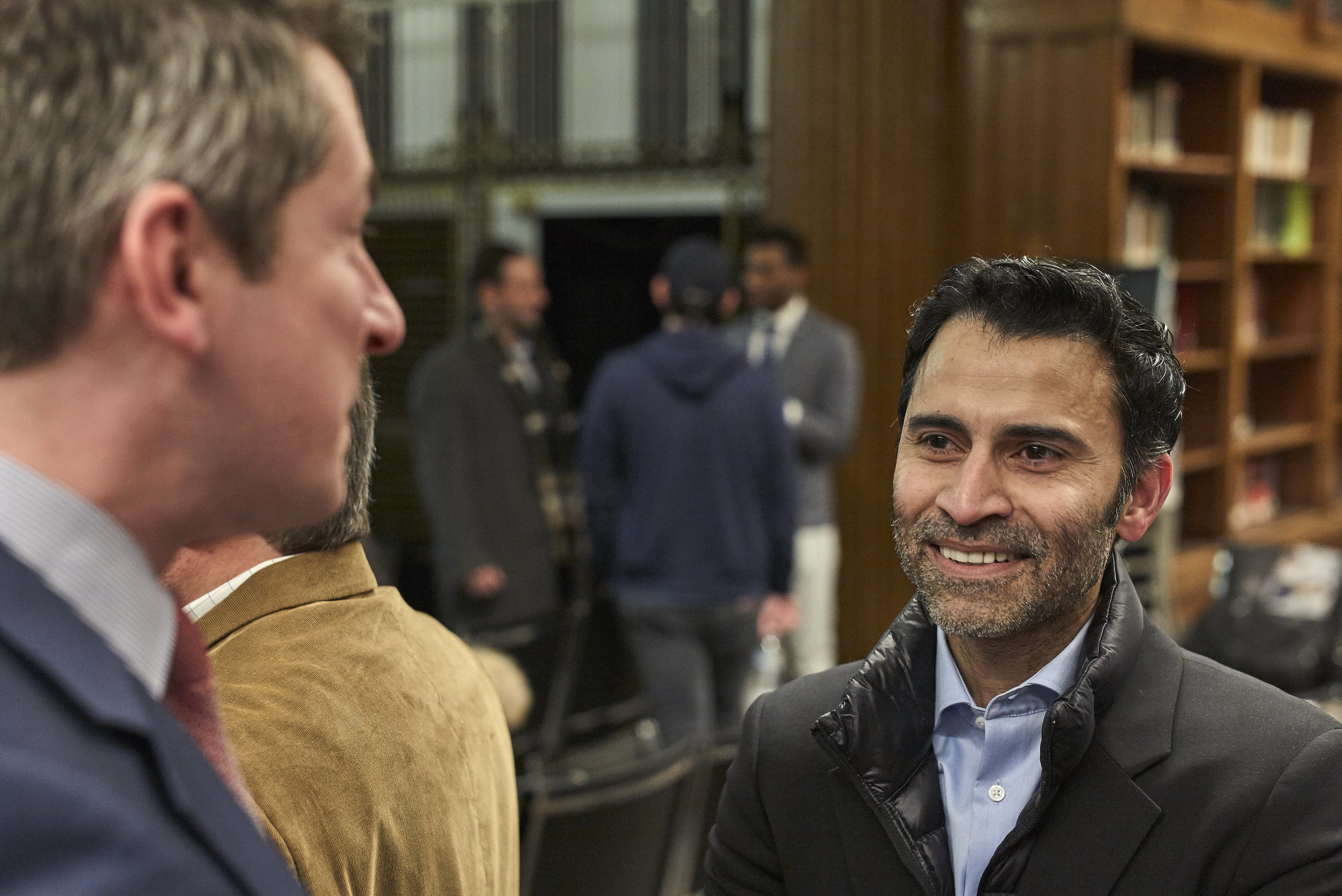
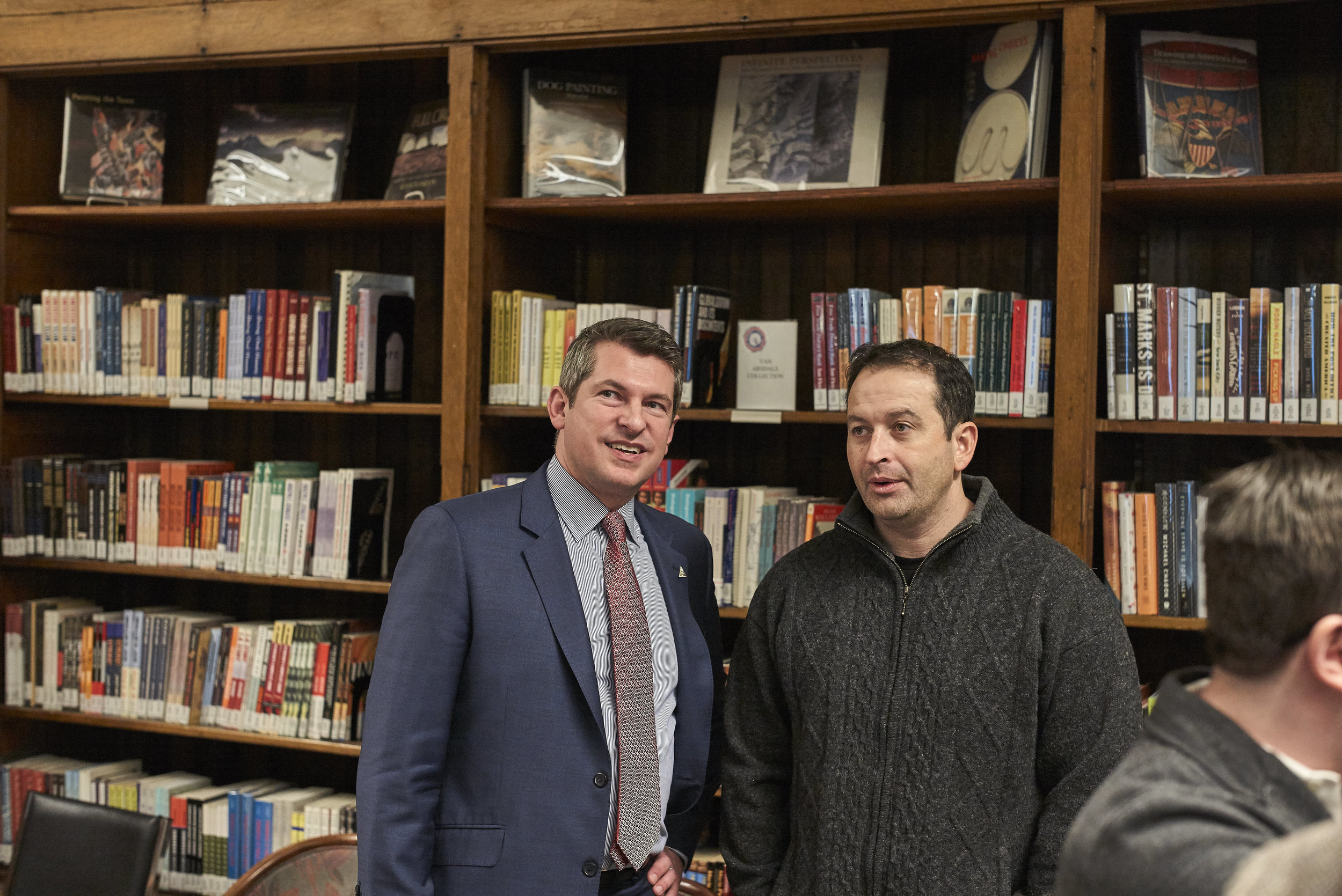
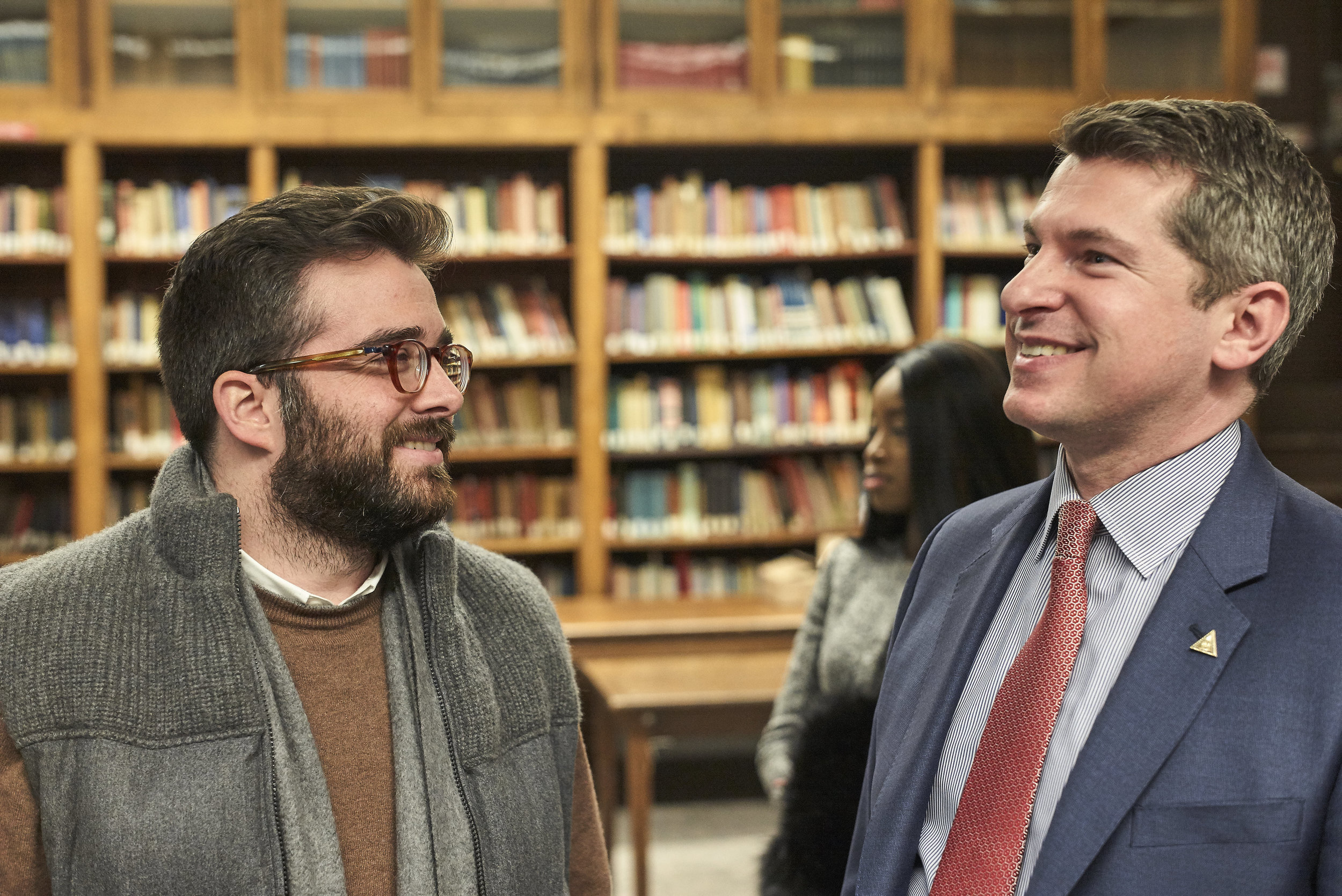
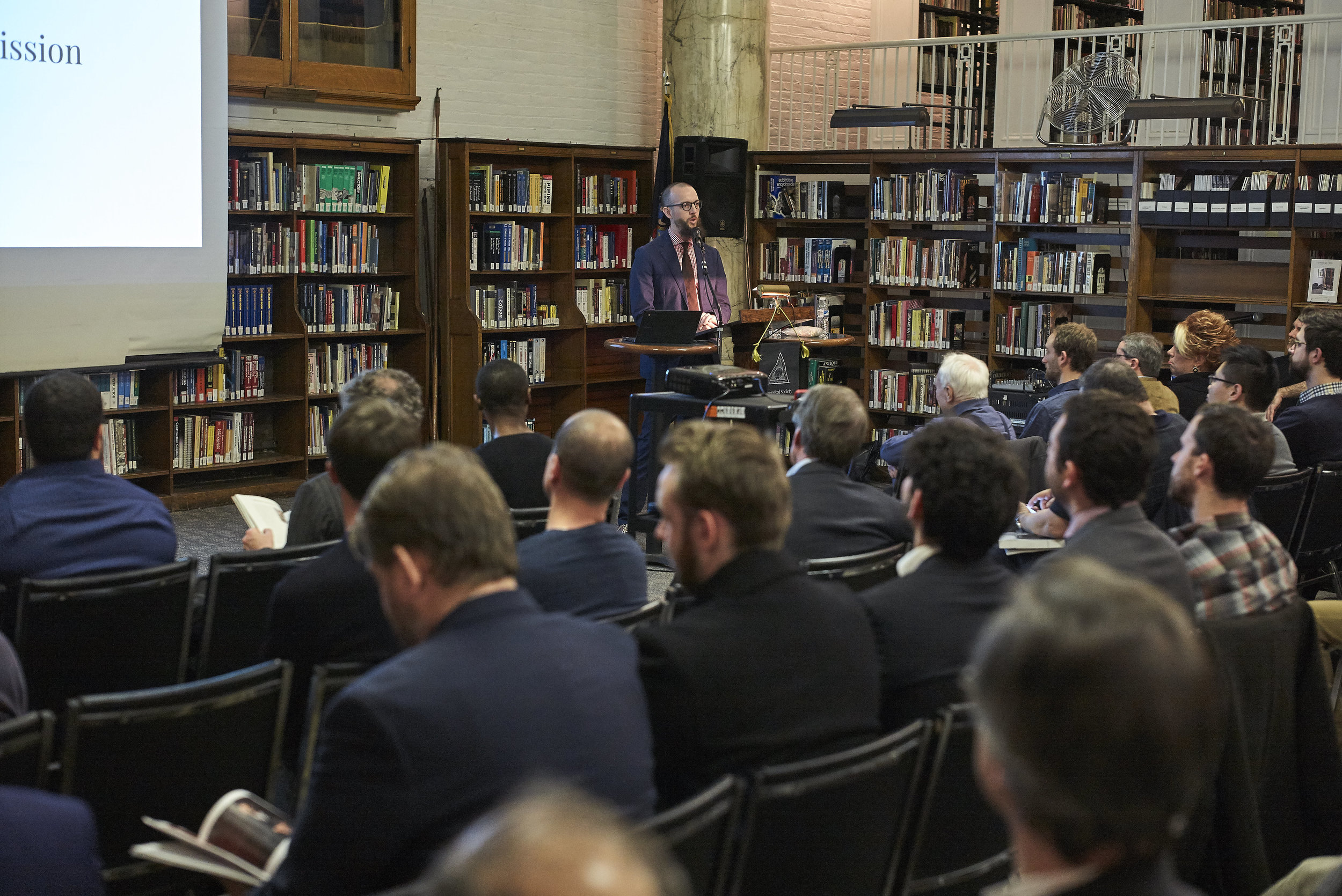

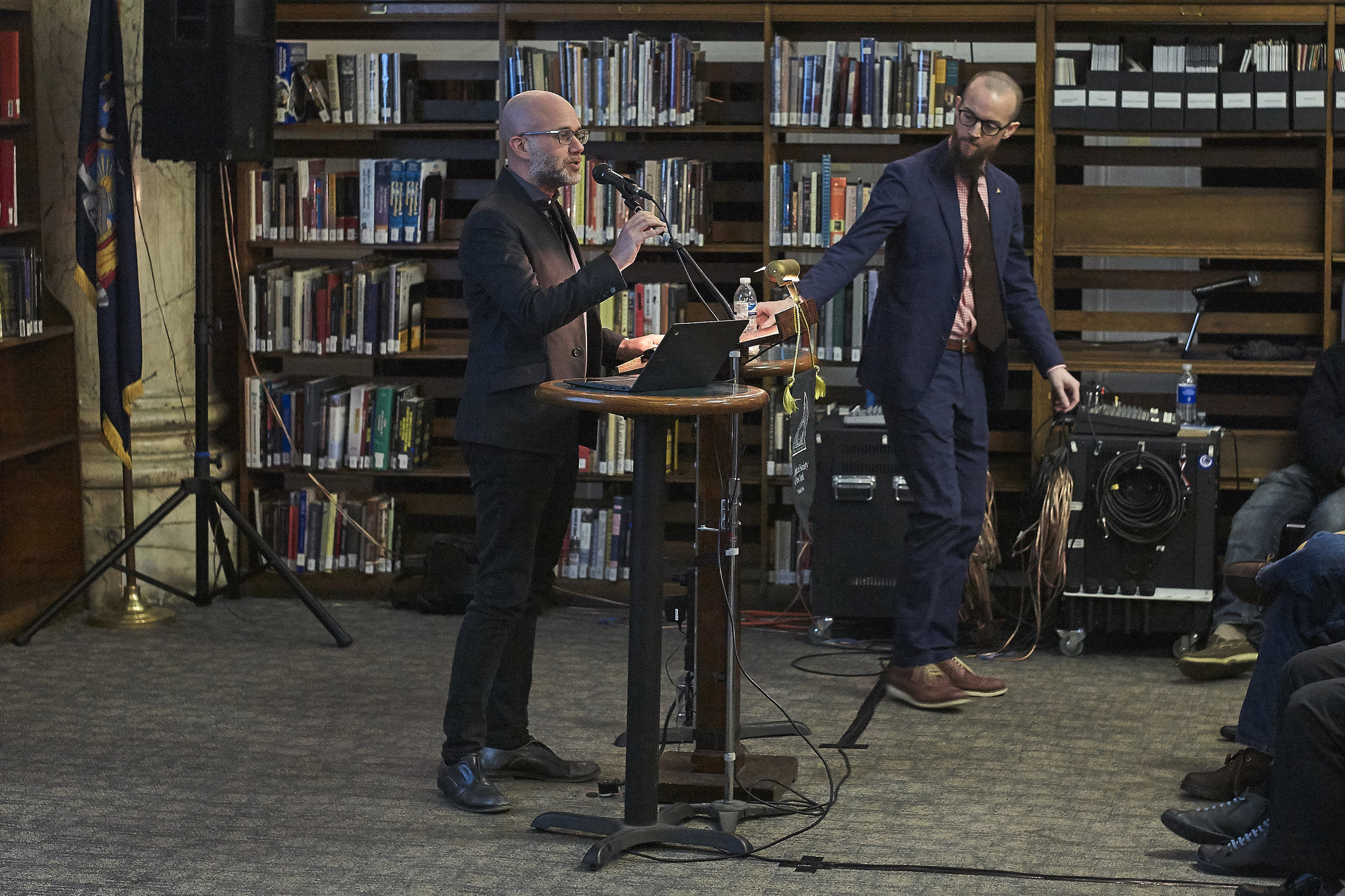

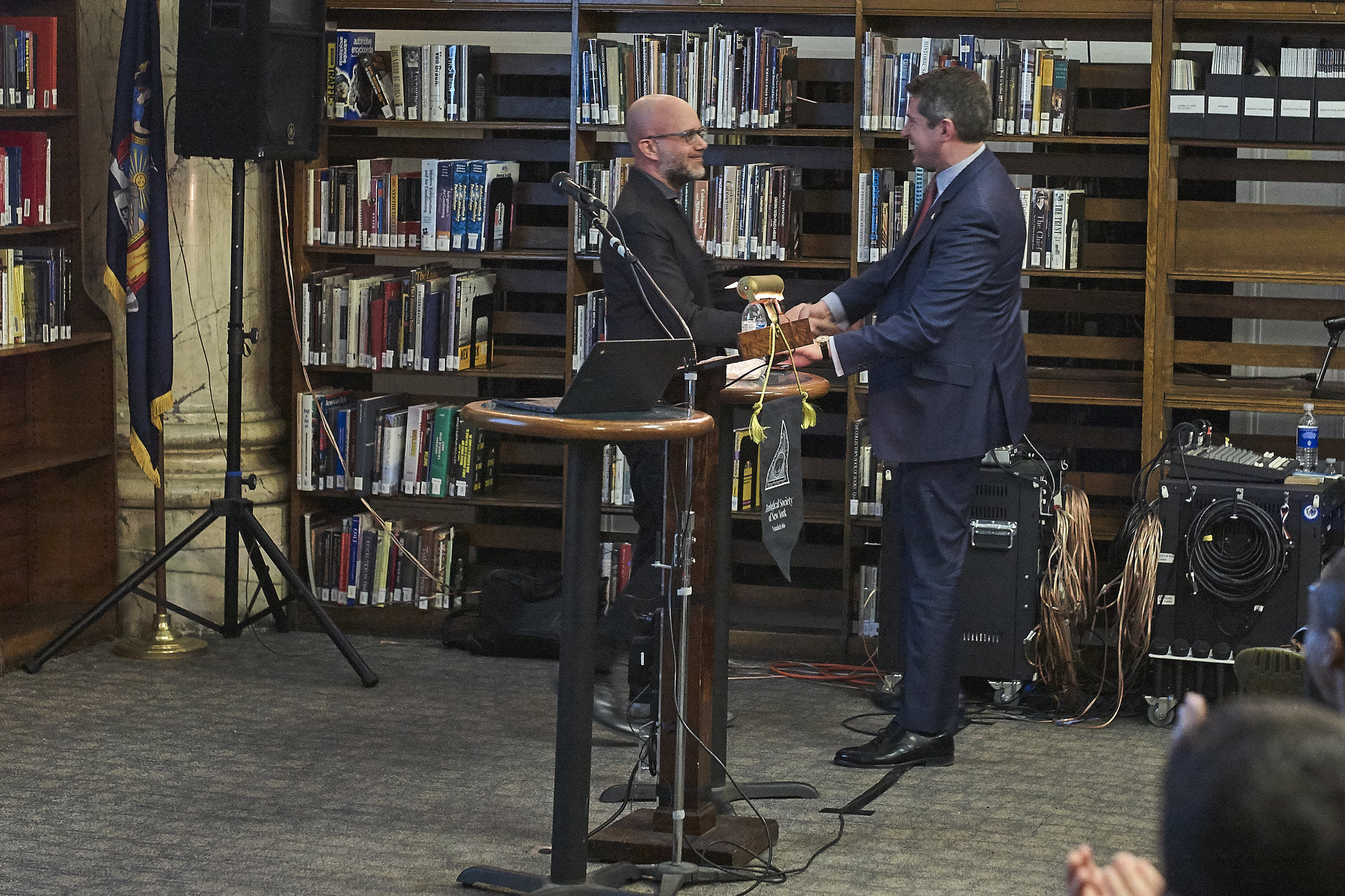
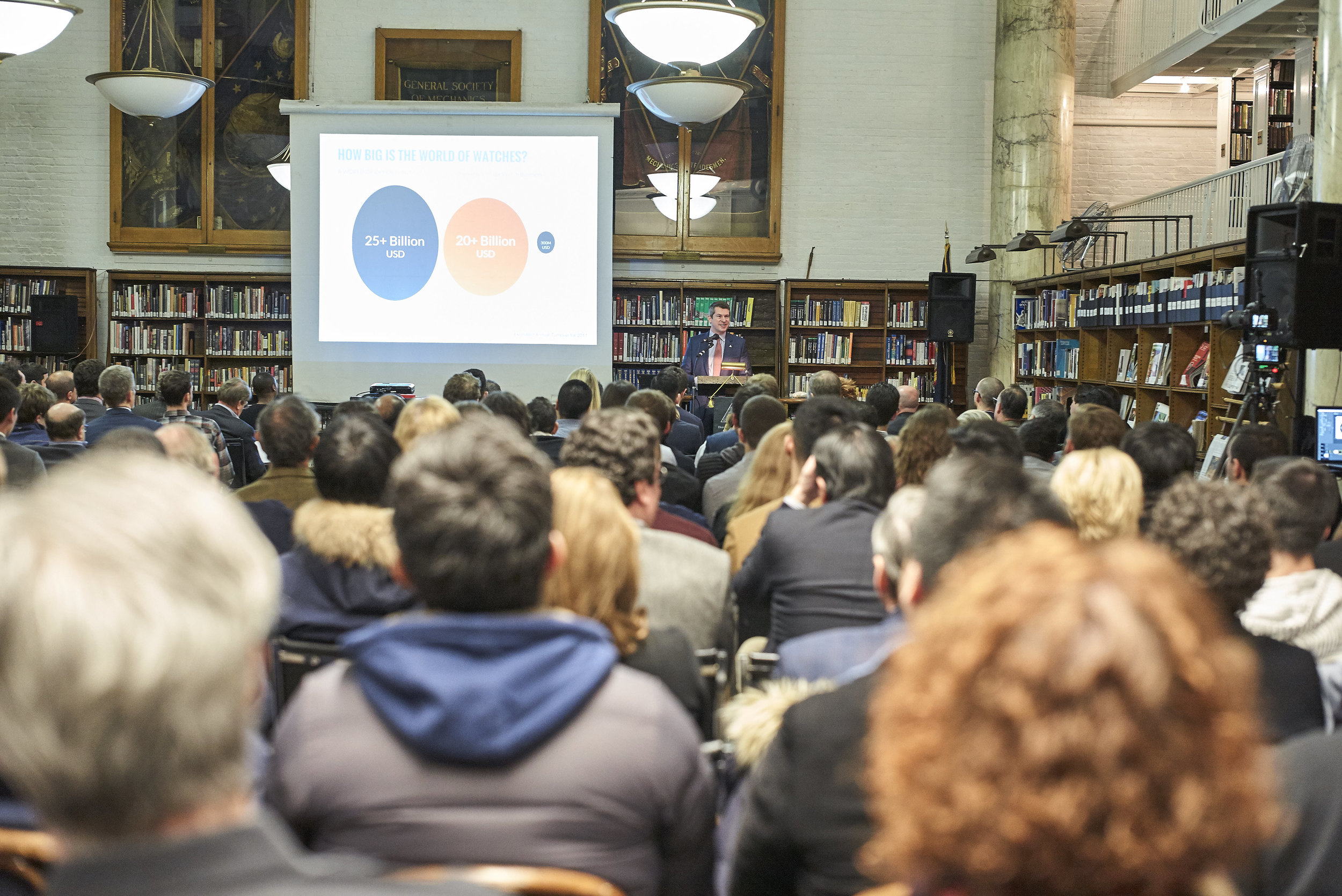
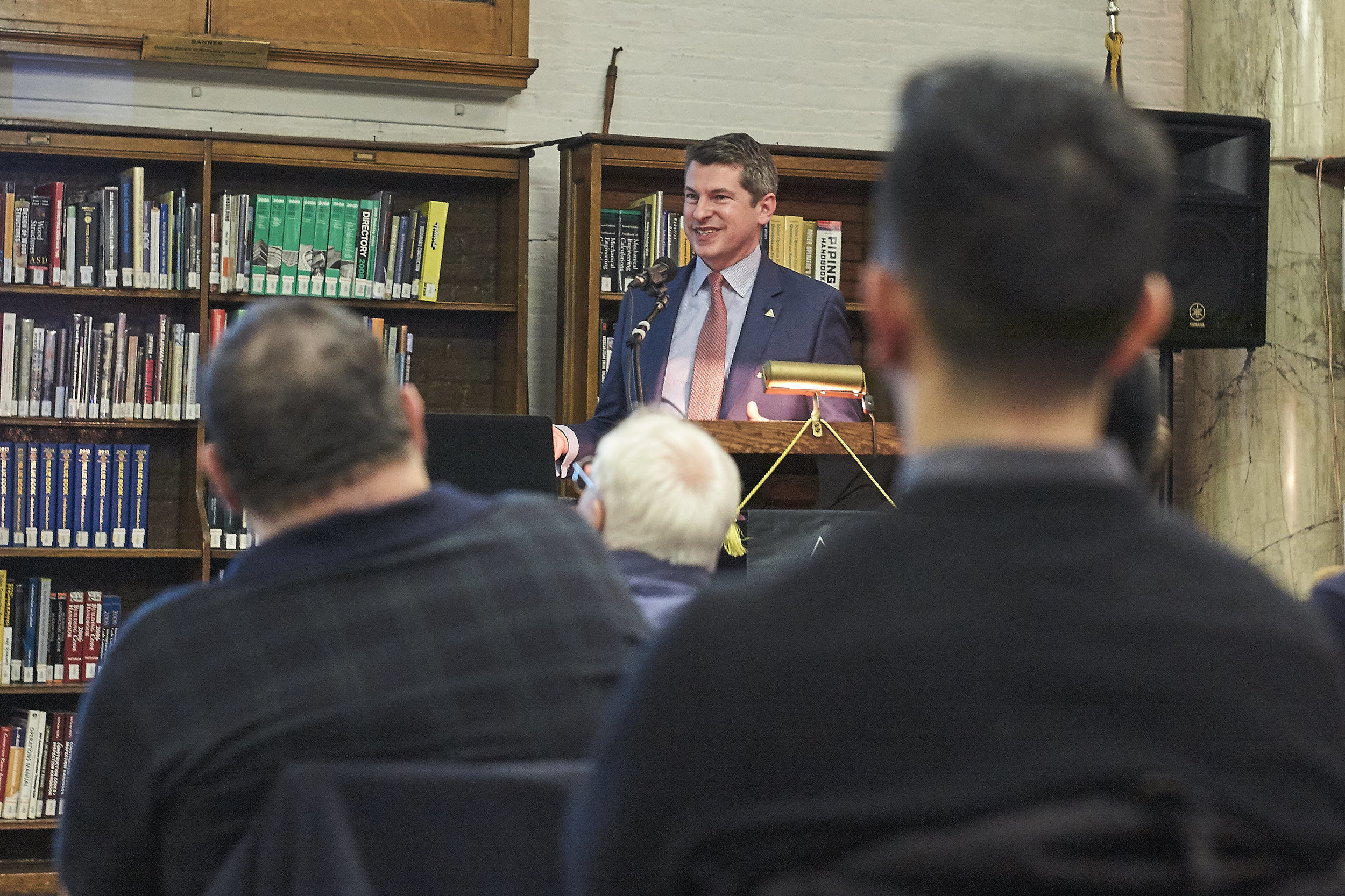
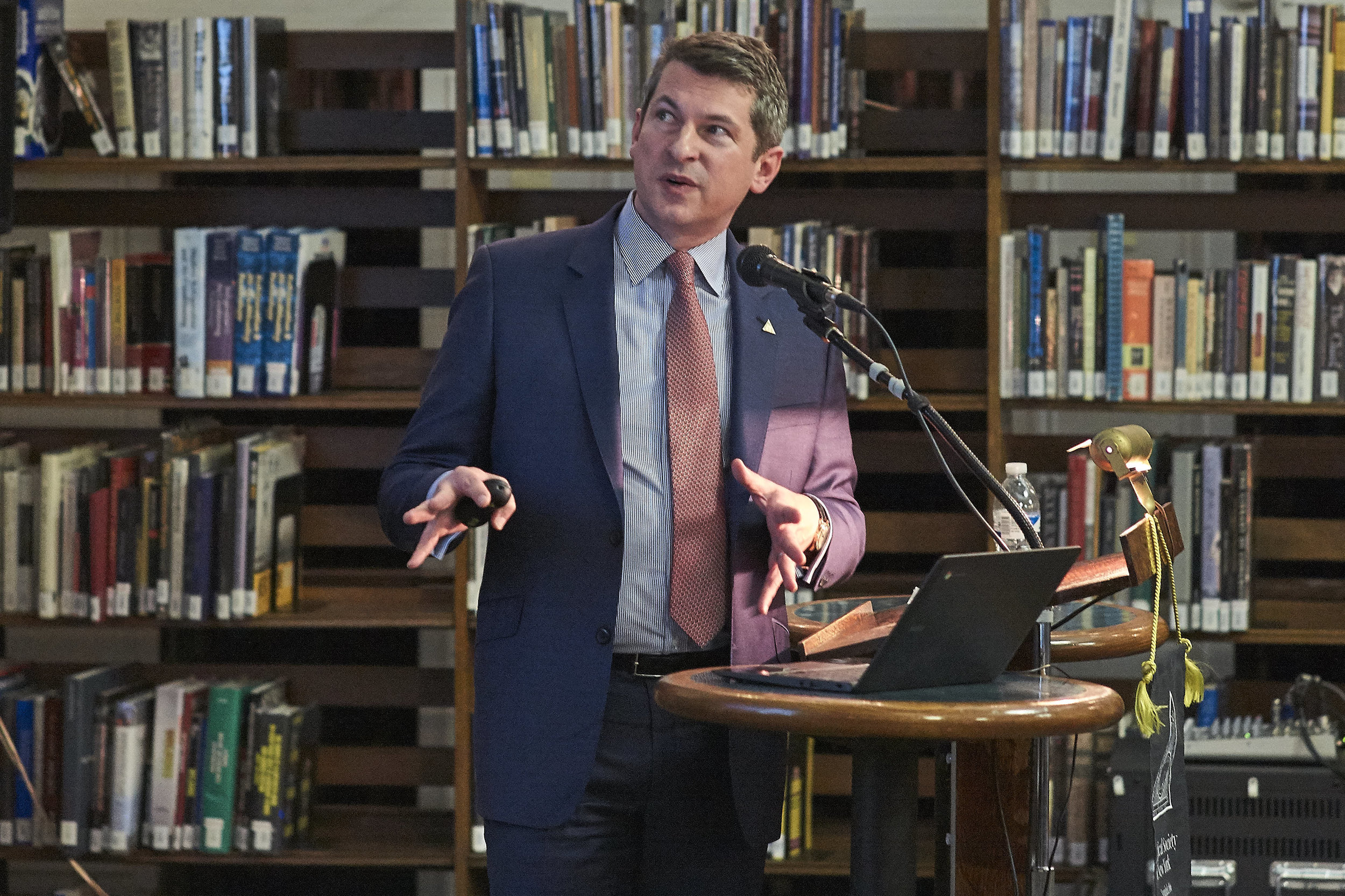
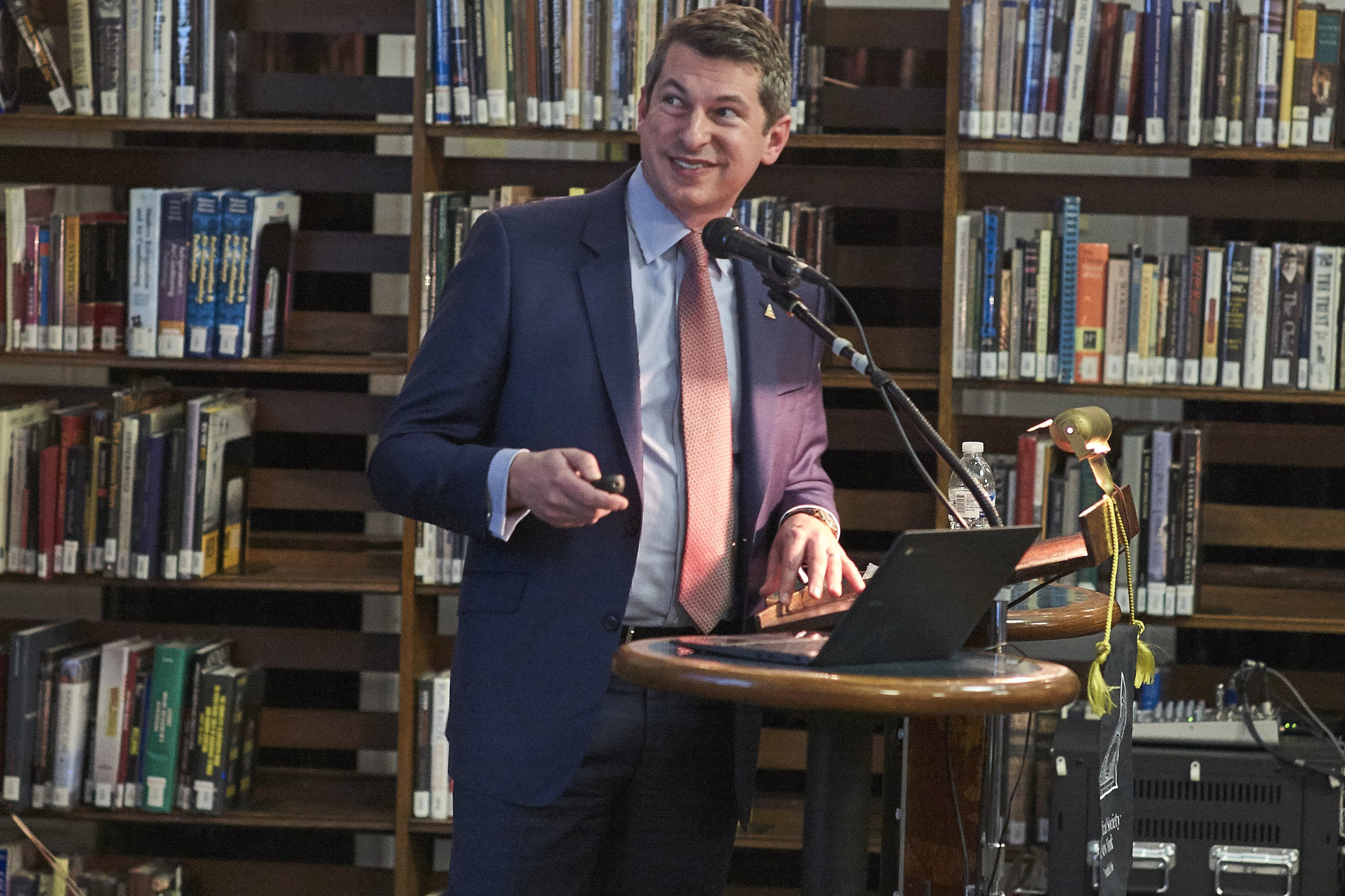
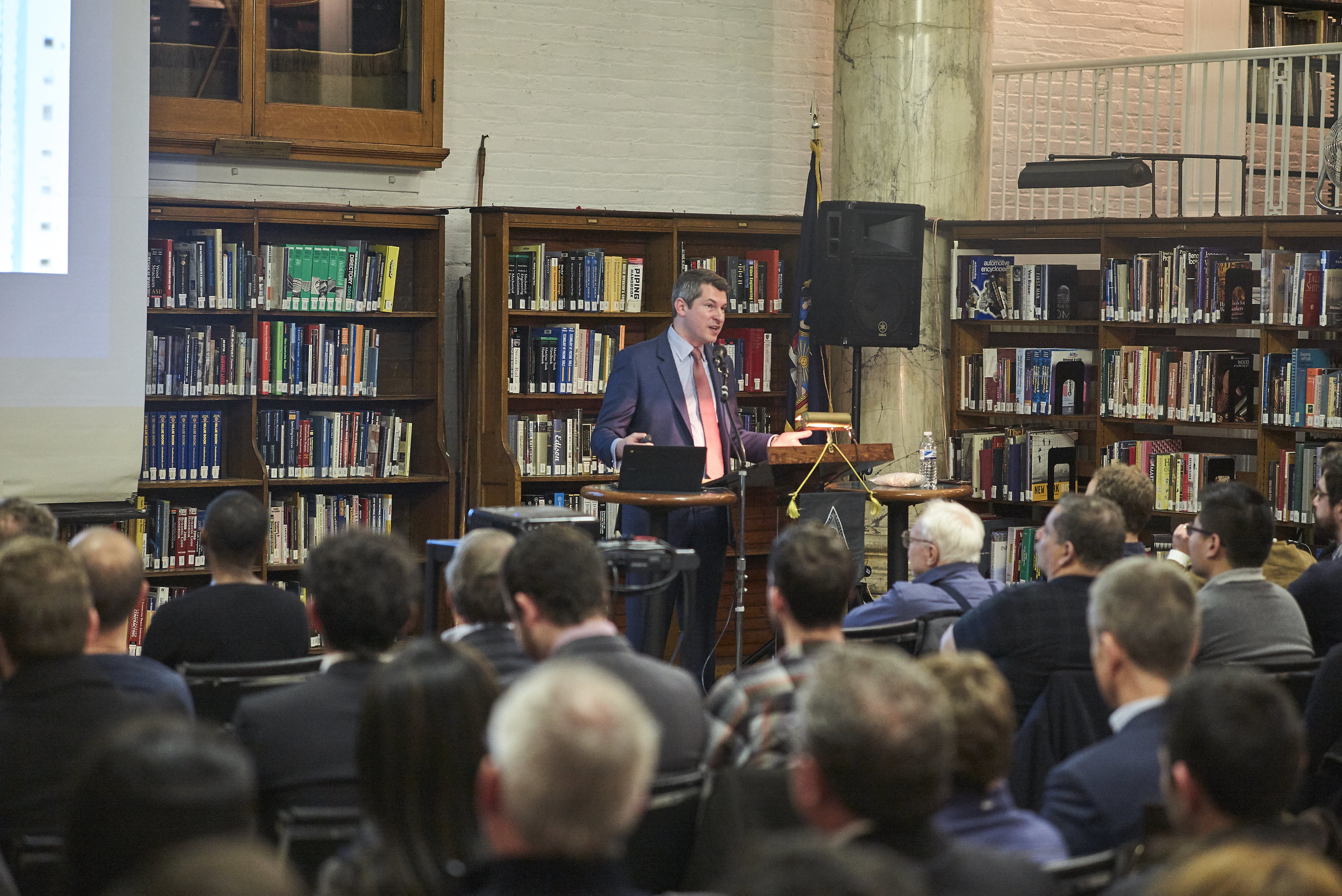
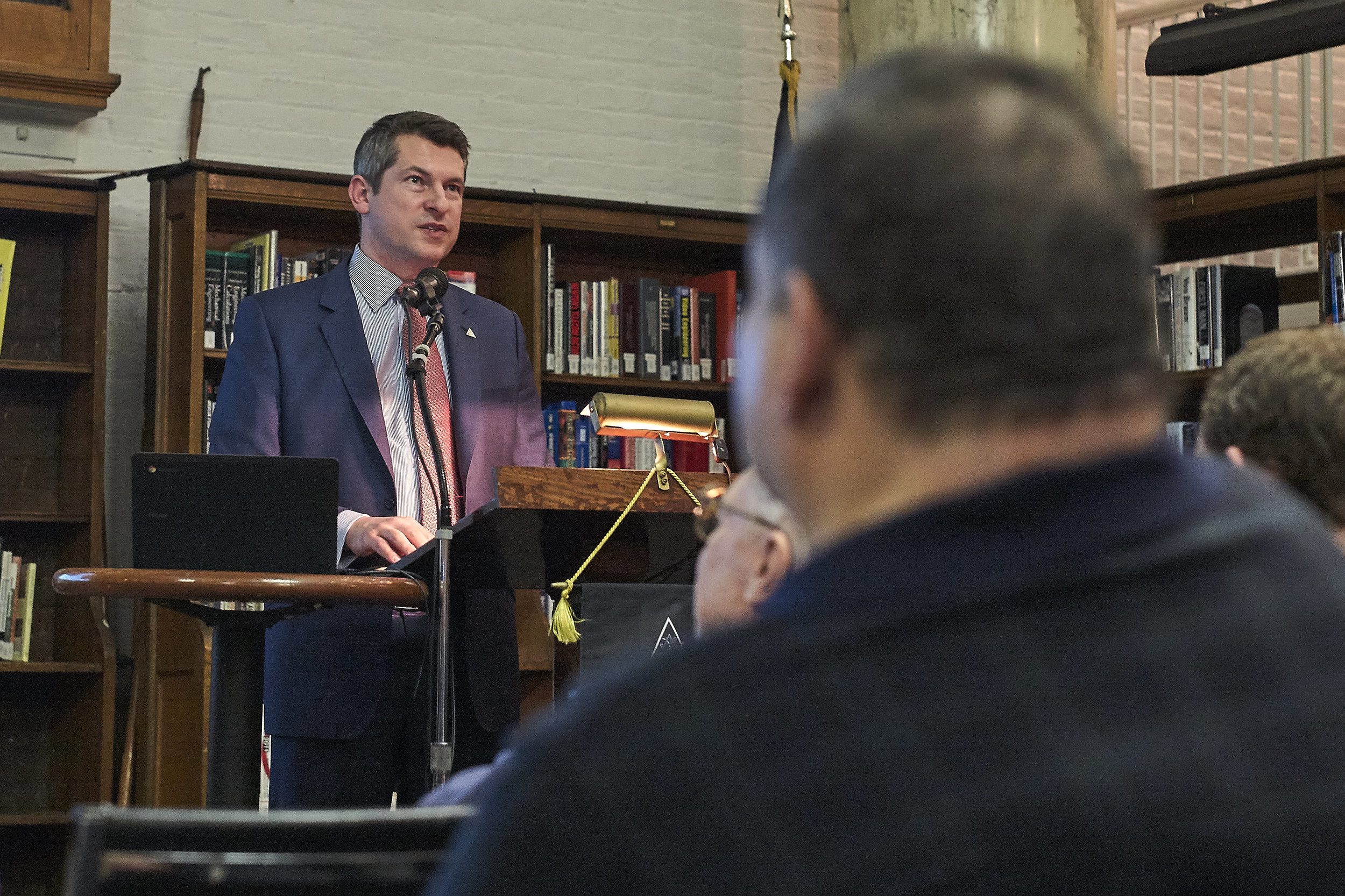

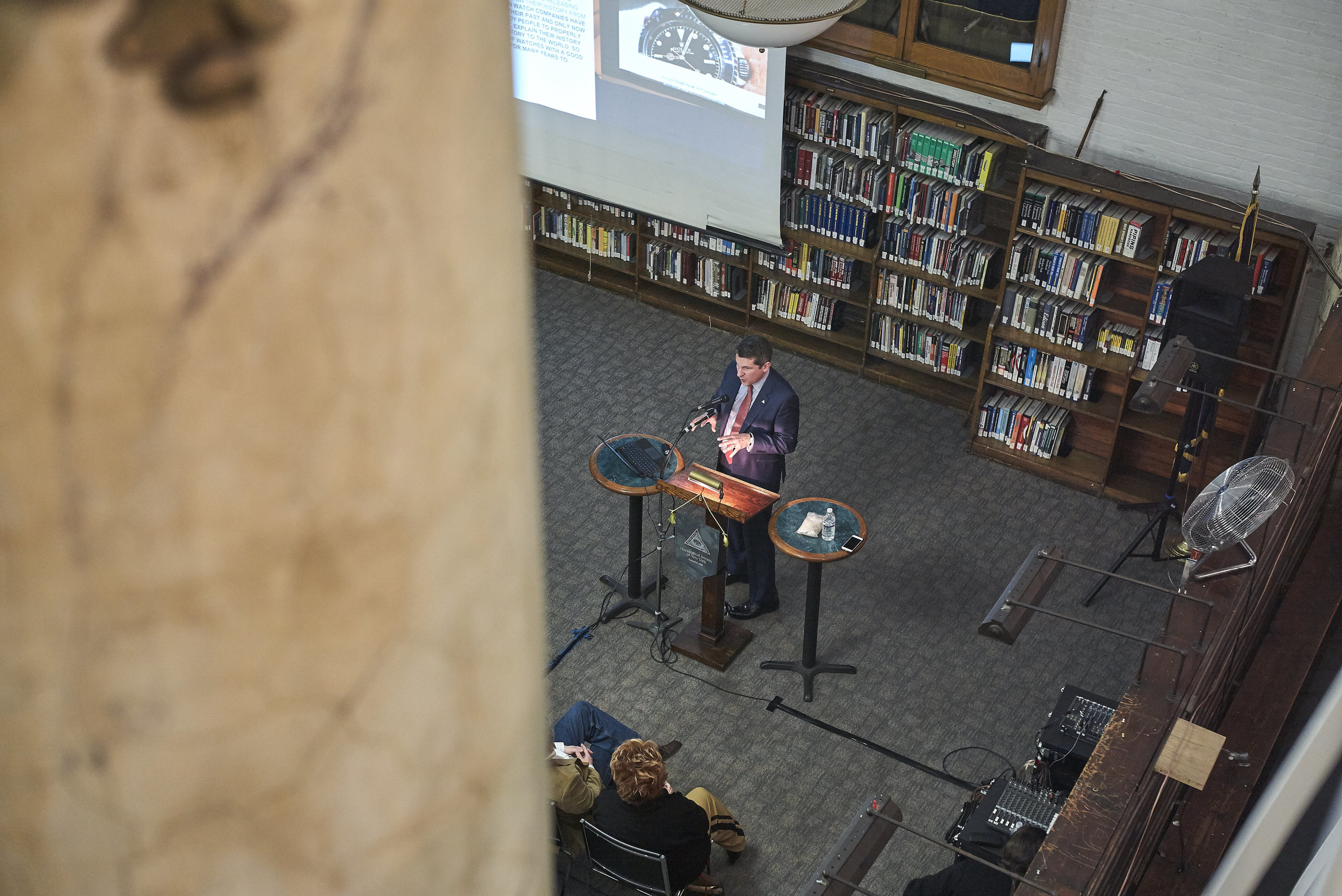
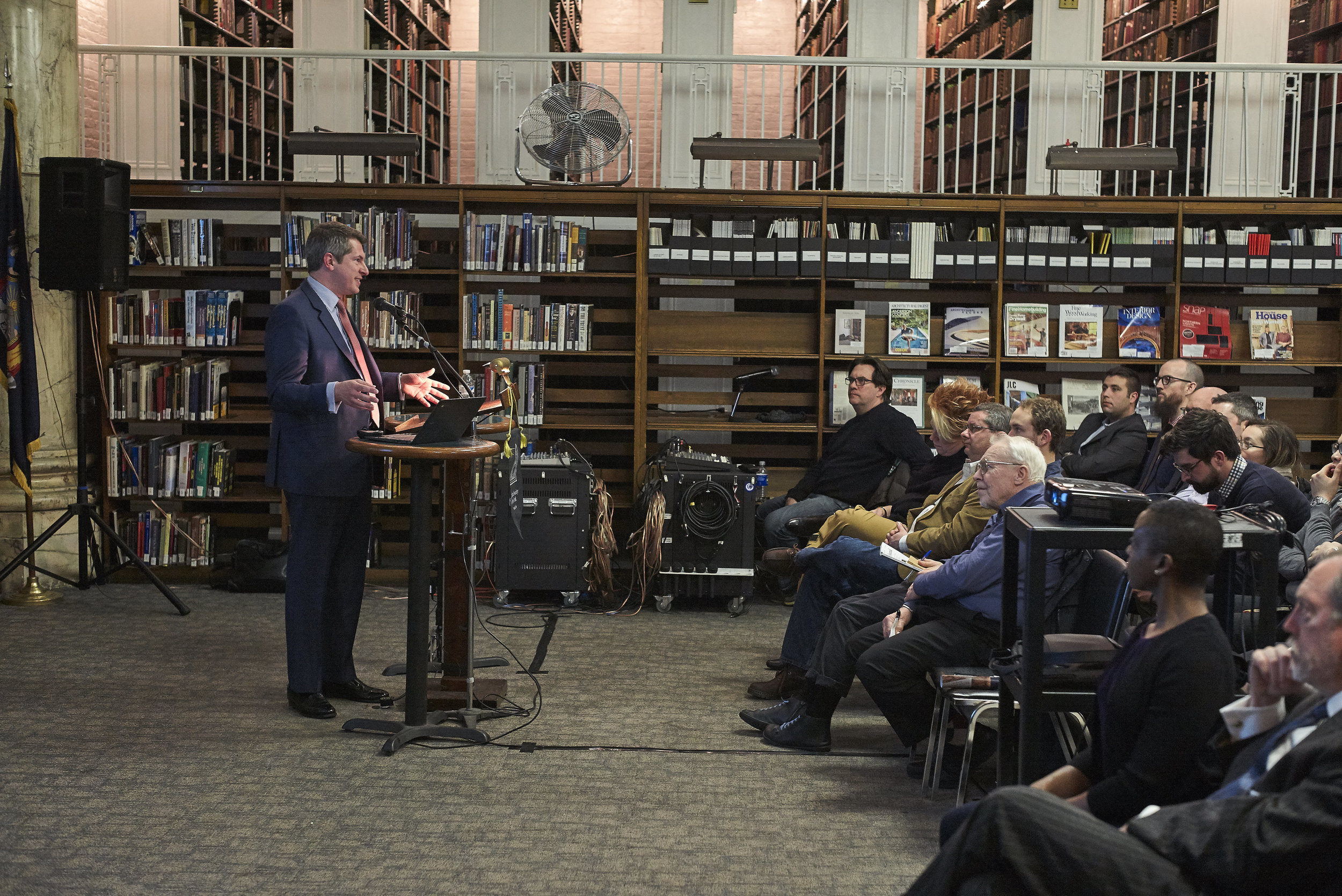
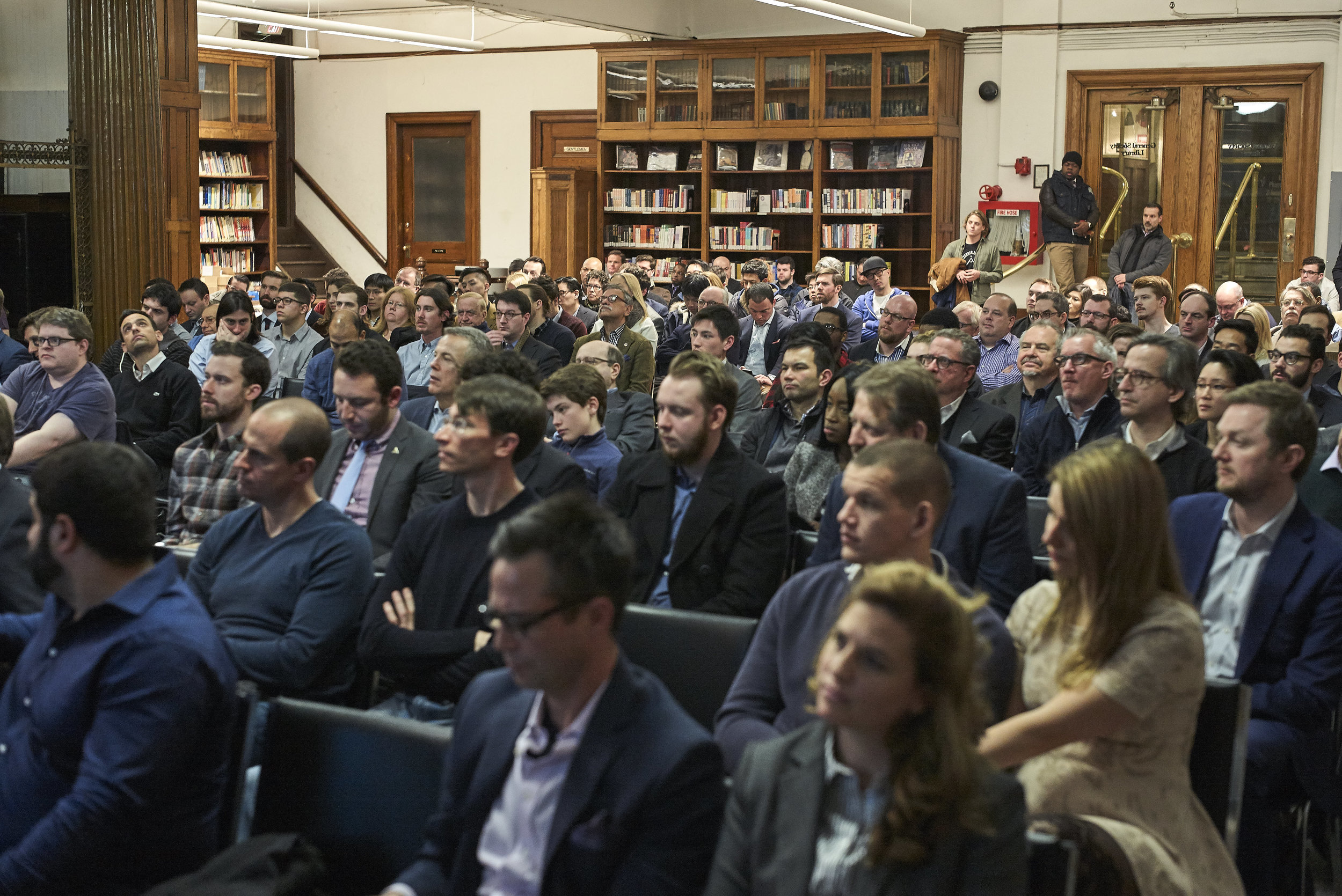
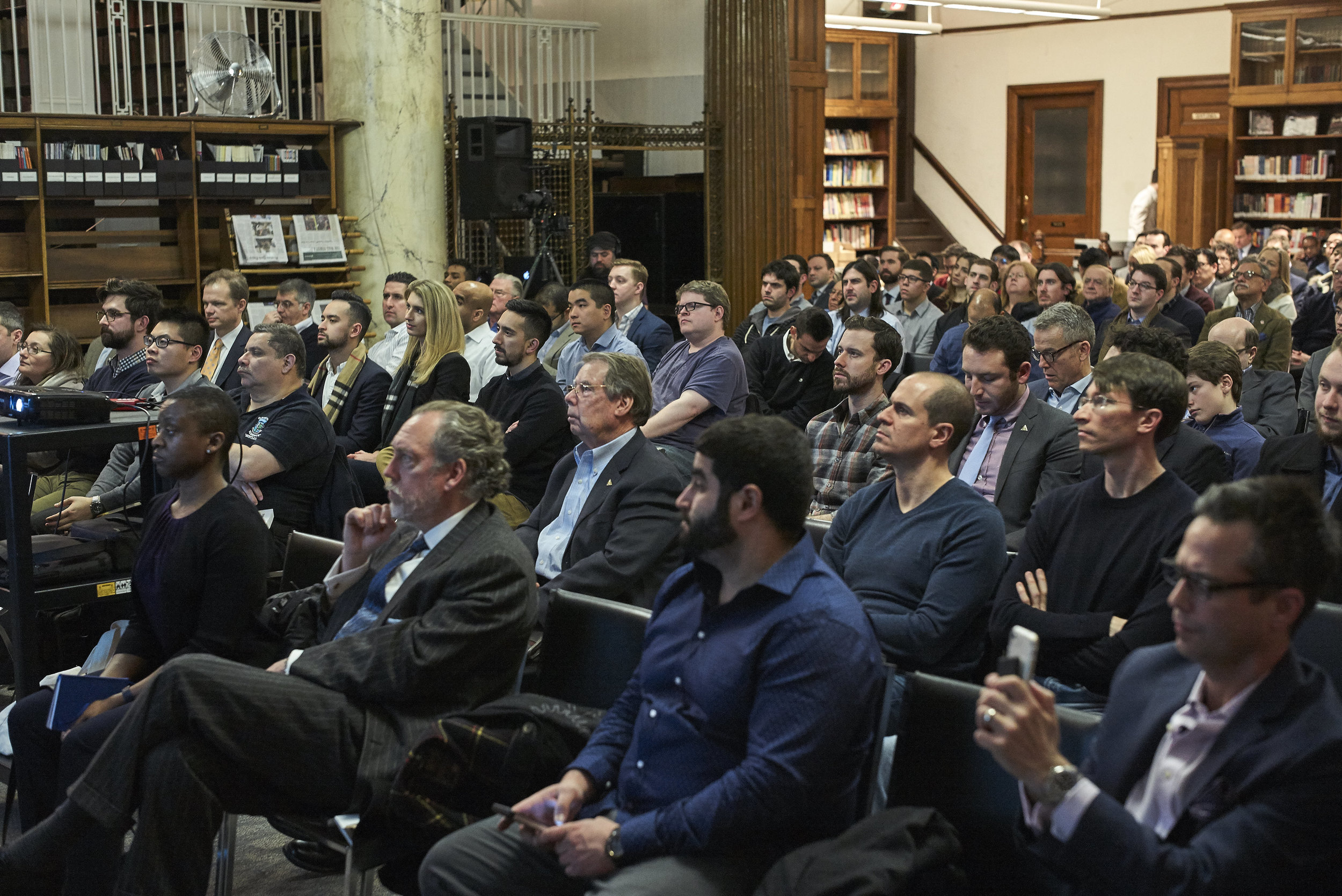
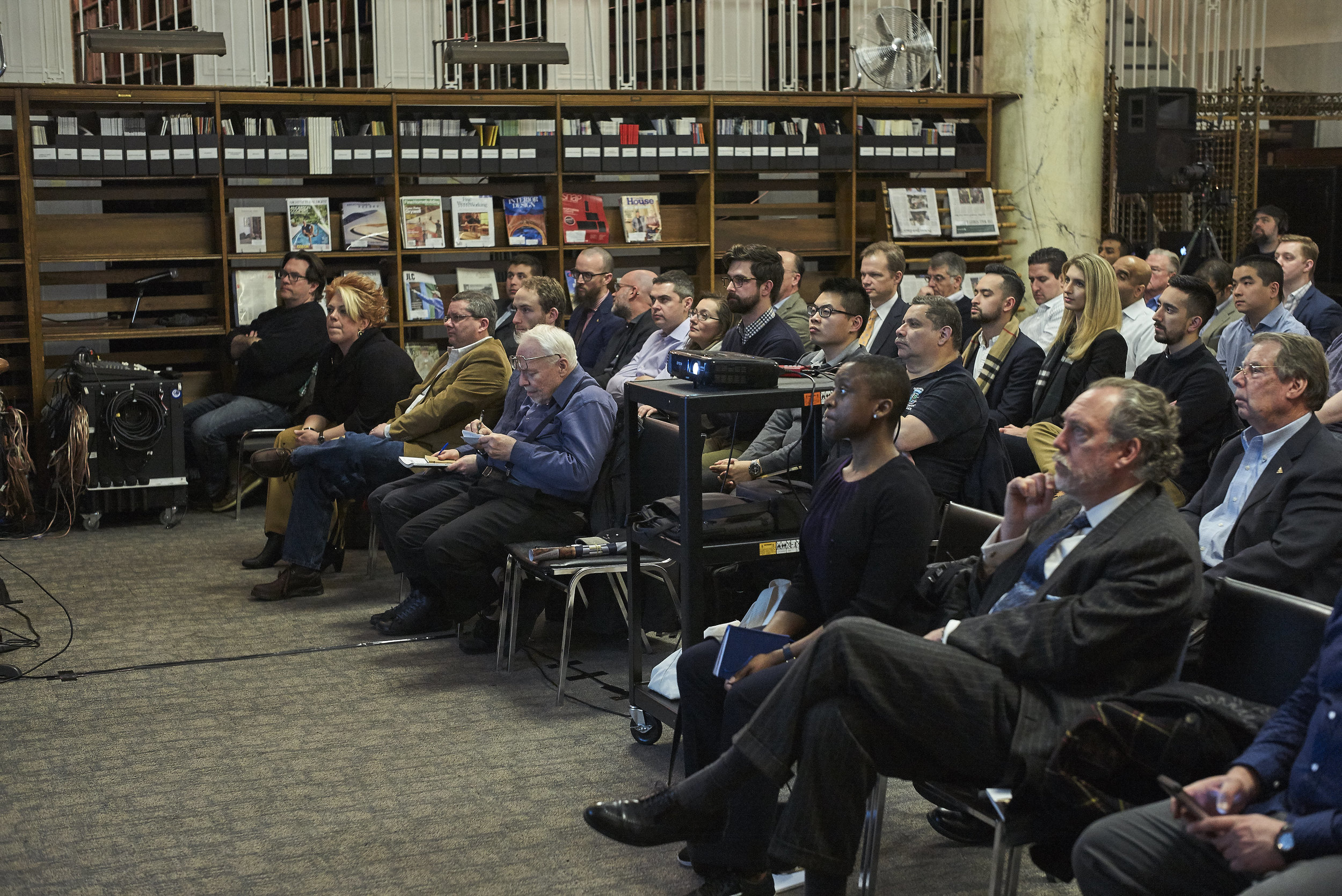
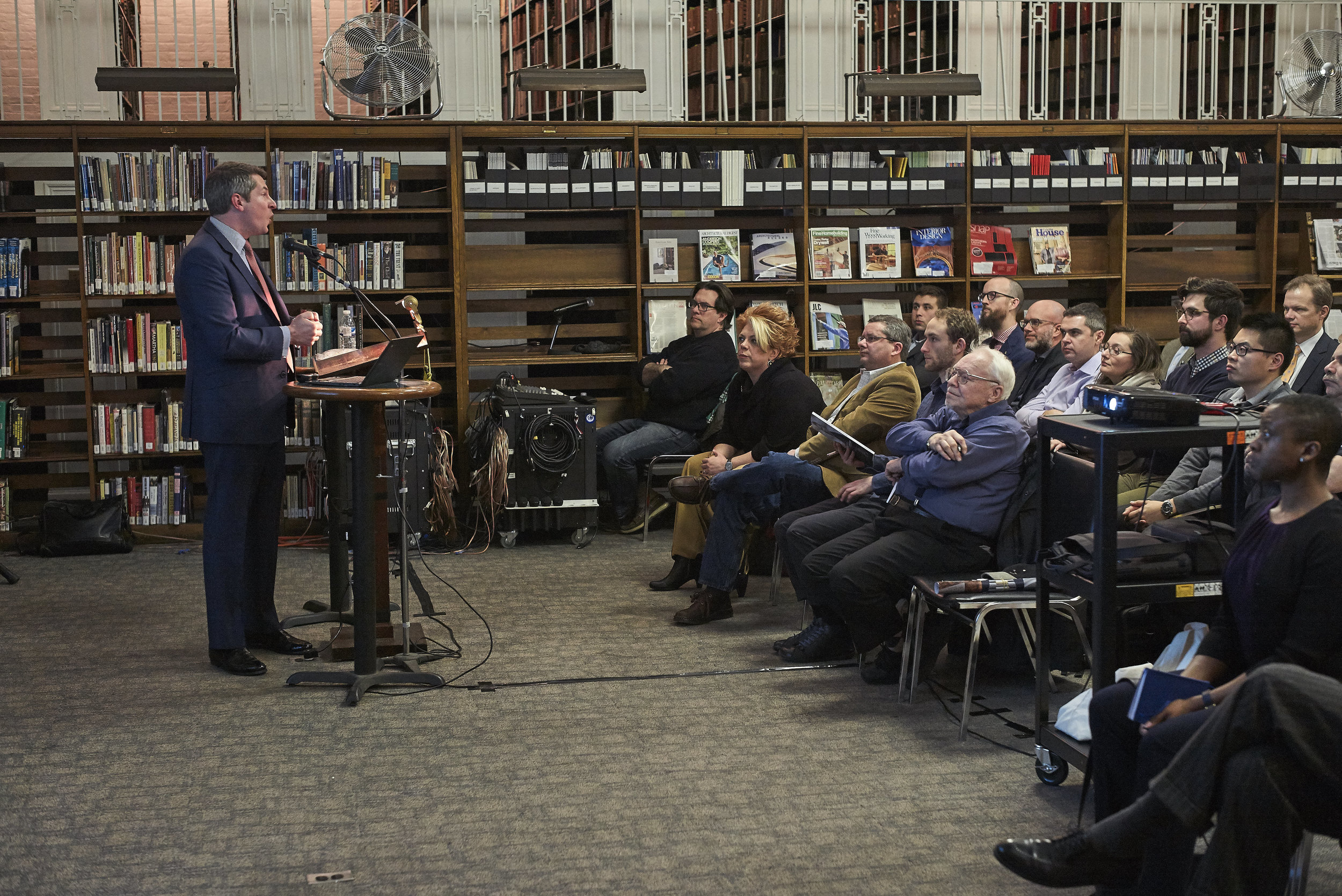
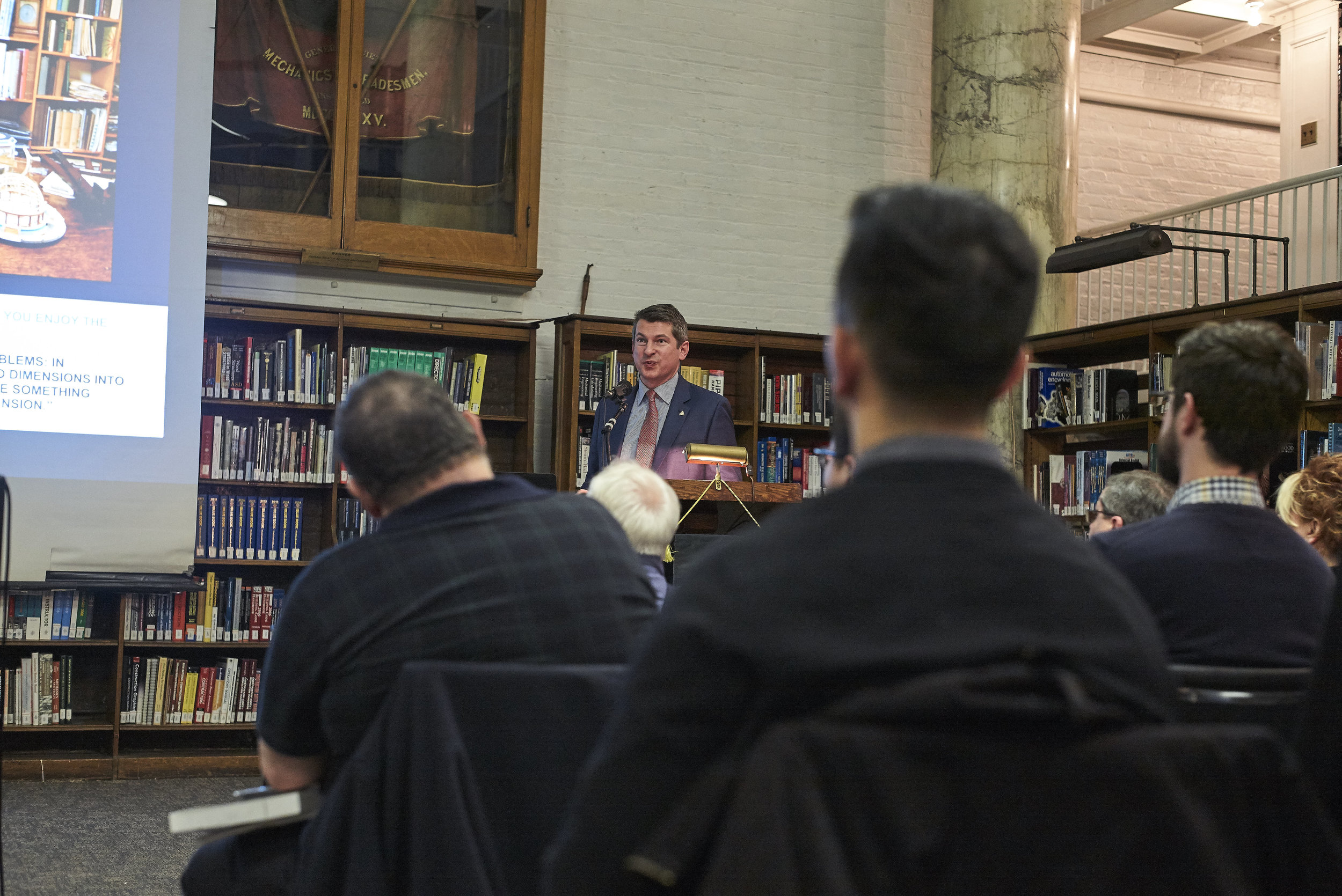
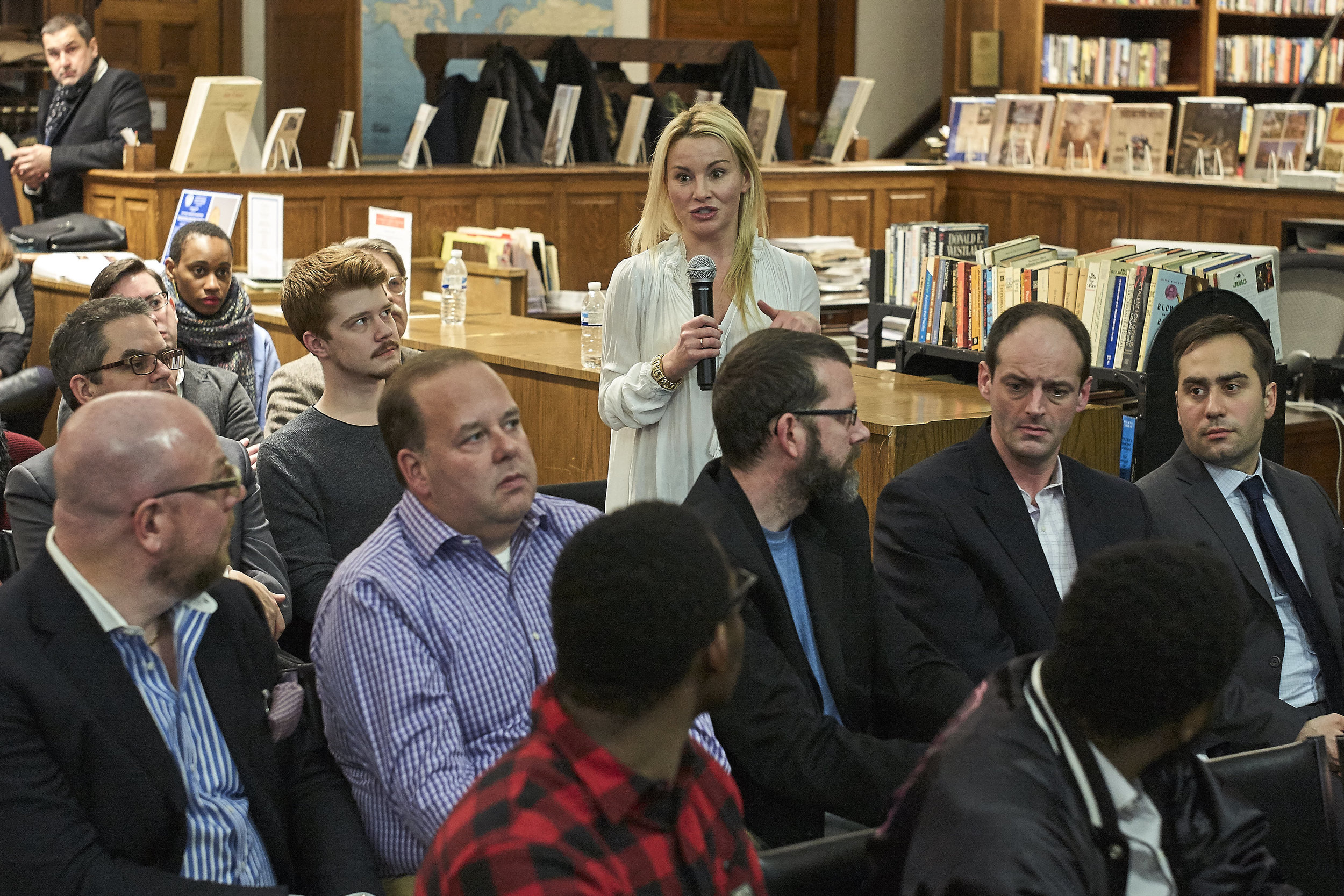
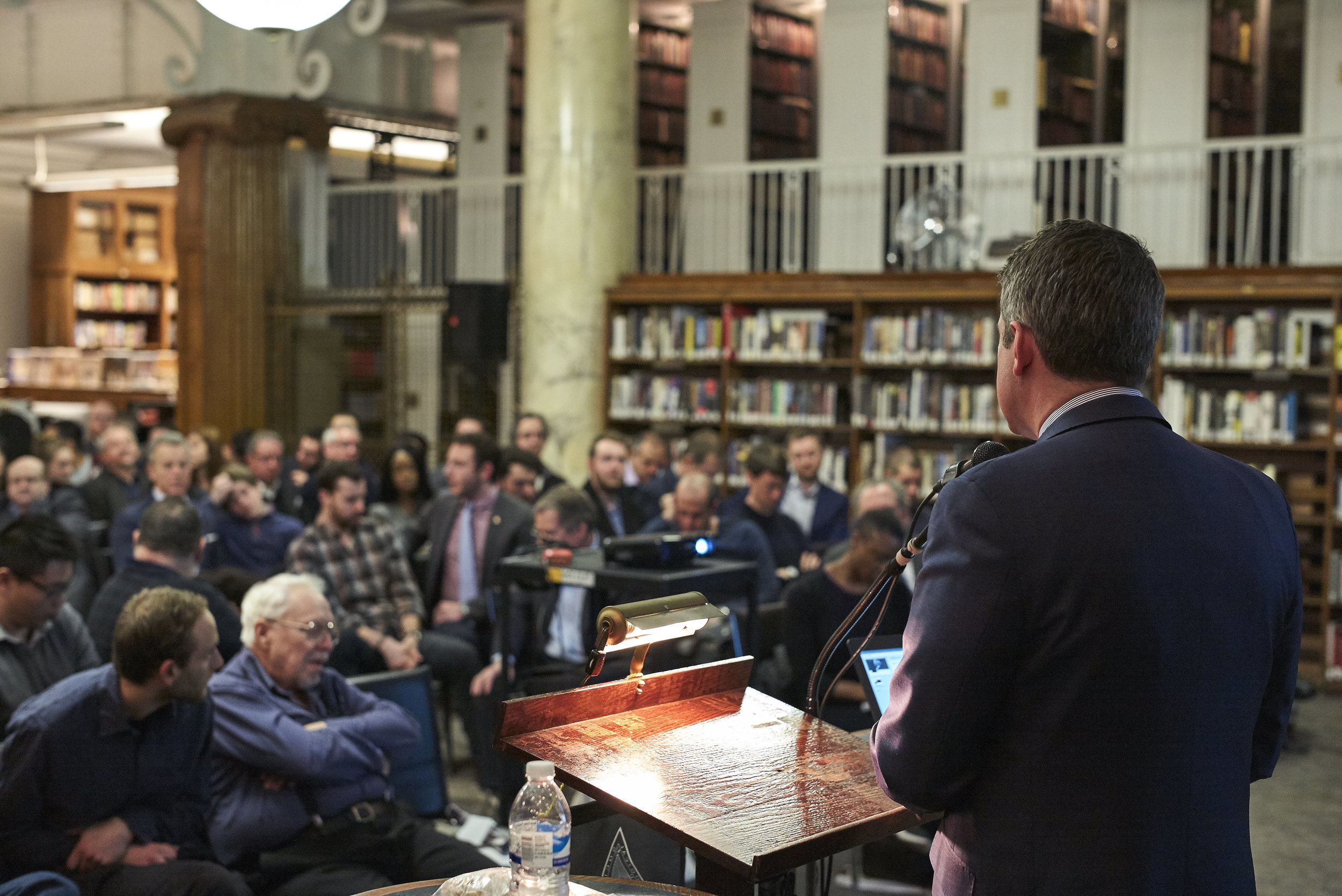


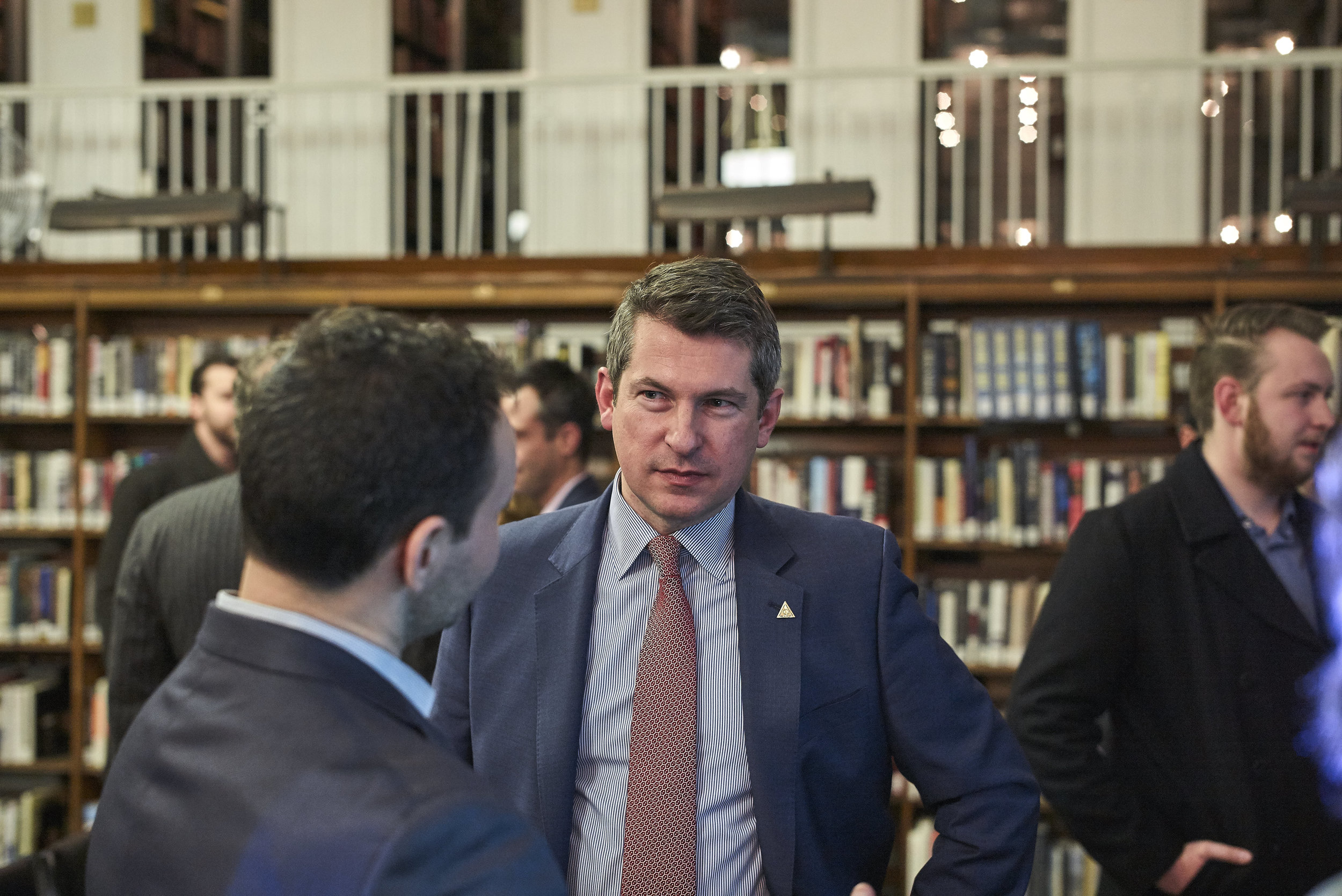
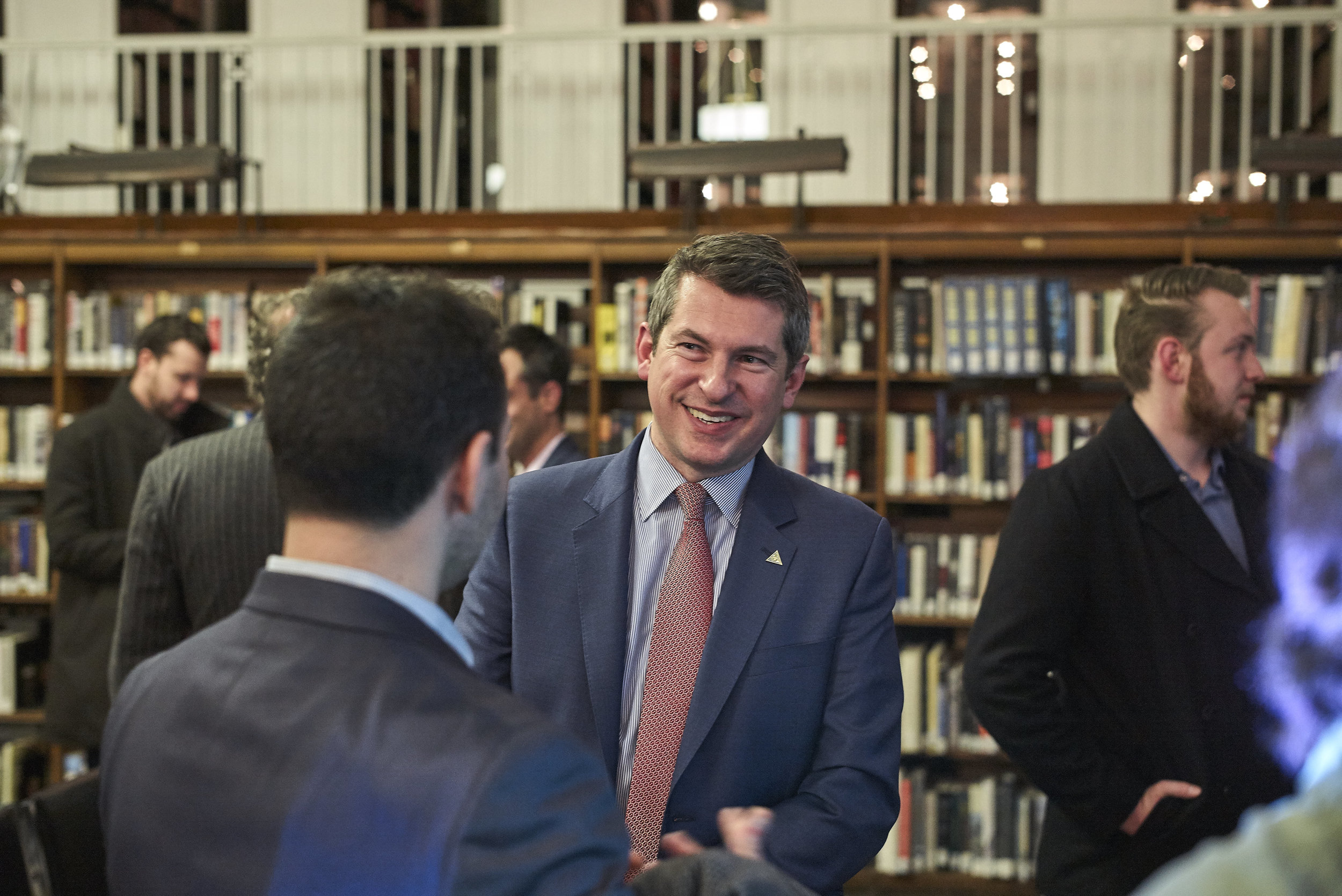
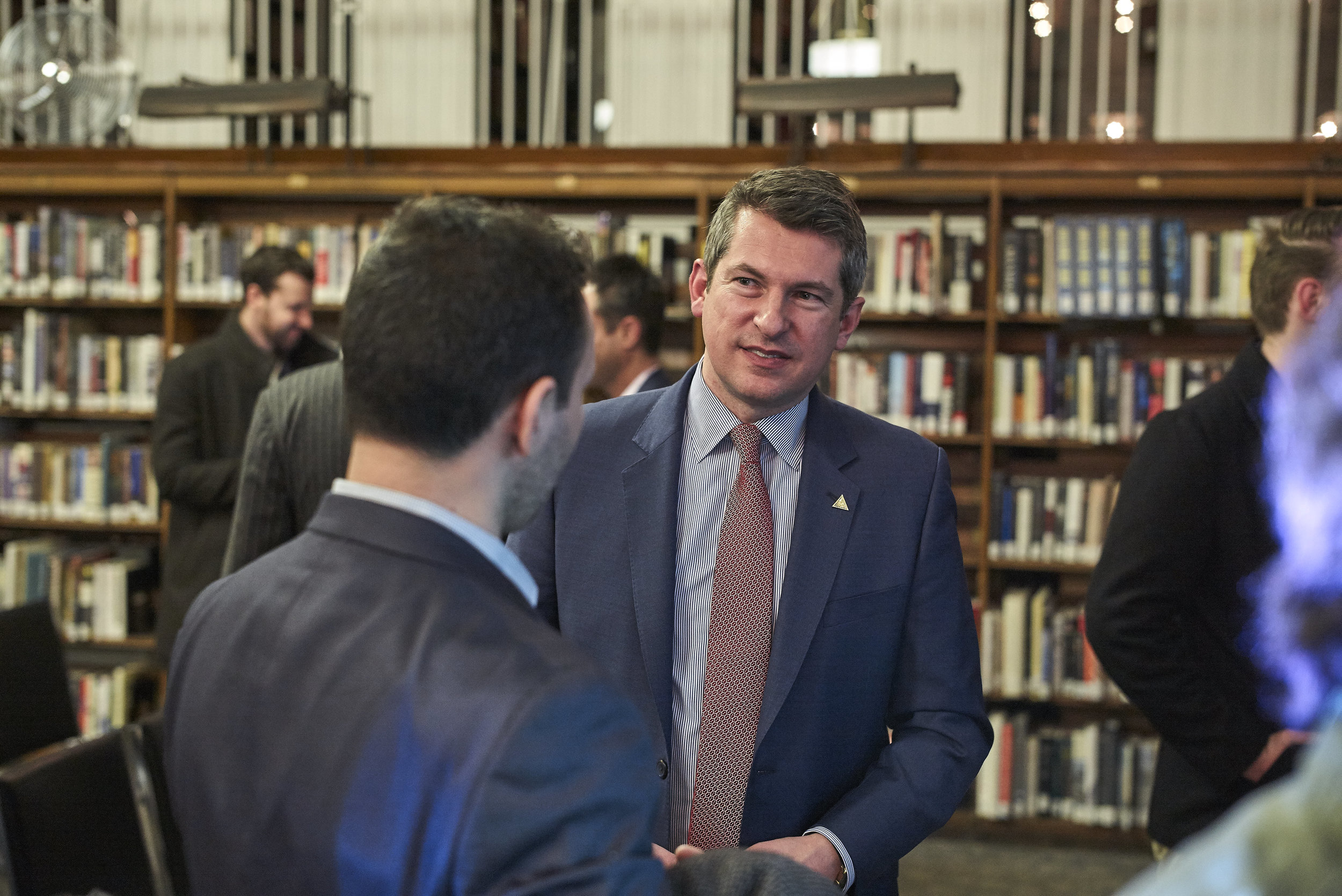
Meeting Recap: Horology in Art
Bob Frishman - Founder and Owner of Bell-Time Clocks
January 10, 2017
Video recordings of meetings are available to HSNY members.
At the January meeting of the Horological Society of New York, Bob Frishman, founder and owner of Bell-Time Clocks, delivered a captivating lecture on Horology in Art. Frishman discussed the symbolism of timepieces included in famous artwork, from classical to modern. In one example, Frishman showed the 1812 portrait of Napoleon by Jacques-Louis David, which features a clock showing the time of 4:00 AM. The early morning hour was depicted to show that Napoleon was working hard at all hours of the day. In another example, Frishman showed the 1653 Velazquez portrait of Infanta Maria Theresa to explain how timepieces were included to show the wealth or sophistication of the subject.
Frishman concluded his lecture by inviting the audience to the Horology in Art symposium that he is organizing for the National Association of Watch & Clock Collectors in October at the Boston Museum of Fine Arts. HSNY thanks Bob Frishman for his entertaining and educational lecture.
2017 Executive Committee
HSNY's Board of Directors met recently to hold elections for 2017. After serving eight years as President, Ed Hydeman resigned and nominated Nicholas Manousos as his successor. HSNY thanks Ed for his exemplary service. (Above, Ed Hydeman and Nicholas Manousos at the 150th Anniversary Gala, March 2016.)
- Ed Hydeman, who previously served as President, was elected Trustee, ex officio, and named a Fellow of the Society.
- Nicholas Manousos, who previously served as Vice President, was elected President.
- Michael Fossner, who previously served as Trustee, was elected Vice President.
- Luke Cox-Bien, who previously served as Trustee, was elected Director of Horological Studies.
- Michael Friedman and William Massena were elected Trustees.
Meeting Recap: Intertwining Roots - Watchmaking, Artisanship & Technology
Michael Friedman - Historian for Audemars Piguet
December 12, 2016
Video recordings of meetings are available to HSNY members.
At the December meeting of the Horological Society of New York, Michael Friedman, noted historian from Audemars Piguet, spoke about the origin, development and significance of watches through the ages. Friedman discussed the inventions by Huygens, Harrison, Breguet and others, which were fundamental to future developments in the field of horology. He pointed out that these fascinating objects of time were also considered works of art and highly prized by their wealthy owners who are often depicted in early portraits wearing them.
Friedman explained how the wristwatch became popular in the early 20th century, ultimately dominating the market after WWI. In the last quarter of the 20th century, the mechanical watch was threatened by electronic technology, but survived and now thrives. Today the most complicated watches, created with the help of modern technology, combine mechanical precision (based on traditional principles) with designs that rival early masterpieces. They integrate science and art. It seems that man's fascination with time and timepieces is timeless!
Our thanks to Mr. Friedman for this informative presentation.
Submitted by Walter Pangretitsch, Recording Secretary, HSNY
HSNY & AWCI Reciprocal Membership Benefits
The American Watchmakers-Clockmakers Institute (AWCI) is the national organization for watchmakers and clockmakers, of which HSNY is an affiliate chapter. HSNY & AWCI are pleased to announce reciprocal membership benefits, available now. HSNY members have digital access to the AWCI's excellent monthly magazine, Horological Times, and AWCI members have access to video recordings of HSNY's monthly lecture series. Enjoy!
Meeting Recap: Theories of Time
Dr. Demetrios Matsakis - Chief Scientist for Time Services, U.S. Naval Observatory
November 14, 2016
Video recordings of meetings are available to HSNY members.
At the November meeting of the Horological Society of New York, Dr. Demetrios Matsakis, Chief Scientist for Time Services at the U.S. Naval Observatory, lectured on the nature of time. Dr. Matsakis began with Isaac Newton's laws of motion and gravity and progressed through history to Albert Einstein's theory of relativity. The topic of causality was introduced, along with discussion on the concept of worm holes that we often see depicted in movies.
The thought-provoking lecture inspired a lively Q&A session after the lecture. While the majority of lectures at HSNY focus on mechanical timepieces, Dr. Matsakis' lecture was a refreshing change of pace that was extremely appreciated. HSNY thanks Dr. Matsakis for his illuminating and inspiring lecture.
Meeting Recap: The History of the Calendar
Hosted by François-Paul Journe, Founder, Montres F.P. Journe, Switzerland
October 24, 2016
The October 24, 2016, meeting of the Horological Society of New York had one of the largest turnouts in recent years. Members and guests came from across the country to hear François-Paul Journe, Jack Forster, Pierre Halimi Lacharlotte and Keith Lehman discuss the development of calendars and their importance in human societies from early times to the present. The first watches showing the date were made more than two centuries ago, today they have evolved into ultra-complicated timepieces.
We learned that calendars made by the Aztecs and the Babylonians have some similarity, as they are based on the number 360. This is significant because we measure time by the yearly cycle of the Earth around the sun, which is approximately the same. Calendars were important in early societies to keep track of planting seasons and religious events. Furthermore, five extra days were not counted in some primitive methods of calculating the year, similarly to leap days added in modern times.
We now realize that telling the right time involves more than just hours and minutes, we have to also consider the complication of day and date. Thanks to all the speakers for enlightening us on this topic. Special thanks to Mr. Journe and the National Watch & Clock Museum for displaying their calendar pocket watches which are rarely seen.
Submitted by Walter Pangretitsch, Recording Secretary
Photos by Atom Moore
Video recordings of meetings are available to HSNY members.
HSNY Begins Video Recording its 150-Year-Old Lecture Series
Since 1866, the Horological Society of New York's (HSNY) monthly meetings have featured watchmakers, clockmakers, historians and scientists all lecturing on horological topics of interest. In recent years, HSNY featured guests such as Roger Smith, François-Paul Journe, Kari Voutilainen, Rory McEvoy (Curator of Horology at the Royal Observatory, Greenwich, UK), and HODINKEE's Benjamin Clymer. Traditionally these meetings have never been recorded, you had to be there in person. Today that changes; HSNY is bringing its world-class lecture series to the world.
HSNY's first video recorded meeting, The History of the Calendar, hosted by François-Paul Journe, is now online. Video recordings are available as a benefit to HSNY members. The video below is a preview clip.



